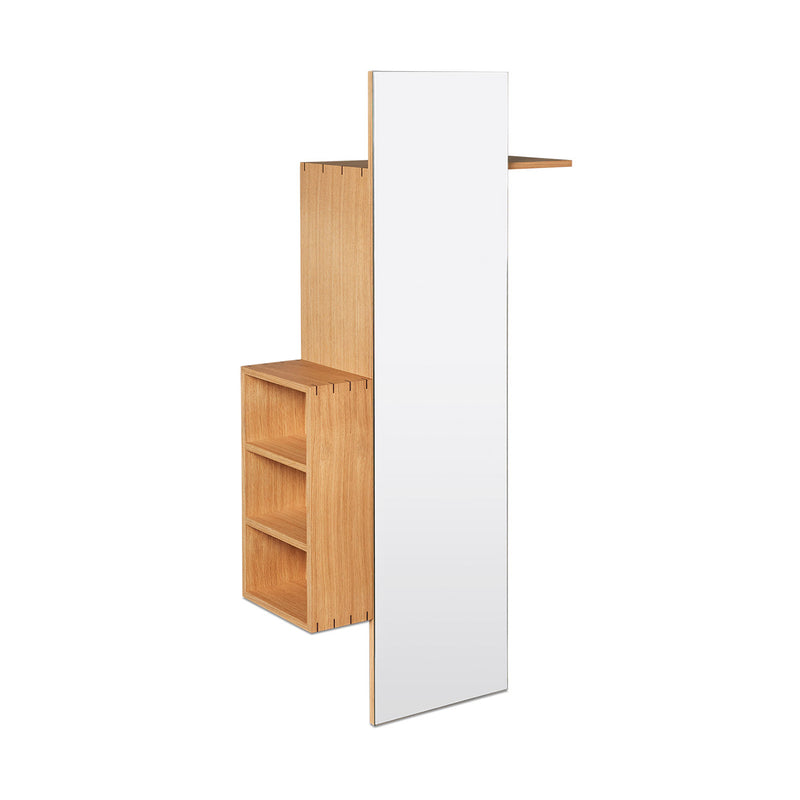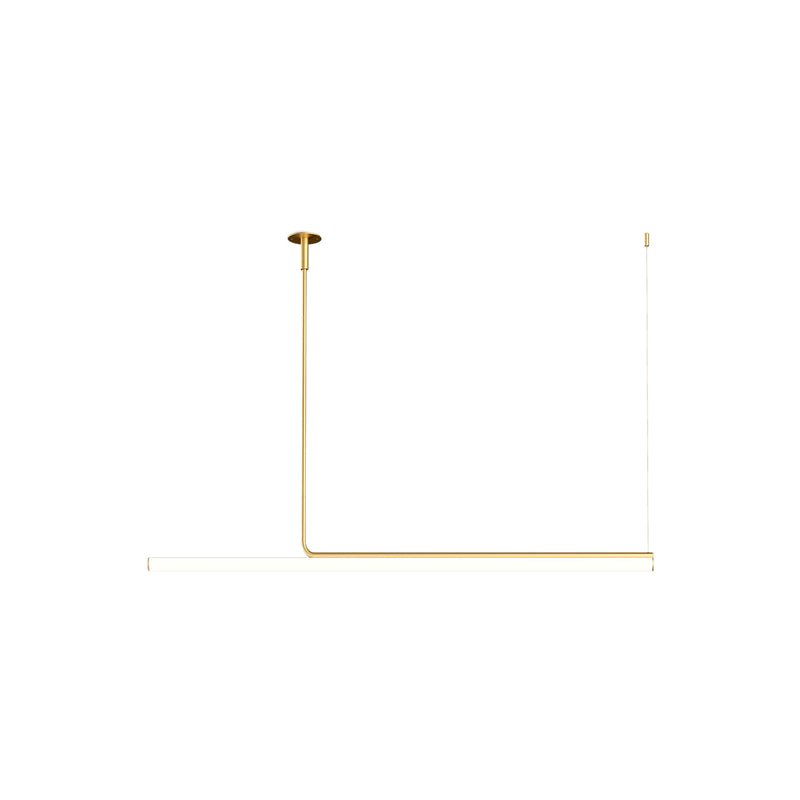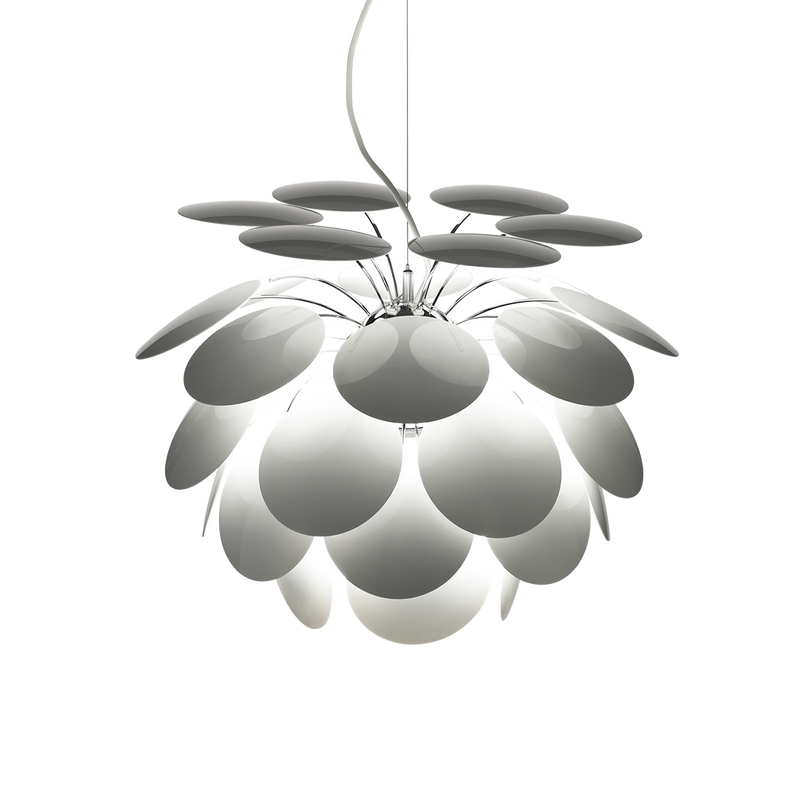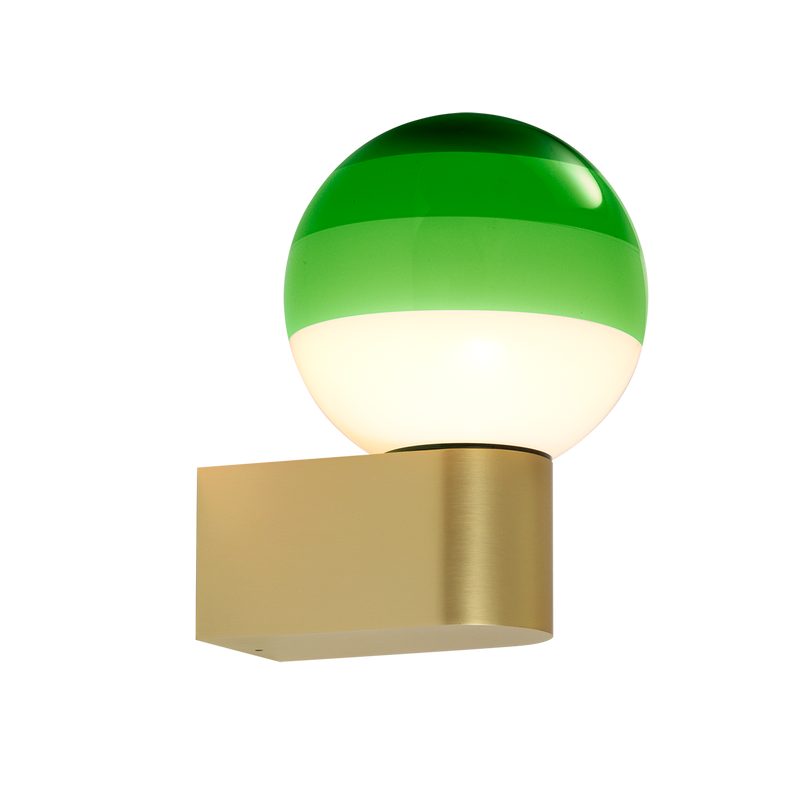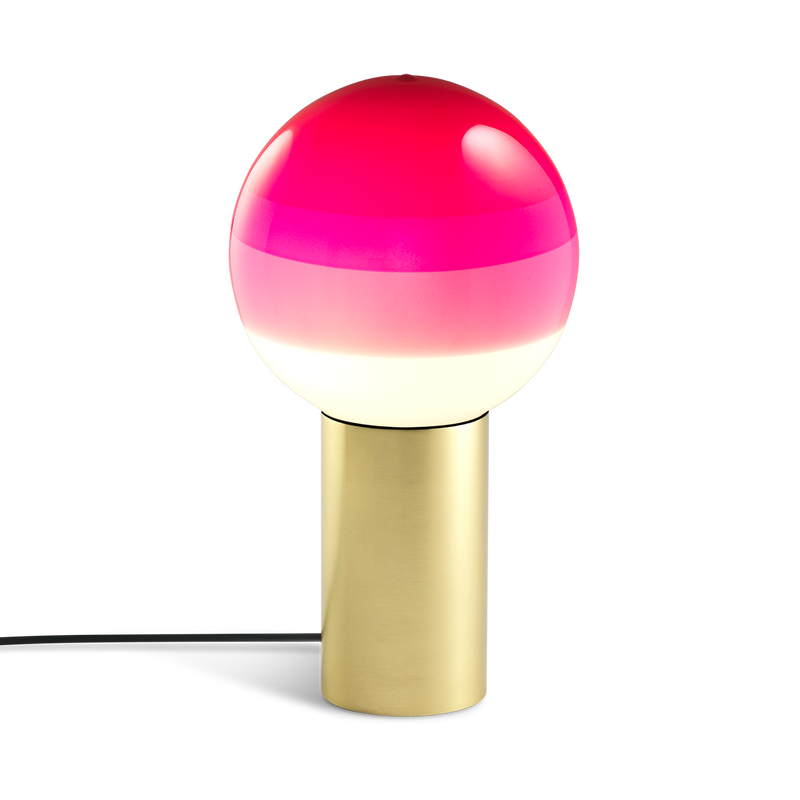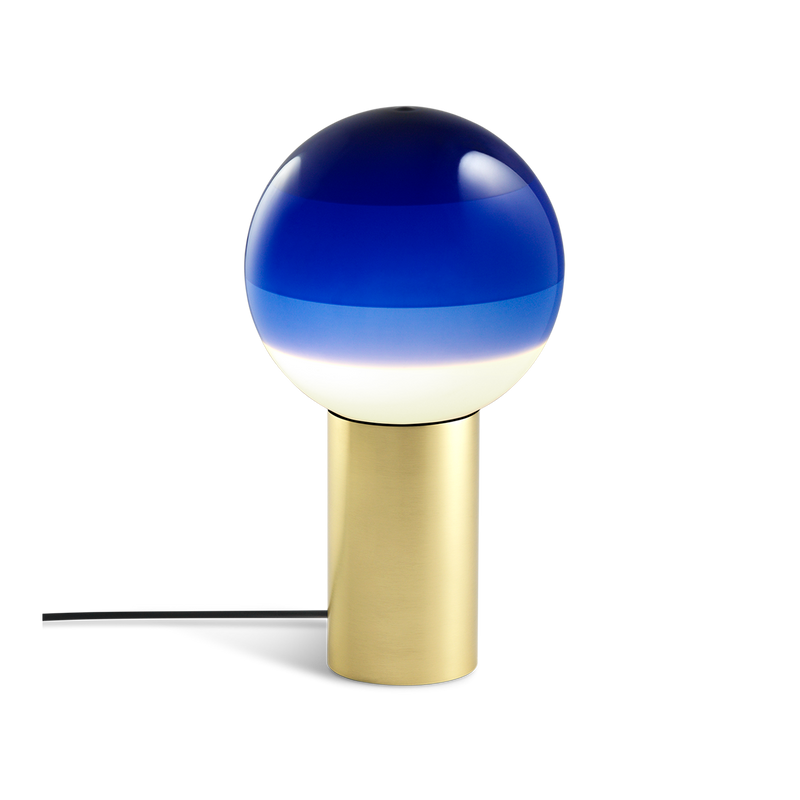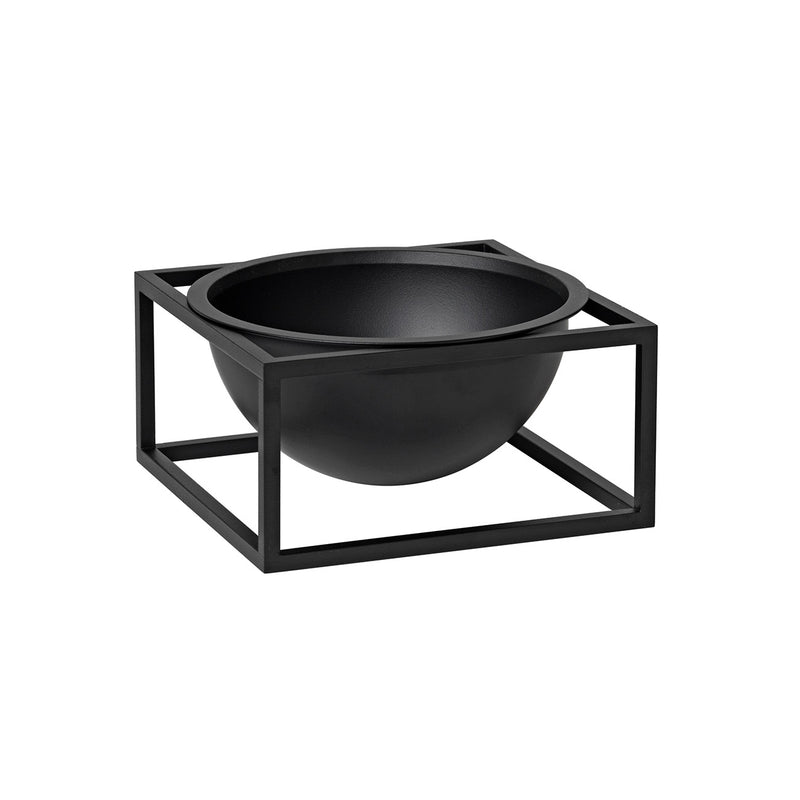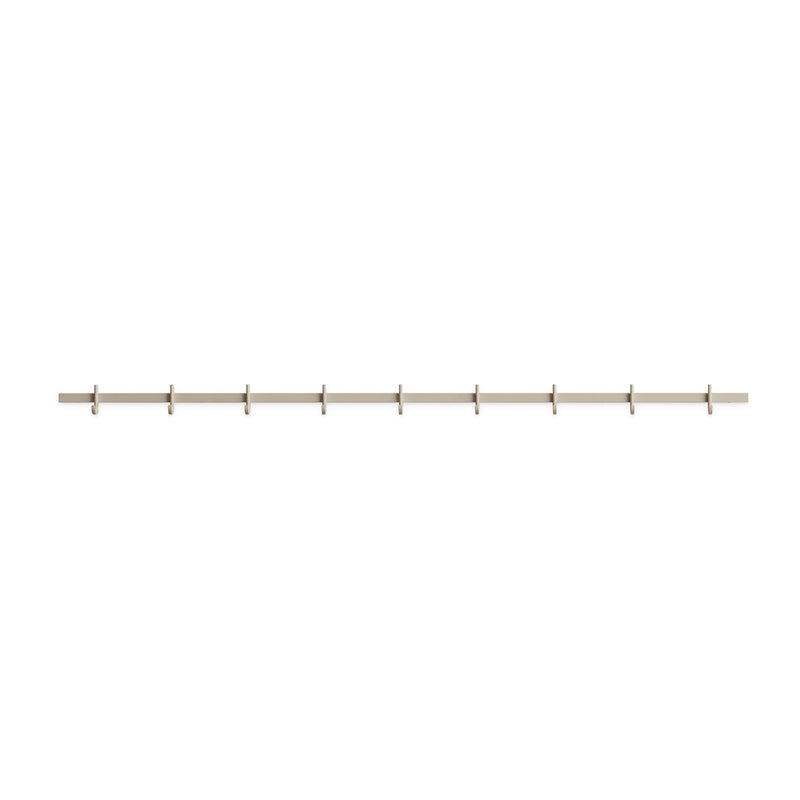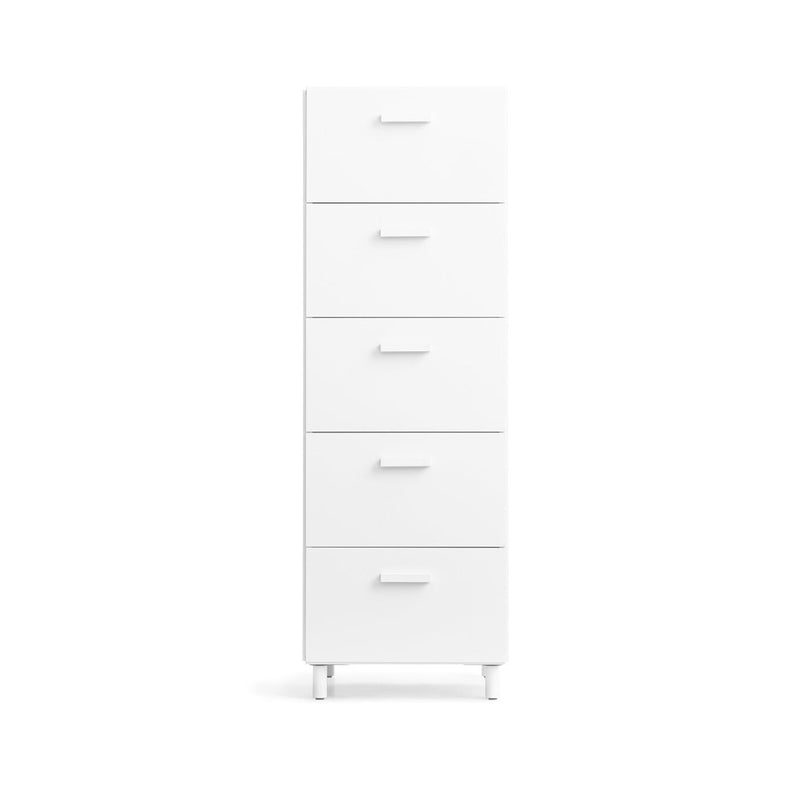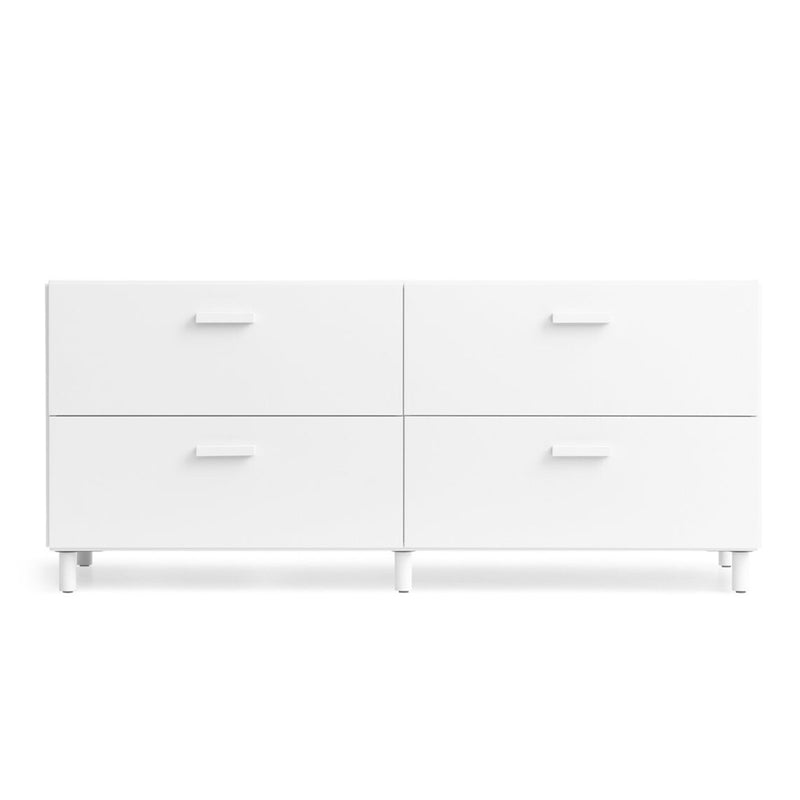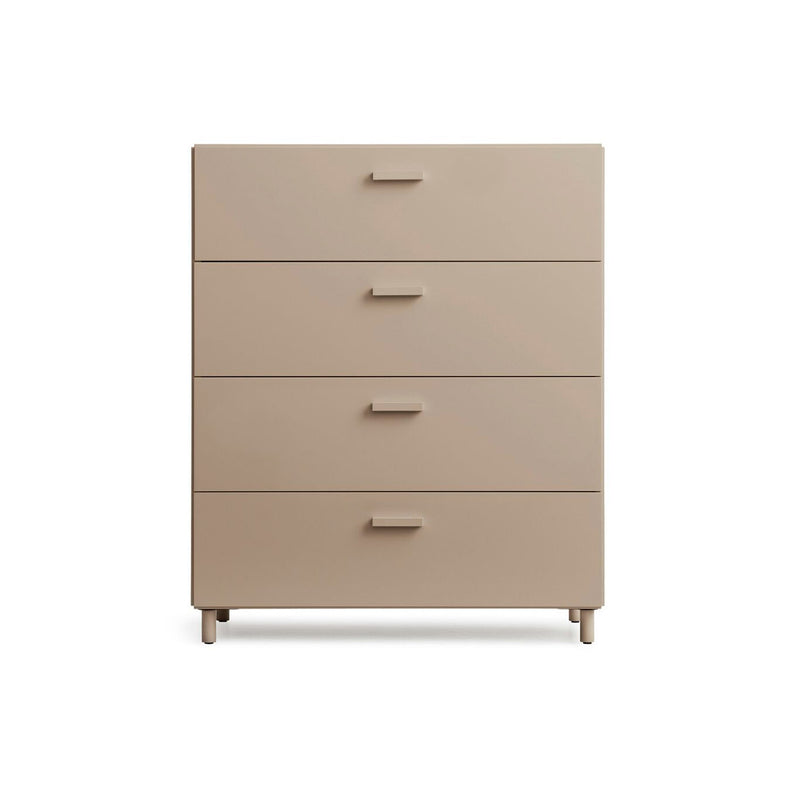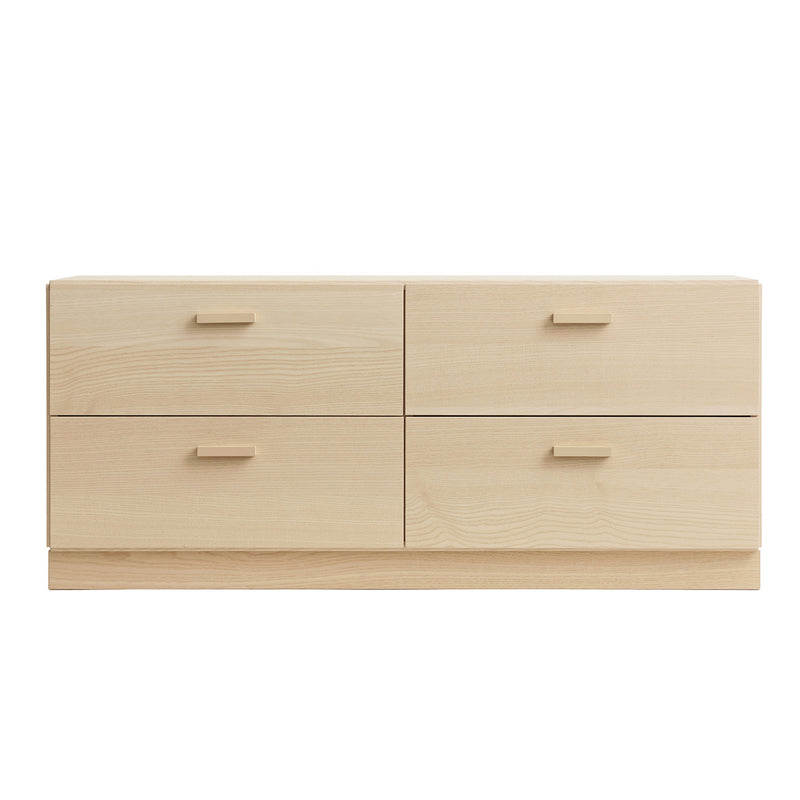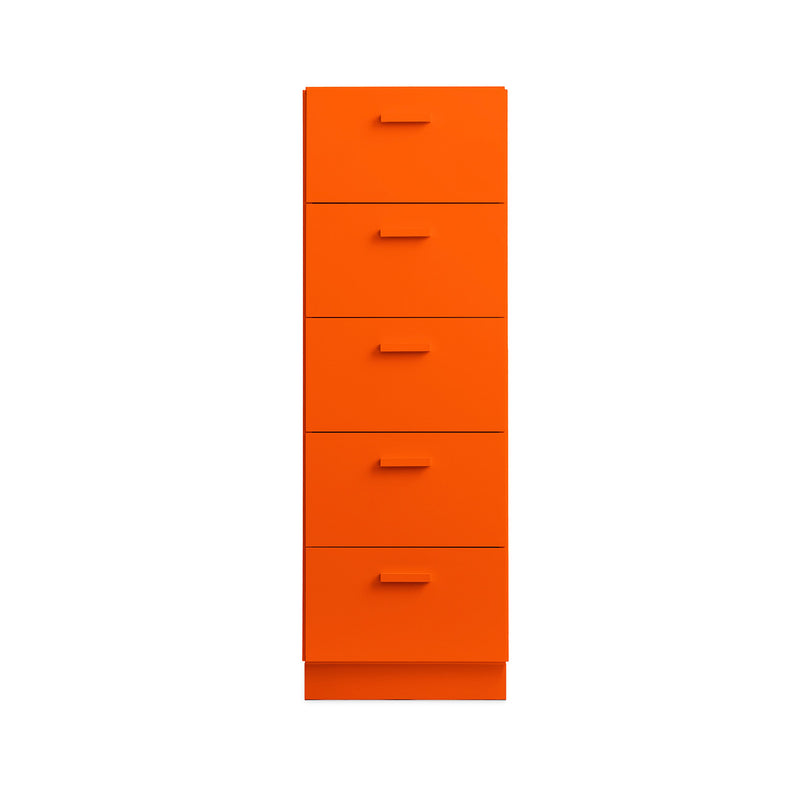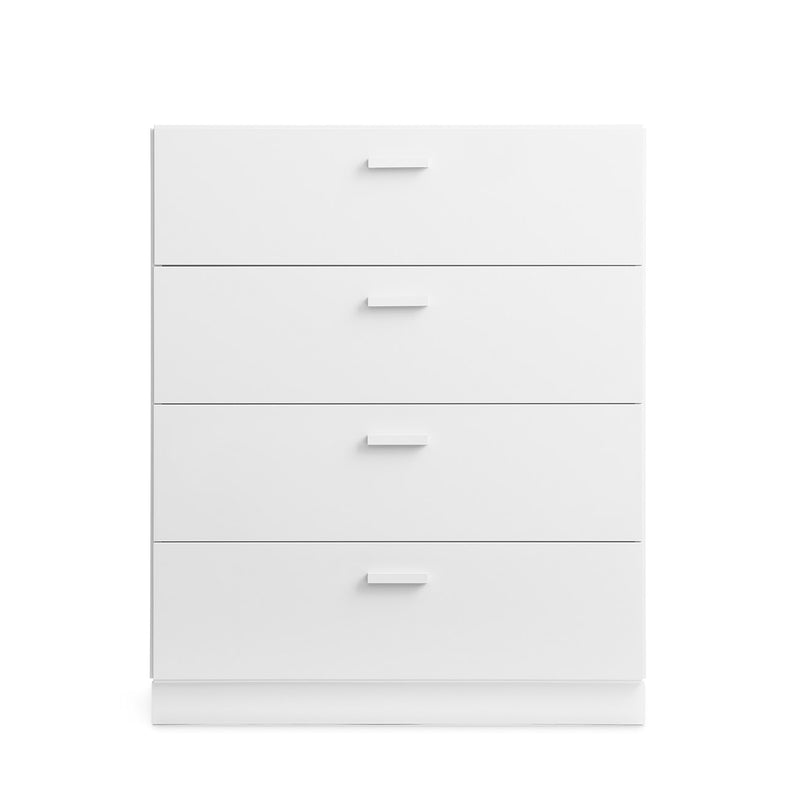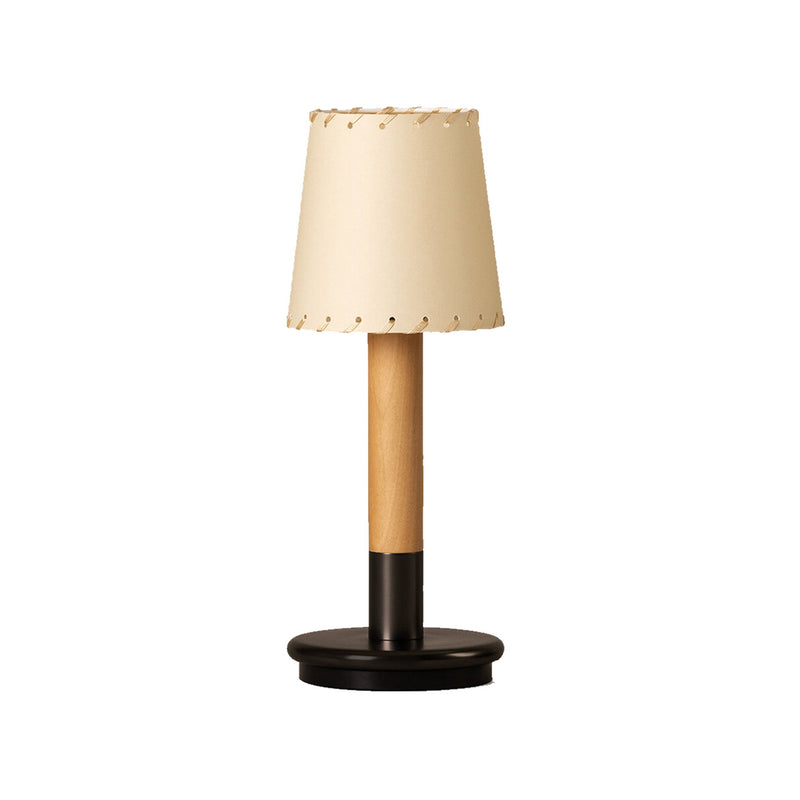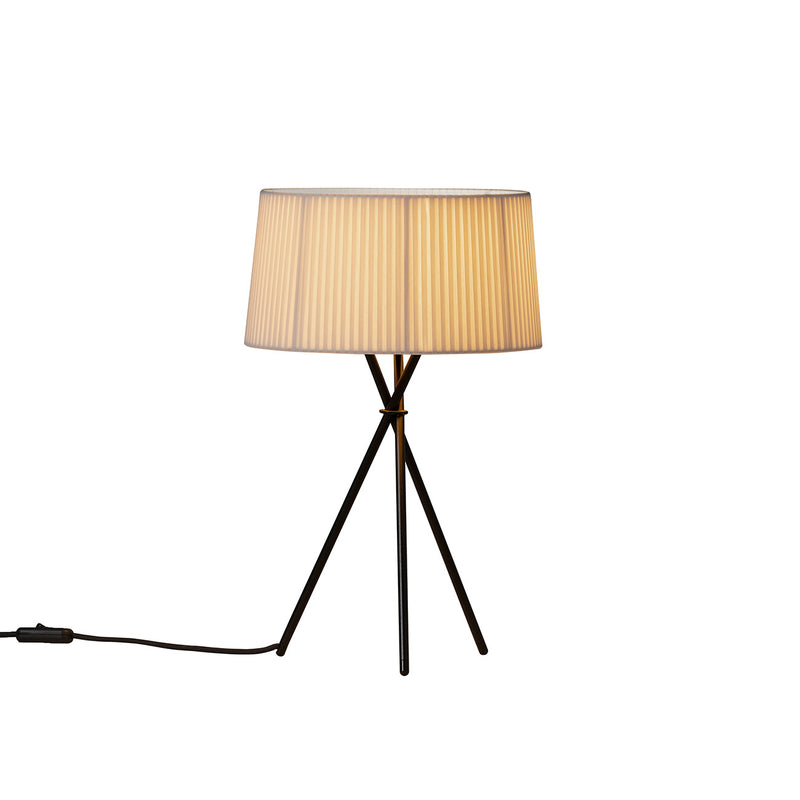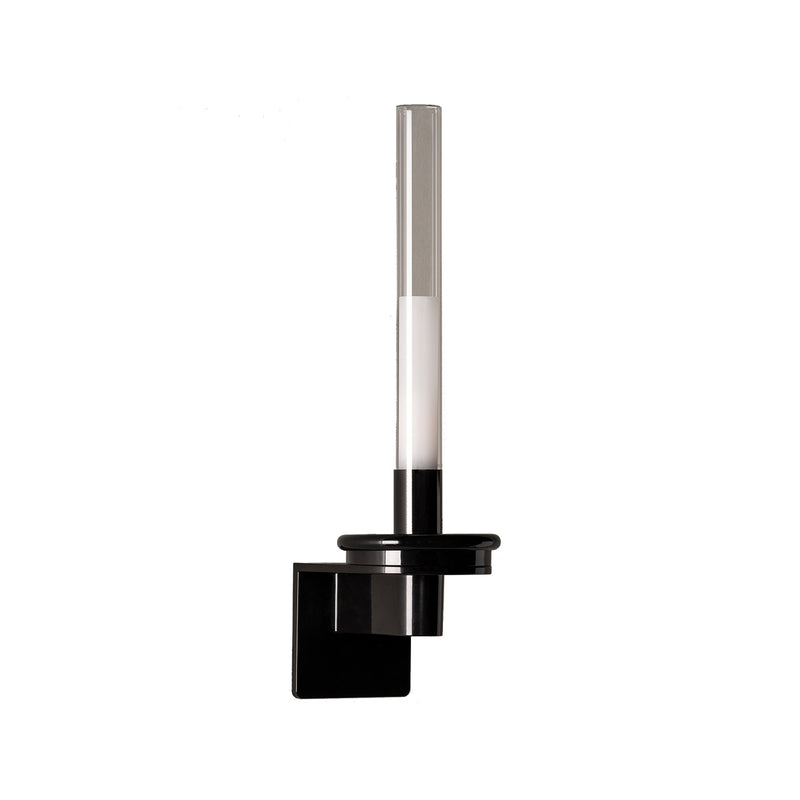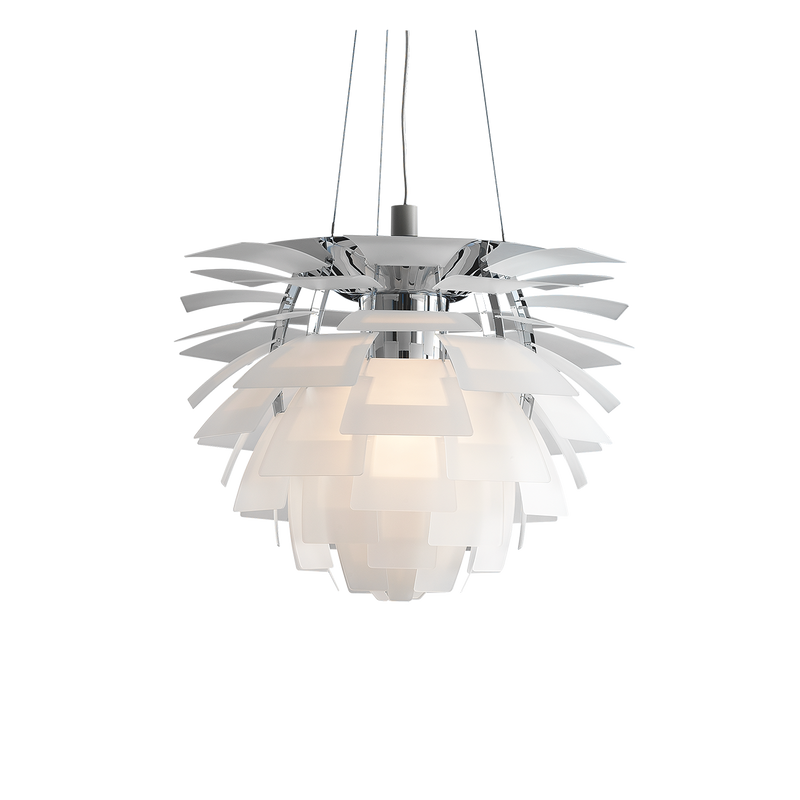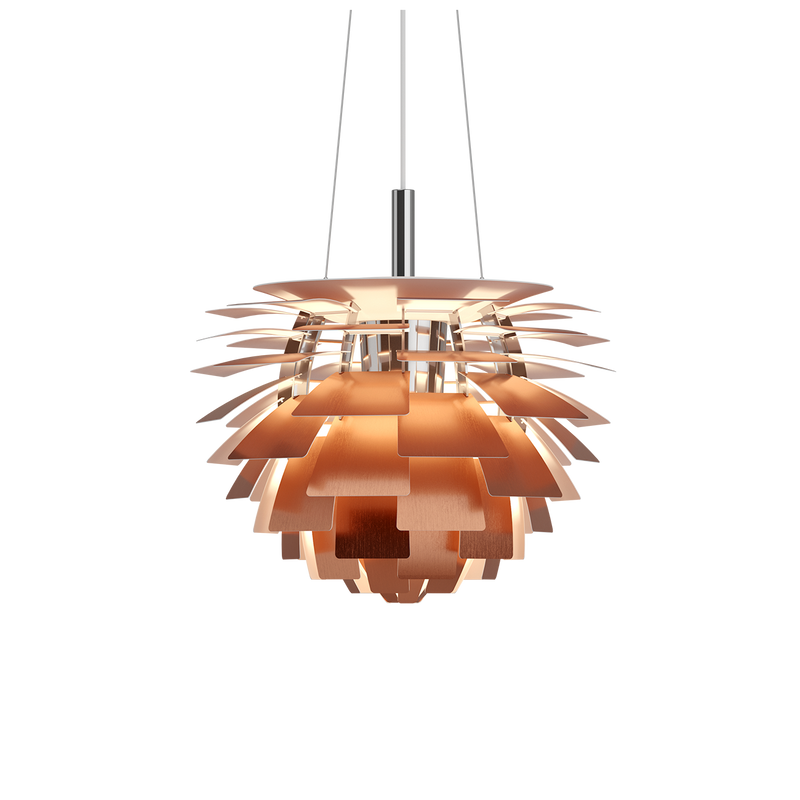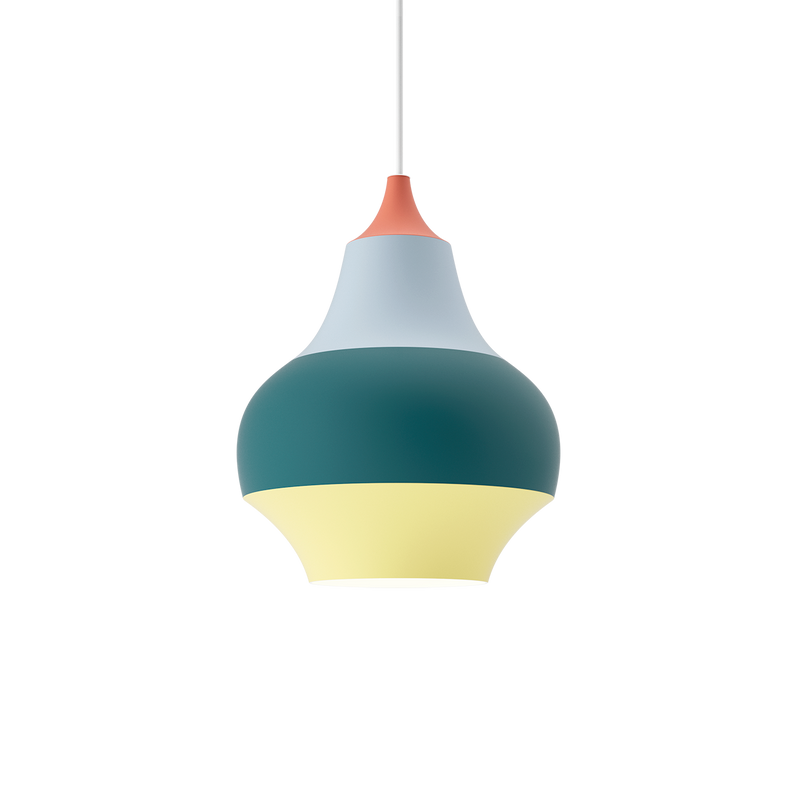Environments
Discover our products in a real-life context and find the inspiration you need.
Immerse yourself in a unique experience where you can explore our designer products in a real-life setting. Visualize how they fit into your home and discover their versatility. Be inspired by the different options and find the furniture that best suits your tastes and needs.
Explore, imagine and create your ideal home.
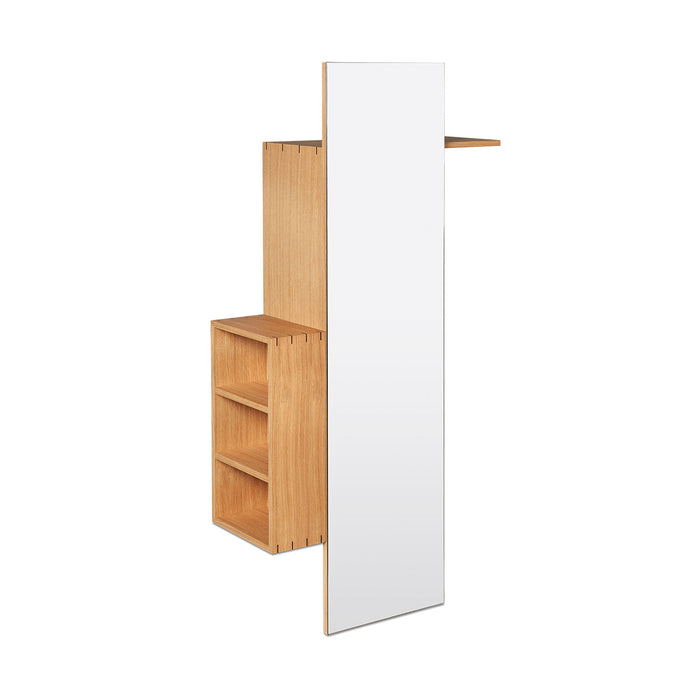

Bon Hallway
The Bon Hallway hall table is the perfect solution for those seeking elegance and practicality in a single piece of furniture. Its minimalist design, inspired by Japanese and Scandinavian aesthetics, blends seamlessly into any space, whether it's an entryway, hallway, or bedroom.
With Bon Hallway, you can keep your home organized and clutter-free. It features a top shelf ideal for displaying decorative items, a coat rack for coats and handbags, a mirror for a last-minute check before heading out, and handy narrow shelves on the side for storing keys, gloves, and other small items.
Made with the highest quality materials, the Bon Hallway is FSC™ certified and made with oak veneer and an MDF core. Exceptional craftsmanship and contrasting corner details add a touch of sophistication that won't go unnoticed.
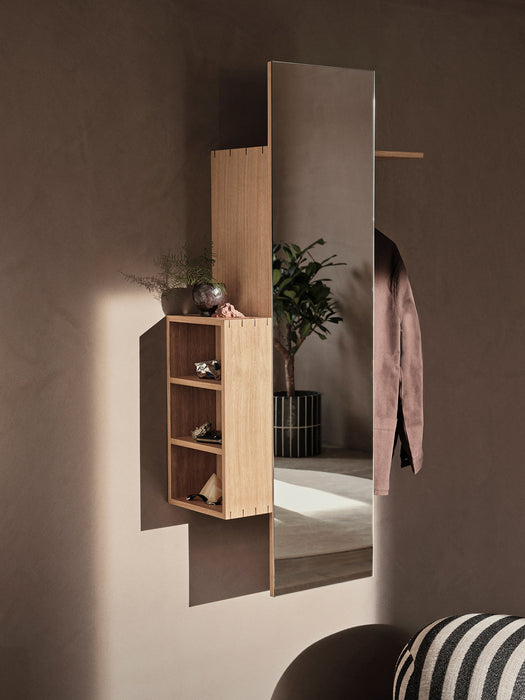

Bon Hallway
The Bon Hallway hall table is the perfect solution for those seeking elegance and practicality in a single piece of furniture. Its minimalist design, inspired by Japanese and Scandinavian aesthetics, blends seamlessly into any space, whether it's an entryway, hallway, or bedroom.
With Bon Hallway, you can keep your home organized and clutter-free. It features a top shelf ideal for displaying decorative items, a coat rack for coats and handbags, a mirror for a last-minute check before heading out, and handy narrow shelves on the side for storing keys, gloves, and other small items.
Made with the highest quality materials, the Bon Hallway is FSC™ certified and made with oak veneer and an MDF core. Exceptional craftsmanship and contrasting corner details add a touch of sophistication that won't go unnoticed.
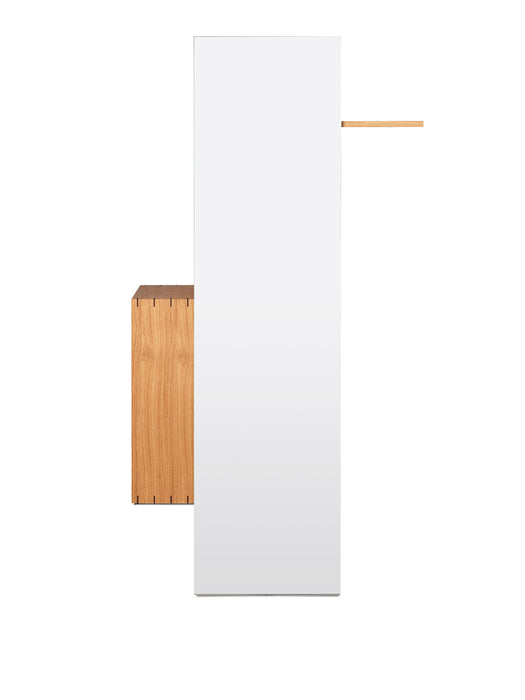

Bon Hallway
The Bon Hallway hall table is the perfect solution for those seeking elegance and practicality in a single piece of furniture. Its minimalist design, inspired by Japanese and Scandinavian aesthetics, blends seamlessly into any space, whether it's an entryway, hallway, or bedroom.
With Bon Hallway, you can keep your home organized and clutter-free. It features a top shelf ideal for displaying decorative items, a coat rack for coats and handbags, a mirror for a last-minute check before heading out, and handy narrow shelves on the side for storing keys, gloves, and other small items.
Made with the highest quality materials, the Bon Hallway is FSC™ certified and made with oak veneer and an MDF core. Exceptional craftsmanship and contrasting corner details add a touch of sophistication that won't go unnoticed.
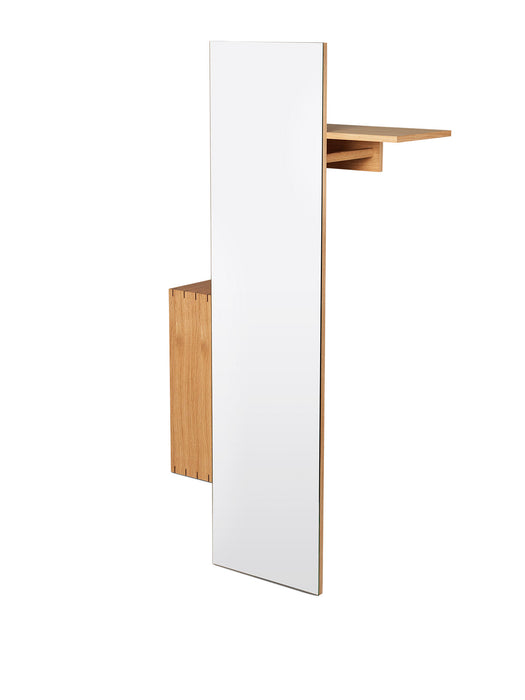

Bon Hallway
The Bon Hallway hall table is the perfect solution for those seeking elegance and practicality in a single piece of furniture. Its minimalist design, inspired by Japanese and Scandinavian aesthetics, blends seamlessly into any space, whether it's an entryway, hallway, or bedroom.
With Bon Hallway, you can keep your home organized and clutter-free. It features a top shelf ideal for displaying decorative items, a coat rack for coats and handbags, a mirror for a last-minute check before heading out, and handy narrow shelves on the side for storing keys, gloves, and other small items.
Made with the highest quality materials, the Bon Hallway is FSC™ certified and made with oak veneer and an MDF core. Exceptional craftsmanship and contrasting corner details add a touch of sophistication that won't go unnoticed.
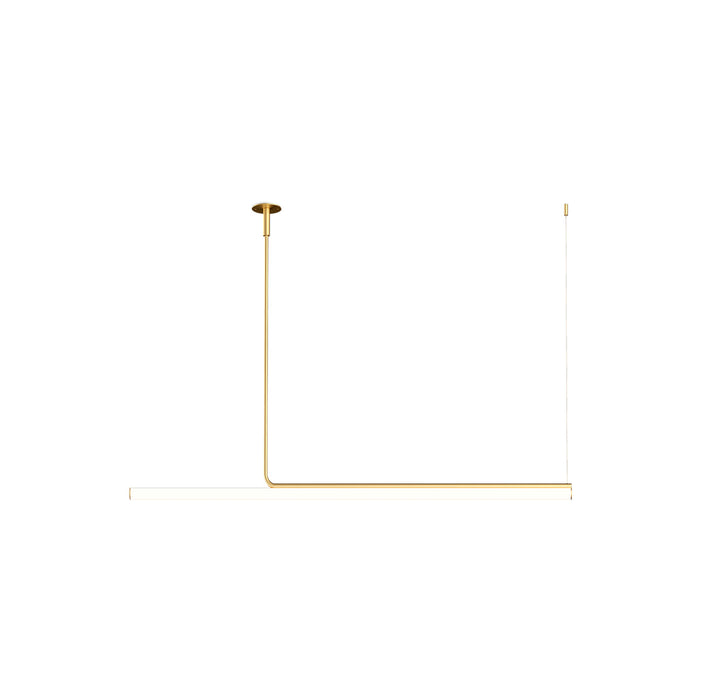

Ambrosia Matte Gold Ceiling Lamp
Ambrosia is born from the reinterpretation of the classic linestra light, fusing functionality and poetry in a unique design. What began as a simple light line has evolved into a modular system adaptable to any space. Its soft, tubular structure is suspended from the ceiling, allowing light to descend and create a warm and welcoming atmosphere. Ambrosia's diffused light fills the space with beauty and creates a unique ambiance.
Available in four predefined lengths (120 cm, 180 cm, 210 cm, and 315 cm), Ambrosia adapts to the needs of each project. With extensions of 40 and 60 cm, the light height can be adjusted to create seamless visual arrangements. The 24V SMD LED light tube offers three warm color temperatures (2200K, 2700K, and 3000K) and is dimmable. Installation can be surface-mounted, using a ceiling rose that includes a driver, or recessed.
What began as a unique, decorative piece in a Madrid boutique has evolved into a versatile and striking lighting system. Ciszak Dalmas, together with Joan Gaspar, has managed to combine simplicity, functionality, and aesthetics in a design that redefines linear lighting. A poetic reinterpretation of traditional lighting.
Also available on request in warmer color temperatures: 2200 K and 2700 K. Contact us .
Ver producto relacionado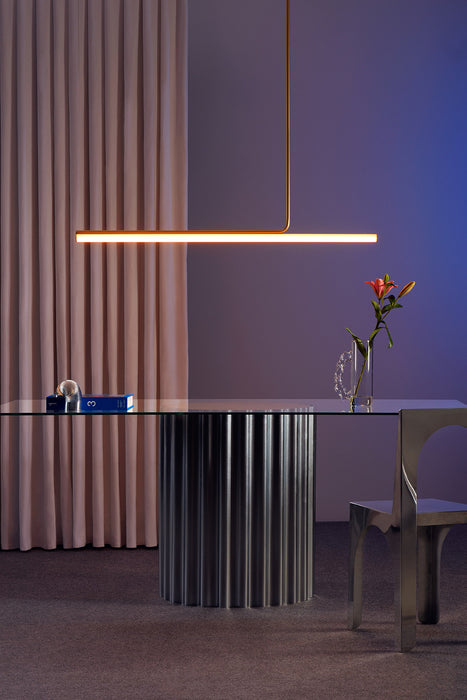

Ambrosia Matte Gold Ceiling Lamp
Ambrosia is born from the reinterpretation of the classic linestra light, fusing functionality and poetry in a unique design. What began as a simple light line has evolved into a modular system adaptable to any space. Its soft, tubular structure is suspended from the ceiling, allowing light to descend and create a warm and welcoming atmosphere. Ambrosia's diffused light fills the space with beauty and creates a unique ambiance.
Available in four predefined lengths (120 cm, 180 cm, 210 cm, and 315 cm), Ambrosia adapts to the needs of each project. With extensions of 40 and 60 cm, the light height can be adjusted to create seamless visual arrangements. The 24V SMD LED light tube offers three warm color temperatures (2200K, 2700K, and 3000K) and is dimmable. Installation can be surface-mounted, using a ceiling rose that includes a driver, or recessed.
What began as a unique, decorative piece in a Madrid boutique has evolved into a versatile and striking lighting system. Ciszak Dalmas, together with Joan Gaspar, has managed to combine simplicity, functionality, and aesthetics in a design that redefines linear lighting. A poetic reinterpretation of traditional lighting.
Also available on request in warmer color temperatures: 2200 K and 2700 K. Contact us .
Ver producto relacionado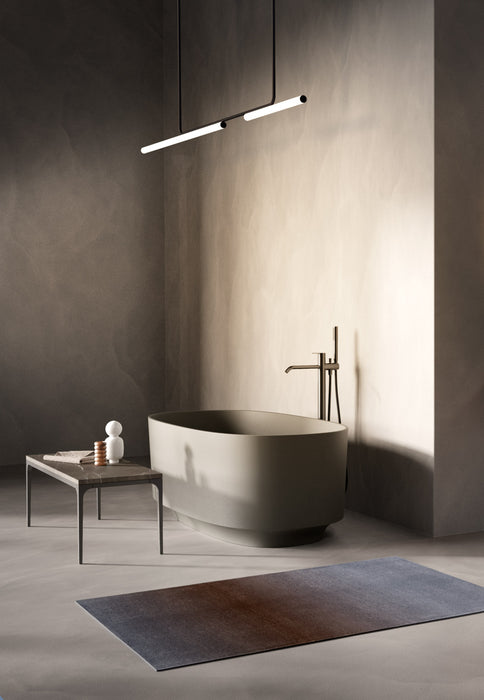

Ambrosia Matte Gold Ceiling Lamp
Ambrosia is born from the reinterpretation of the classic linestra light, fusing functionality and poetry in a unique design. What began as a simple light line has evolved into a modular system adaptable to any space. Its soft, tubular structure is suspended from the ceiling, allowing light to descend and create a warm and welcoming atmosphere. Ambrosia's diffused light fills the space with beauty and creates a unique ambiance.
Available in four predefined lengths (120 cm, 180 cm, 210 cm, and 315 cm), Ambrosia adapts to the needs of each project. With extensions of 40 and 60 cm, the light height can be adjusted to create seamless visual arrangements. The 24V SMD LED light tube offers three warm color temperatures (2200K, 2700K, and 3000K) and is dimmable. Installation can be surface-mounted, using a ceiling rose that includes a driver, or recessed.
What began as a unique, decorative piece in a Madrid boutique has evolved into a versatile and striking lighting system. Ciszak Dalmas, together with Joan Gaspar, has managed to combine simplicity, functionality, and aesthetics in a design that redefines linear lighting. A poetic reinterpretation of traditional lighting.
Also available on request in warmer color temperatures: 2200 K and 2700 K. Contact us .
Ver producto relacionado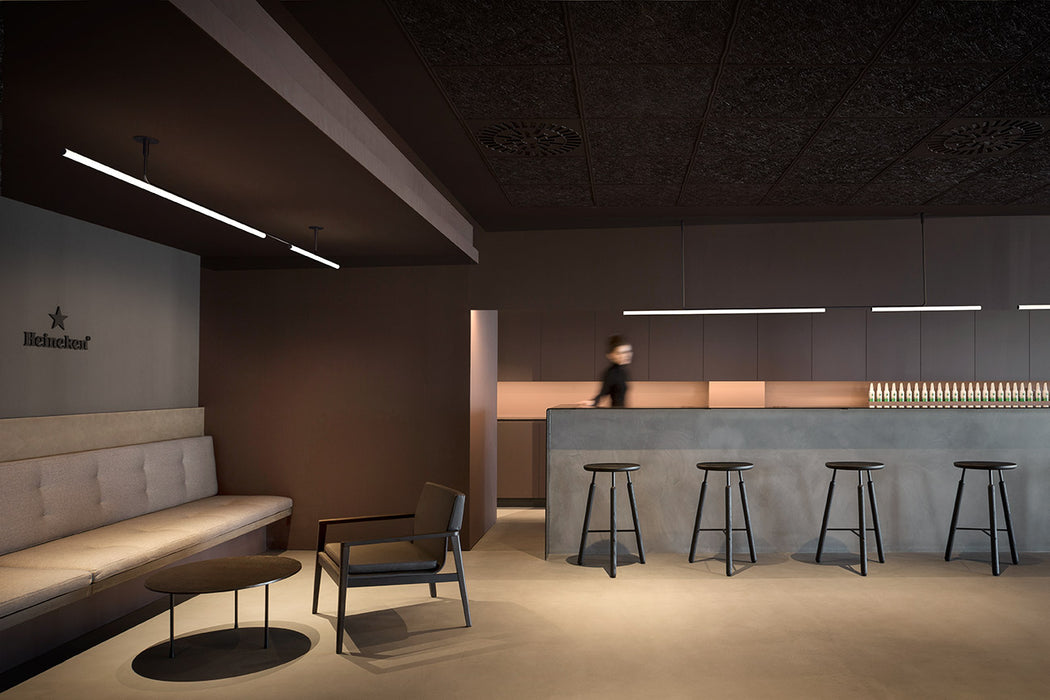

Ambrosia Matte Gold Ceiling Lamp
Ambrosia is born from the reinterpretation of the classic linestra light, fusing functionality and poetry in a unique design. What began as a simple light line has evolved into a modular system adaptable to any space. Its soft, tubular structure is suspended from the ceiling, allowing light to descend and create a warm and welcoming atmosphere. Ambrosia's diffused light fills the space with beauty and creates a unique ambiance.
Available in four predefined lengths (120 cm, 180 cm, 210 cm, and 315 cm), Ambrosia adapts to the needs of each project. With extensions of 40 and 60 cm, the light height can be adjusted to create seamless visual arrangements. The 24V SMD LED light tube offers three warm color temperatures (2200K, 2700K, and 3000K) and is dimmable. Installation can be surface-mounted, using a ceiling rose that includes a driver, or recessed.
What began as a unique, decorative piece in a Madrid boutique has evolved into a versatile and striking lighting system. Ciszak Dalmas, together with Joan Gaspar, has managed to combine simplicity, functionality, and aesthetics in a design that redefines linear lighting. A poetic reinterpretation of traditional lighting.
Also available on request in warmer color temperatures: 2200 K and 2700 K. Contact us .
Ver producto relacionado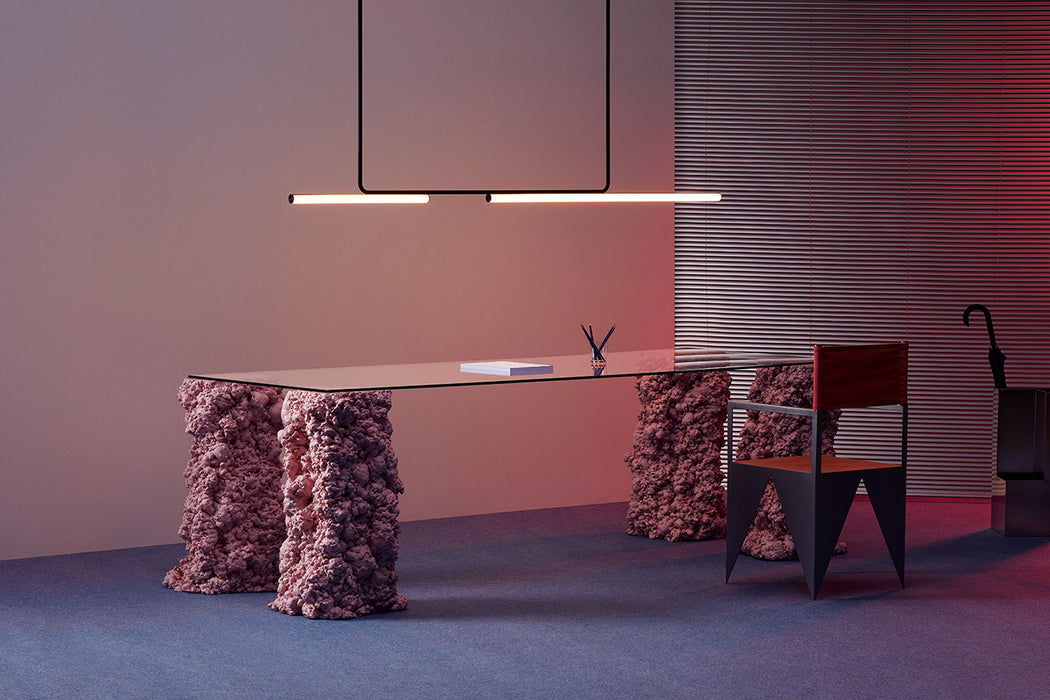

Ambrosia Matte Gold Ceiling Lamp
Ambrosia is born from the reinterpretation of the classic linestra light, fusing functionality and poetry in a unique design. What began as a simple light line has evolved into a modular system adaptable to any space. Its soft, tubular structure is suspended from the ceiling, allowing light to descend and create a warm and welcoming atmosphere. Ambrosia's diffused light fills the space with beauty and creates a unique ambiance.
Available in four predefined lengths (120 cm, 180 cm, 210 cm, and 315 cm), Ambrosia adapts to the needs of each project. With extensions of 40 and 60 cm, the light height can be adjusted to create seamless visual arrangements. The 24V SMD LED light tube offers three warm color temperatures (2200K, 2700K, and 3000K) and is dimmable. Installation can be surface-mounted, using a ceiling rose that includes a driver, or recessed.
What began as a unique, decorative piece in a Madrid boutique has evolved into a versatile and striking lighting system. Ciszak Dalmas, together with Joan Gaspar, has managed to combine simplicity, functionality, and aesthetics in a design that redefines linear lighting. A poetic reinterpretation of traditional lighting.
Also available on request in warmer color temperatures: 2200 K and 2700 K. Contact us .
Ver producto relacionado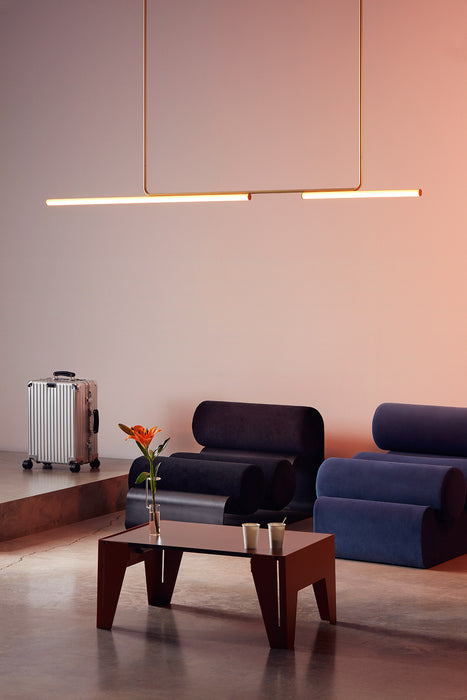

Ambrosia Matte Gold Ceiling Lamp
Ambrosia is born from the reinterpretation of the classic linestra light, fusing functionality and poetry in a unique design. What began as a simple light line has evolved into a modular system adaptable to any space. Its soft, tubular structure is suspended from the ceiling, allowing light to descend and create a warm and welcoming atmosphere. Ambrosia's diffused light fills the space with beauty and creates a unique ambiance.
Available in four predefined lengths (120 cm, 180 cm, 210 cm, and 315 cm), Ambrosia adapts to the needs of each project. With extensions of 40 and 60 cm, the light height can be adjusted to create seamless visual arrangements. The 24V SMD LED light tube offers three warm color temperatures (2200K, 2700K, and 3000K) and is dimmable. Installation can be surface-mounted, using a ceiling rose that includes a driver, or recessed.
What began as a unique, decorative piece in a Madrid boutique has evolved into a versatile and striking lighting system. Ciszak Dalmas, together with Joan Gaspar, has managed to combine simplicity, functionality, and aesthetics in a design that redefines linear lighting. A poetic reinterpretation of traditional lighting.
Also available on request in warmer color temperatures: 2200 K and 2700 K. Contact us .
Ver producto relacionado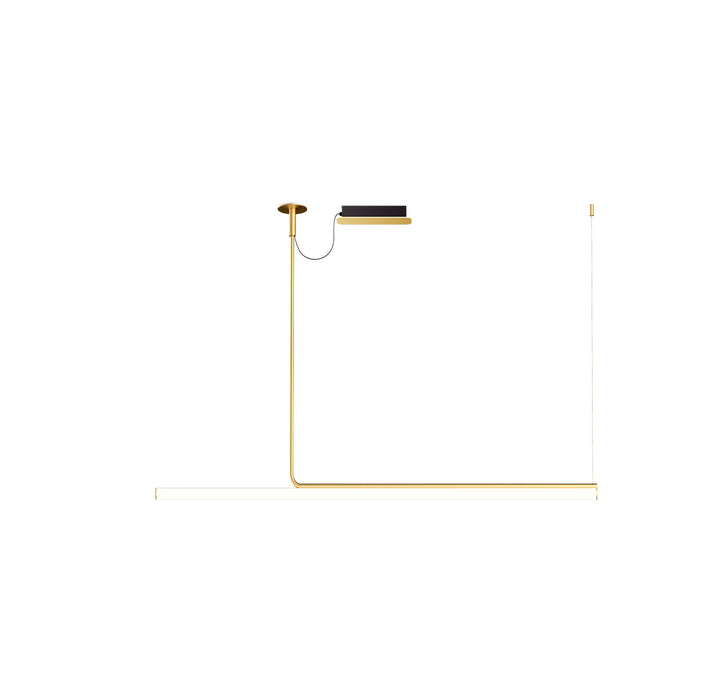

Ambrosia Matte Gold Ceiling Lamp
Ambrosia is born from the reinterpretation of the classic linestra light, fusing functionality and poetry in a unique design. What began as a simple light line has evolved into a modular system adaptable to any space. Its soft, tubular structure is suspended from the ceiling, allowing light to descend and create a warm and welcoming atmosphere. Ambrosia's diffused light fills the space with beauty and creates a unique ambiance.
Available in four predefined lengths (120 cm, 180 cm, 210 cm, and 315 cm), Ambrosia adapts to the needs of each project. With extensions of 40 and 60 cm, the light height can be adjusted to create seamless visual arrangements. The 24V SMD LED light tube offers three warm color temperatures (2200K, 2700K, and 3000K) and is dimmable. Installation can be surface-mounted, using a ceiling rose that includes a driver, or recessed.
What began as a unique, decorative piece in a Madrid boutique has evolved into a versatile and striking lighting system. Ciszak Dalmas, together with Joan Gaspar, has managed to combine simplicity, functionality, and aesthetics in a design that redefines linear lighting. A poetic reinterpretation of traditional lighting.
Also available on request in warmer color temperatures: 2200 K and 2700 K. Contact us .
Ver producto relacionado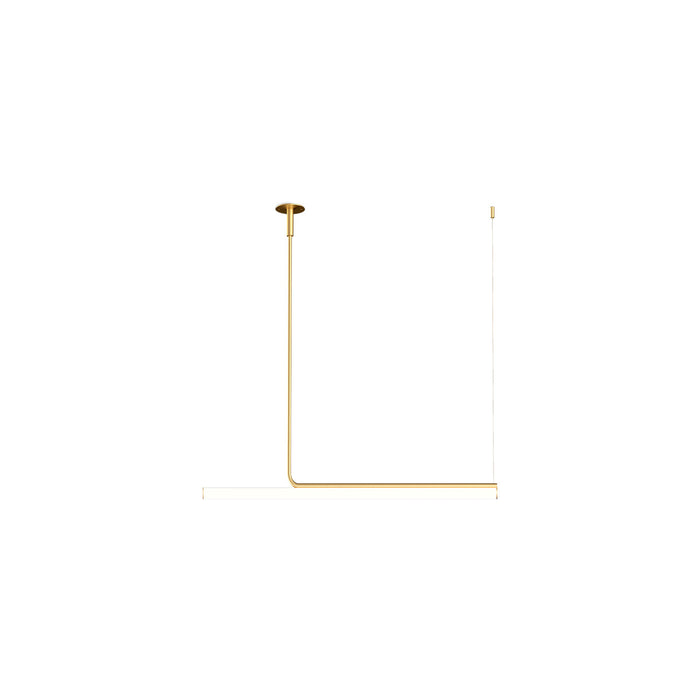

Ambrosia Matte Gold Ceiling Lamp
Ambrosia is born from the reinterpretation of the classic linestra light, fusing functionality and poetry in a unique design. What began as a simple light line has evolved into a modular system adaptable to any space. Its soft, tubular structure is suspended from the ceiling, allowing light to descend and create a warm and welcoming atmosphere. Ambrosia's diffused light fills the space with beauty and creates a unique ambiance.
Available in four predefined lengths (120 cm, 180 cm, 210 cm, and 315 cm), Ambrosia adapts to the needs of each project. With extensions of 40 and 60 cm, the light height can be adjusted to create seamless visual arrangements. The 24V SMD LED light tube offers three warm color temperatures (2200K, 2700K, and 3000K) and is dimmable. Installation can be surface-mounted, using a ceiling rose that includes a driver, or recessed.
What began as a unique, decorative piece in a Madrid boutique has evolved into a versatile and striking lighting system. Ciszak Dalmas, together with Joan Gaspar, has managed to combine simplicity, functionality, and aesthetics in a design that redefines linear lighting. A poetic reinterpretation of traditional lighting.
Also available on request in warmer color temperatures: 2200 K and 2700 K. Contact us .
Ver producto relacionado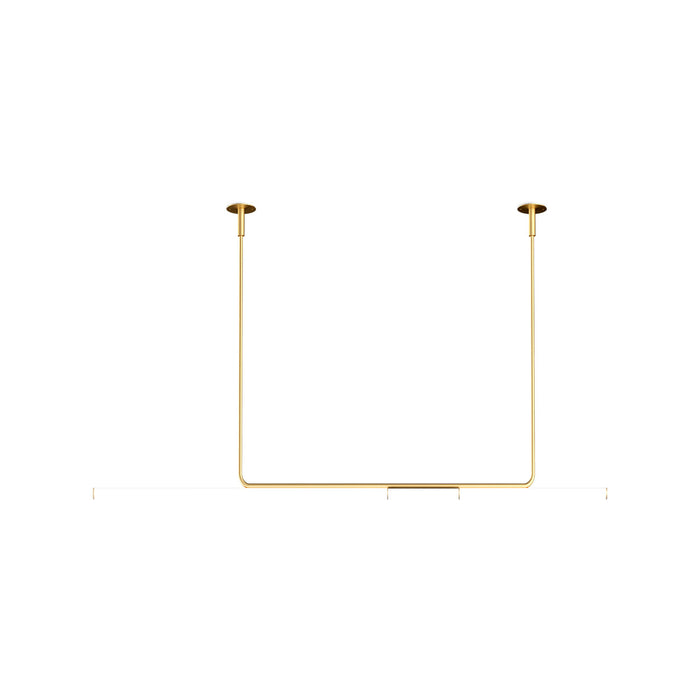

Ambrosia Matte Gold Ceiling Lamp
Ambrosia is born from the reinterpretation of the classic linestra light, fusing functionality and poetry in a unique design. What began as a simple light line has evolved into a modular system adaptable to any space. Its soft, tubular structure is suspended from the ceiling, allowing light to descend and create a warm and welcoming atmosphere. Ambrosia's diffused light fills the space with beauty and creates a unique ambiance.
Available in four predefined lengths (120 cm, 180 cm, 210 cm, and 315 cm), Ambrosia adapts to the needs of each project. With extensions of 40 and 60 cm, the light height can be adjusted to create seamless visual arrangements. The 24V SMD LED light tube offers three warm color temperatures (2200K, 2700K, and 3000K) and is dimmable. Installation can be surface-mounted, using a ceiling rose that includes a driver, or recessed.
What began as a unique, decorative piece in a Madrid boutique has evolved into a versatile and striking lighting system. Ciszak Dalmas, together with Joan Gaspar, has managed to combine simplicity, functionality, and aesthetics in a design that redefines linear lighting. A poetic reinterpretation of traditional lighting.
Also available on request in warmer color temperatures: 2200 K and 2700 K. Contact us .
Ver producto relacionado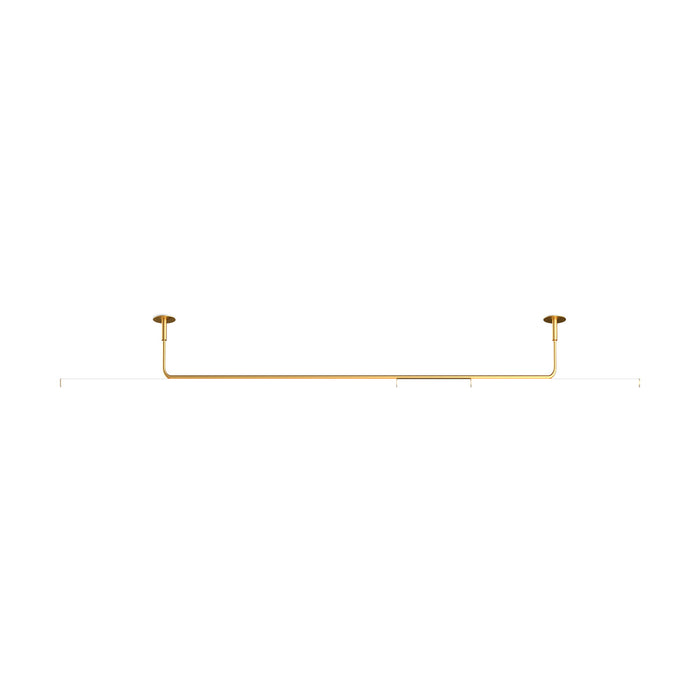

Ambrosia Matte Gold Ceiling Lamp
Ambrosia is born from the reinterpretation of the classic linestra light, fusing functionality and poetry in a unique design. What began as a simple light line has evolved into a modular system adaptable to any space. Its soft, tubular structure is suspended from the ceiling, allowing light to descend and create a warm and welcoming atmosphere. Ambrosia's diffused light fills the space with beauty and creates a unique ambiance.
Available in four predefined lengths (120 cm, 180 cm, 210 cm, and 315 cm), Ambrosia adapts to the needs of each project. With extensions of 40 and 60 cm, the light height can be adjusted to create seamless visual arrangements. The 24V SMD LED light tube offers three warm color temperatures (2200K, 2700K, and 3000K) and is dimmable. Installation can be surface-mounted, using a ceiling rose that includes a driver, or recessed.
What began as a unique, decorative piece in a Madrid boutique has evolved into a versatile and striking lighting system. Ciszak Dalmas, together with Joan Gaspar, has managed to combine simplicity, functionality, and aesthetics in a design that redefines linear lighting. A poetic reinterpretation of traditional lighting.
Also available on request in warmer color temperatures: 2200 K and 2700 K. Contact us .
Ver producto relacionado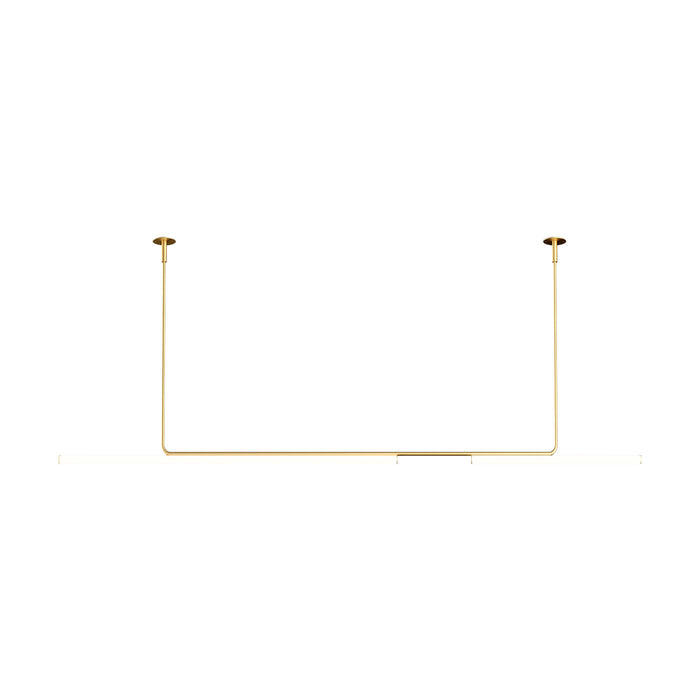

Ambrosia Matte Gold Ceiling Lamp
Ambrosia is born from the reinterpretation of the classic linestra light, fusing functionality and poetry in a unique design. What began as a simple light line has evolved into a modular system adaptable to any space. Its soft, tubular structure is suspended from the ceiling, allowing light to descend and create a warm and welcoming atmosphere. Ambrosia's diffused light fills the space with beauty and creates a unique ambiance.
Available in four predefined lengths (120 cm, 180 cm, 210 cm, and 315 cm), Ambrosia adapts to the needs of each project. With extensions of 40 and 60 cm, the light height can be adjusted to create seamless visual arrangements. The 24V SMD LED light tube offers three warm color temperatures (2200K, 2700K, and 3000K) and is dimmable. Installation can be surface-mounted, using a ceiling rose that includes a driver, or recessed.
What began as a unique, decorative piece in a Madrid boutique has evolved into a versatile and striking lighting system. Ciszak Dalmas, together with Joan Gaspar, has managed to combine simplicity, functionality, and aesthetics in a design that redefines linear lighting. A poetic reinterpretation of traditional lighting.
Also available on request in warmer color temperatures: 2200 K and 2700 K. Contact us .
Ver producto relacionado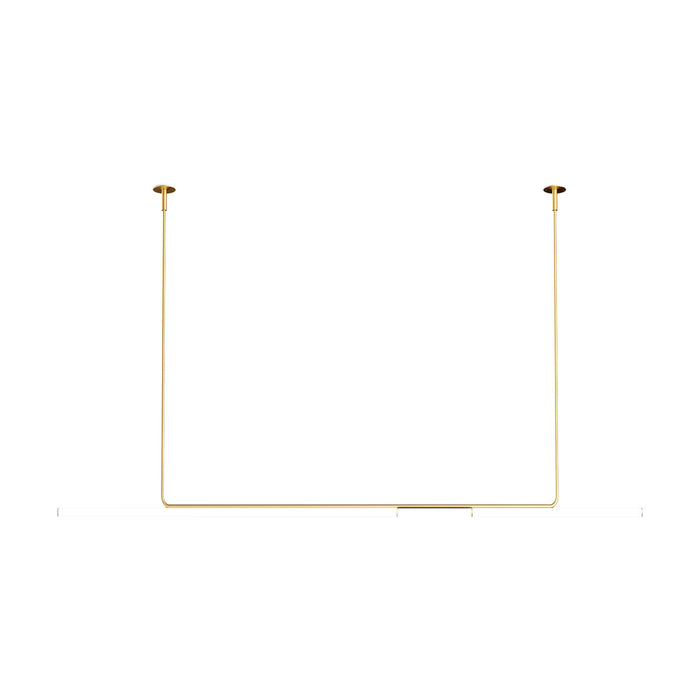

Ambrosia Matte Gold Ceiling Lamp
Ambrosia is born from the reinterpretation of the classic linestra light, fusing functionality and poetry in a unique design. What began as a simple light line has evolved into a modular system adaptable to any space. Its soft, tubular structure is suspended from the ceiling, allowing light to descend and create a warm and welcoming atmosphere. Ambrosia's diffused light fills the space with beauty and creates a unique ambiance.
Available in four predefined lengths (120 cm, 180 cm, 210 cm, and 315 cm), Ambrosia adapts to the needs of each project. With extensions of 40 and 60 cm, the light height can be adjusted to create seamless visual arrangements. The 24V SMD LED light tube offers three warm color temperatures (2200K, 2700K, and 3000K) and is dimmable. Installation can be surface-mounted, using a ceiling rose that includes a driver, or recessed.
What began as a unique, decorative piece in a Madrid boutique has evolved into a versatile and striking lighting system. Ciszak Dalmas, together with Joan Gaspar, has managed to combine simplicity, functionality, and aesthetics in a design that redefines linear lighting. A poetic reinterpretation of traditional lighting.
Also available on request in warmer color temperatures: 2200 K and 2700 K. Contact us .
Ver producto relacionado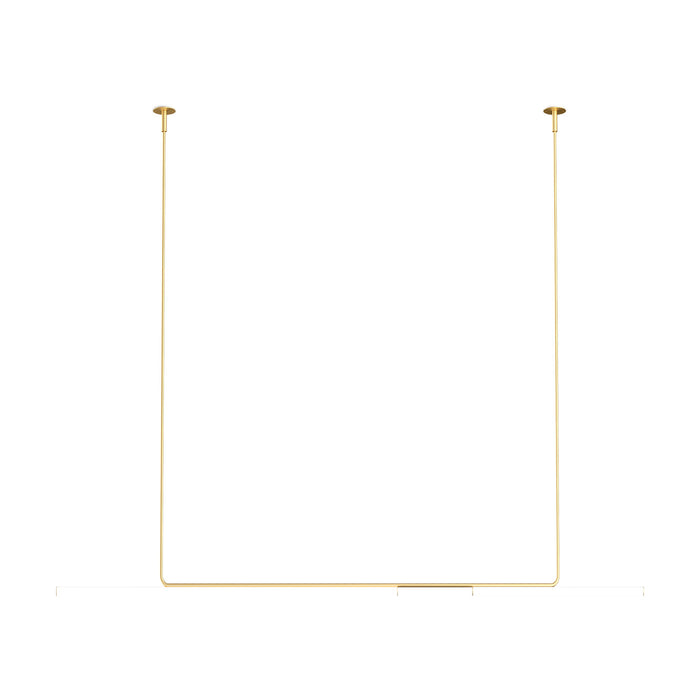

Ambrosia Matte Gold Ceiling Lamp
Ambrosia is born from the reinterpretation of the classic linestra light, fusing functionality and poetry in a unique design. What began as a simple light line has evolved into a modular system adaptable to any space. Its soft, tubular structure is suspended from the ceiling, allowing light to descend and create a warm and welcoming atmosphere. Ambrosia's diffused light fills the space with beauty and creates a unique ambiance.
Available in four predefined lengths (120 cm, 180 cm, 210 cm, and 315 cm), Ambrosia adapts to the needs of each project. With extensions of 40 and 60 cm, the light height can be adjusted to create seamless visual arrangements. The 24V SMD LED light tube offers three warm color temperatures (2200K, 2700K, and 3000K) and is dimmable. Installation can be surface-mounted, using a ceiling rose that includes a driver, or recessed.
What began as a unique, decorative piece in a Madrid boutique has evolved into a versatile and striking lighting system. Ciszak Dalmas, together with Joan Gaspar, has managed to combine simplicity, functionality, and aesthetics in a design that redefines linear lighting. A poetic reinterpretation of traditional lighting.
Also available on request in warmer color temperatures: 2200 K and 2700 K. Contact us .
Ver producto relacionado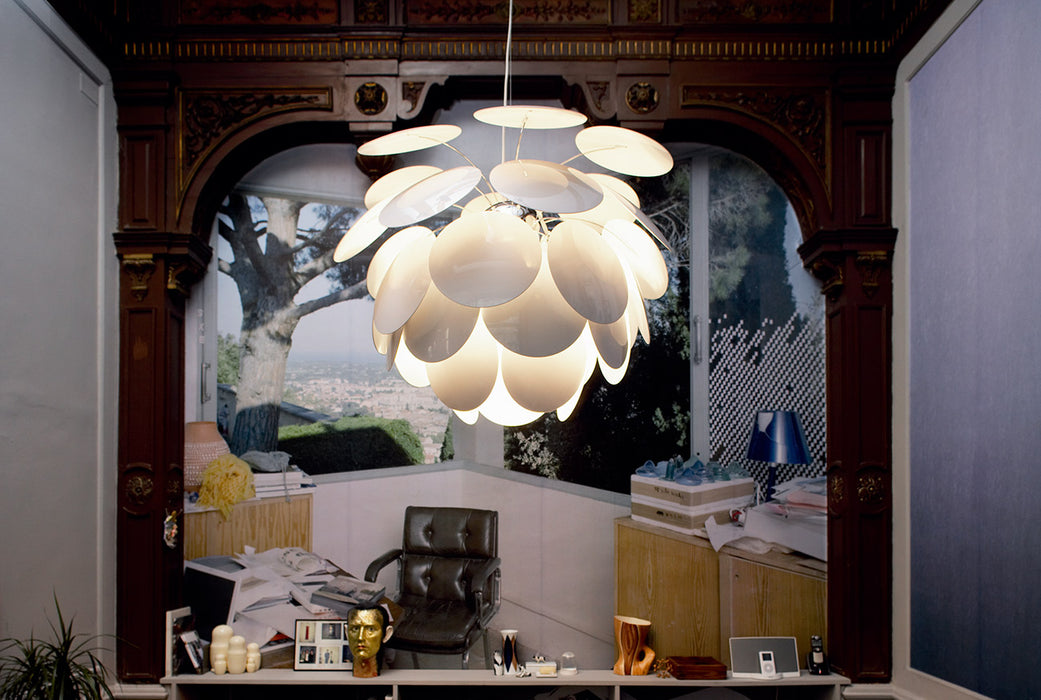

Discocó ceiling lamp
Exuberant even when switched off, the Discocó by Marset is a lamp that will leave no one indifferent. Its unique design creates a warm and welcoming atmosphere thanks to the richness of light it emits and the effective play of light and shadow projected onto its surroundings. More than a simple lamp, the Discocó is a work of art. Its detailed study of indirect light adds depth to the object and creates a unique visual experience. The chrome sphere at the core, where the discs are attached, creates additional reflections that enhance the lamp's beauty.
Available in a wide variety of colors and sizes, the Discocó adapts to any space. You can find it in white, gray, beige, gold black, and oak wood, a noble material that provides unparalleled elegance and warmth. The wooden version of the Discocó is a true challenge. Using this material and achieving a light weight without conveying apparent weight is a remarkable achievement. This version is available only as a pendant, with a diameter of 68 cm. The internal metal structure is presented in a graphite nickel finish for an elegant contrast.
Regardless of the size or color you choose, the Discocó will provide an extraordinarily cozy light that you'll love. It's the perfect lamp for creating a warm and elegant atmosphere in any space.
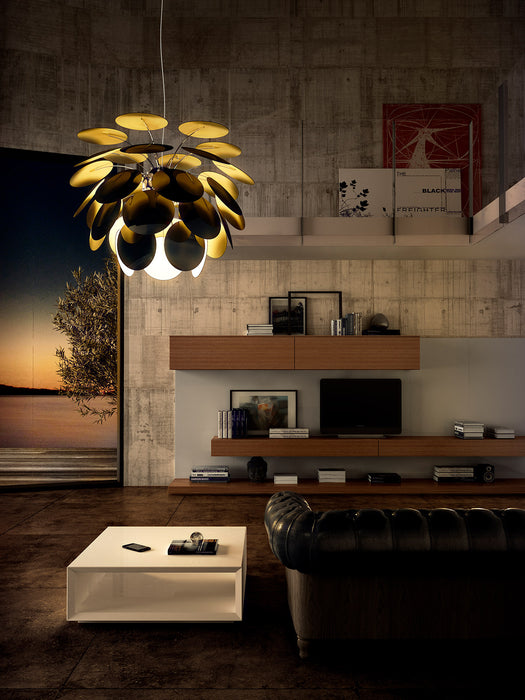

Discocó ceiling lamp
Exuberant even when switched off, the Discocó by Marset is a lamp that will leave no one indifferent. Its unique design creates a warm and welcoming atmosphere thanks to the richness of light it emits and the effective play of light and shadow projected onto its surroundings. More than a simple lamp, the Discocó is a work of art. Its detailed study of indirect light adds depth to the object and creates a unique visual experience. The chrome sphere at the core, where the discs are attached, creates additional reflections that enhance the lamp's beauty.
Available in a wide variety of colors and sizes, the Discocó adapts to any space. You can find it in white, gray, beige, gold black, and oak wood, a noble material that provides unparalleled elegance and warmth. The wooden version of the Discocó is a true challenge. Using this material and achieving a light weight without conveying apparent weight is a remarkable achievement. This version is available only as a pendant, with a diameter of 68 cm. The internal metal structure is presented in a graphite nickel finish for an elegant contrast.
Regardless of the size or color you choose, the Discocó will provide an extraordinarily cozy light that you'll love. It's the perfect lamp for creating a warm and elegant atmosphere in any space.
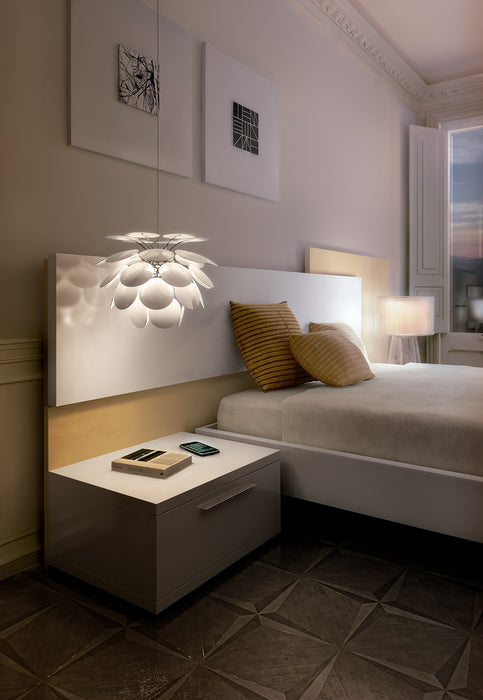

Discocó ceiling lamp
Exuberant even when switched off, the Discocó by Marset is a lamp that will leave no one indifferent. Its unique design creates a warm and welcoming atmosphere thanks to the richness of light it emits and the effective play of light and shadow projected onto its surroundings. More than a simple lamp, the Discocó is a work of art. Its detailed study of indirect light adds depth to the object and creates a unique visual experience. The chrome sphere at the core, where the discs are attached, creates additional reflections that enhance the lamp's beauty.
Available in a wide variety of colors and sizes, the Discocó adapts to any space. You can find it in white, gray, beige, gold black, and oak wood, a noble material that provides unparalleled elegance and warmth. The wooden version of the Discocó is a true challenge. Using this material and achieving a light weight without conveying apparent weight is a remarkable achievement. This version is available only as a pendant, with a diameter of 68 cm. The internal metal structure is presented in a graphite nickel finish for an elegant contrast.
Regardless of the size or color you choose, the Discocó will provide an extraordinarily cozy light that you'll love. It's the perfect lamp for creating a warm and elegant atmosphere in any space.
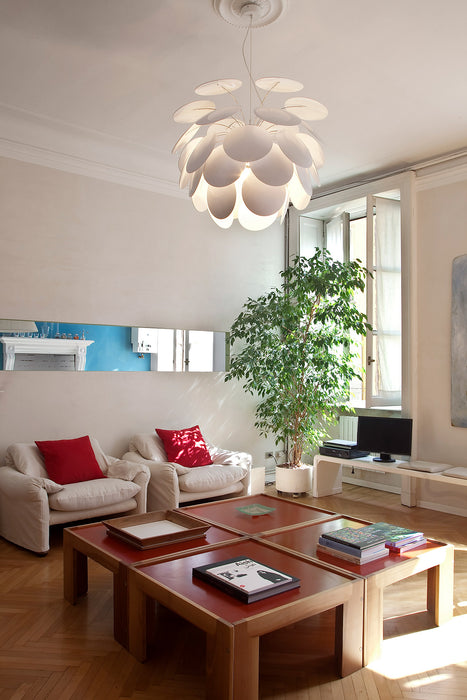

Discocó ceiling lamp
Exuberant even when switched off, the Discocó by Marset is a lamp that will leave no one indifferent. Its unique design creates a warm and welcoming atmosphere thanks to the richness of light it emits and the effective play of light and shadow projected onto its surroundings. More than a simple lamp, the Discocó is a work of art. Its detailed study of indirect light adds depth to the object and creates a unique visual experience. The chrome sphere at the core, where the discs are attached, creates additional reflections that enhance the lamp's beauty.
Available in a wide variety of colors and sizes, the Discocó adapts to any space. You can find it in white, gray, beige, gold black, and oak wood, a noble material that provides unparalleled elegance and warmth. The wooden version of the Discocó is a true challenge. Using this material and achieving a light weight without conveying apparent weight is a remarkable achievement. This version is available only as a pendant, with a diameter of 68 cm. The internal metal structure is presented in a graphite nickel finish for an elegant contrast.
Regardless of the size or color you choose, the Discocó will provide an extraordinarily cozy light that you'll love. It's the perfect lamp for creating a warm and elegant atmosphere in any space.
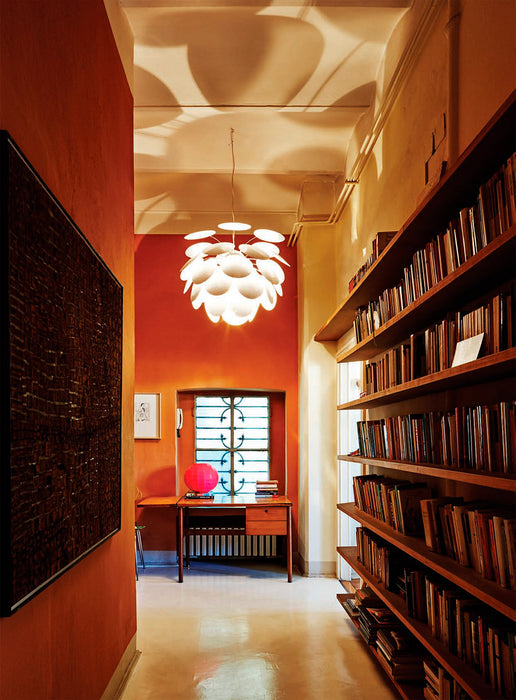

Discocó ceiling lamp
Exuberant even when switched off, the Discocó by Marset is a lamp that will leave no one indifferent. Its unique design creates a warm and welcoming atmosphere thanks to the richness of light it emits and the effective play of light and shadow projected onto its surroundings. More than a simple lamp, the Discocó is a work of art. Its detailed study of indirect light adds depth to the object and creates a unique visual experience. The chrome sphere at the core, where the discs are attached, creates additional reflections that enhance the lamp's beauty.
Available in a wide variety of colors and sizes, the Discocó adapts to any space. You can find it in white, gray, beige, gold black, and oak wood, a noble material that provides unparalleled elegance and warmth. The wooden version of the Discocó is a true challenge. Using this material and achieving a light weight without conveying apparent weight is a remarkable achievement. This version is available only as a pendant, with a diameter of 68 cm. The internal metal structure is presented in a graphite nickel finish for an elegant contrast.
Regardless of the size or color you choose, the Discocó will provide an extraordinarily cozy light that you'll love. It's the perfect lamp for creating a warm and elegant atmosphere in any space.
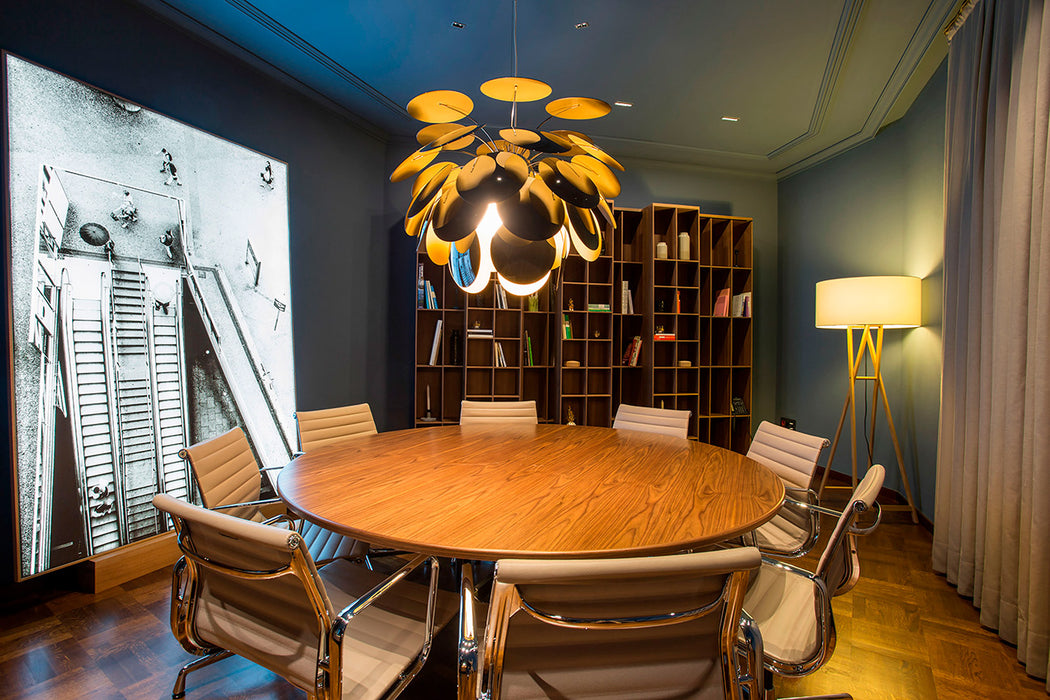

Discocó ceiling lamp
Exuberant even when switched off, the Discocó by Marset is a lamp that will leave no one indifferent. Its unique design creates a warm and welcoming atmosphere thanks to the richness of light it emits and the effective play of light and shadow projected onto its surroundings. More than a simple lamp, the Discocó is a work of art. Its detailed study of indirect light adds depth to the object and creates a unique visual experience. The chrome sphere at the core, where the discs are attached, creates additional reflections that enhance the lamp's beauty.
Available in a wide variety of colors and sizes, the Discocó adapts to any space. You can find it in white, gray, beige, gold black, and oak wood, a noble material that provides unparalleled elegance and warmth. The wooden version of the Discocó is a true challenge. Using this material and achieving a light weight without conveying apparent weight is a remarkable achievement. This version is available only as a pendant, with a diameter of 68 cm. The internal metal structure is presented in a graphite nickel finish for an elegant contrast.
Regardless of the size or color you choose, the Discocó will provide an extraordinarily cozy light that you'll love. It's the perfect lamp for creating a warm and elegant atmosphere in any space.
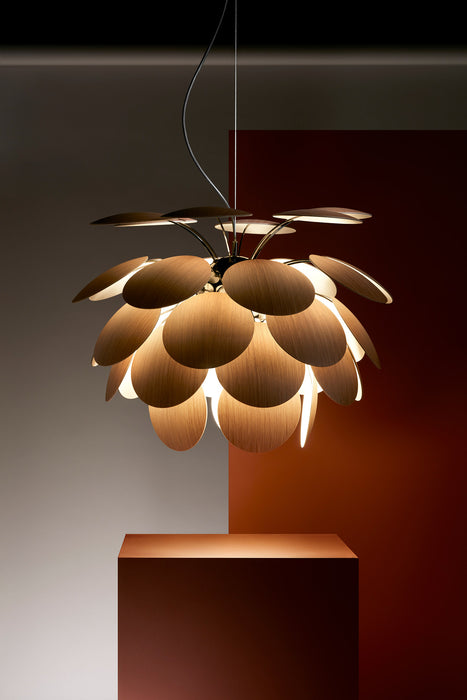

Discocó ceiling lamp
Exuberant even when switched off, the Discocó by Marset is a lamp that will leave no one indifferent. Its unique design creates a warm and welcoming atmosphere thanks to the richness of light it emits and the effective play of light and shadow projected onto its surroundings. More than a simple lamp, the Discocó is a work of art. Its detailed study of indirect light adds depth to the object and creates a unique visual experience. The chrome sphere at the core, where the discs are attached, creates additional reflections that enhance the lamp's beauty.
Available in a wide variety of colors and sizes, the Discocó adapts to any space. You can find it in white, gray, beige, gold black, and oak wood, a noble material that provides unparalleled elegance and warmth. The wooden version of the Discocó is a true challenge. Using this material and achieving a light weight without conveying apparent weight is a remarkable achievement. This version is available only as a pendant, with a diameter of 68 cm. The internal metal structure is presented in a graphite nickel finish for an elegant contrast.
Regardless of the size or color you choose, the Discocó will provide an extraordinarily cozy light that you'll love. It's the perfect lamp for creating a warm and elegant atmosphere in any space.
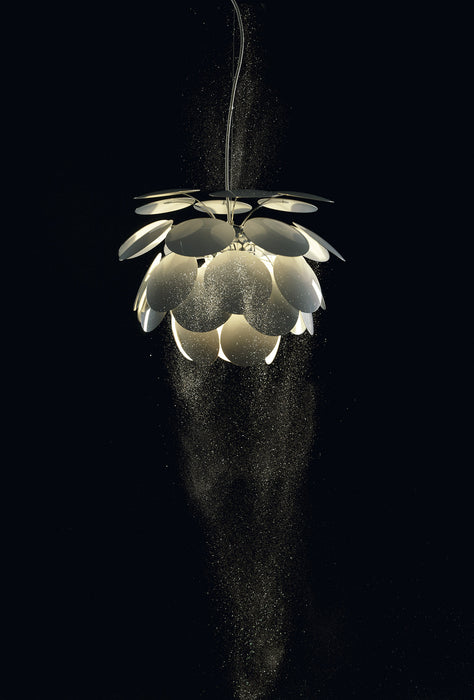

Discocó ceiling lamp
Exuberant even when switched off, the Discocó by Marset is a lamp that will leave no one indifferent. Its unique design creates a warm and welcoming atmosphere thanks to the richness of light it emits and the effective play of light and shadow projected onto its surroundings. More than a simple lamp, the Discocó is a work of art. Its detailed study of indirect light adds depth to the object and creates a unique visual experience. The chrome sphere at the core, where the discs are attached, creates additional reflections that enhance the lamp's beauty.
Available in a wide variety of colors and sizes, the Discocó adapts to any space. You can find it in white, gray, beige, gold black, and oak wood, a noble material that provides unparalleled elegance and warmth. The wooden version of the Discocó is a true challenge. Using this material and achieving a light weight without conveying apparent weight is a remarkable achievement. This version is available only as a pendant, with a diameter of 68 cm. The internal metal structure is presented in a graphite nickel finish for an elegant contrast.
Regardless of the size or color you choose, the Discocó will provide an extraordinarily cozy light that you'll love. It's the perfect lamp for creating a warm and elegant atmosphere in any space.
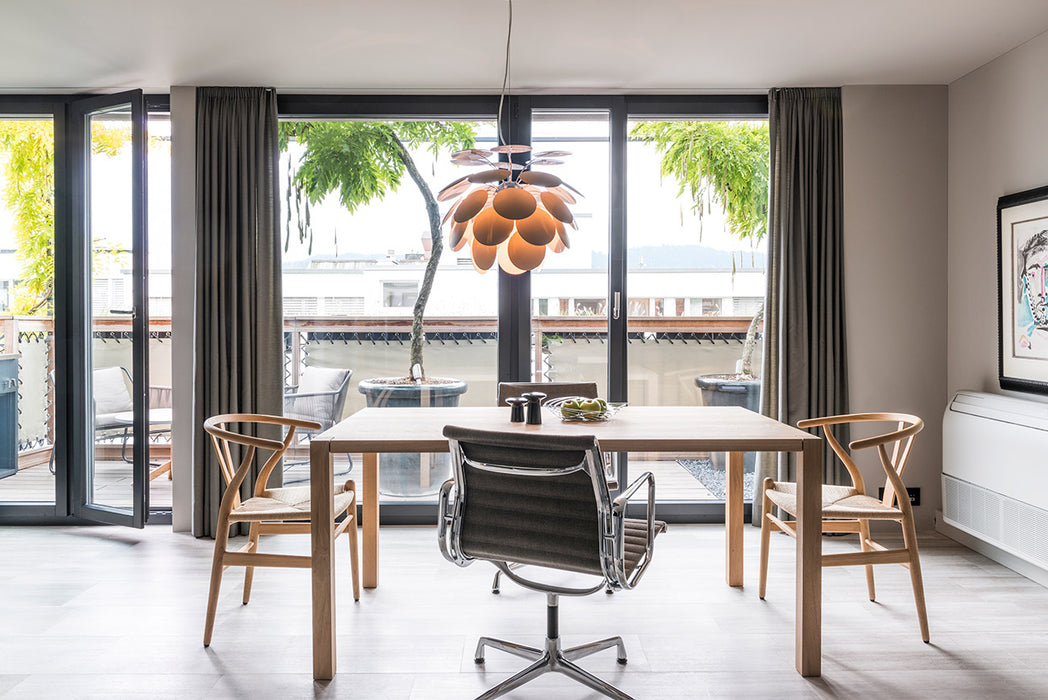

Discocó ceiling lamp
Exuberant even when switched off, the Discocó by Marset is a lamp that will leave no one indifferent. Its unique design creates a warm and welcoming atmosphere thanks to the richness of light it emits and the effective play of light and shadow projected onto its surroundings. More than a simple lamp, the Discocó is a work of art. Its detailed study of indirect light adds depth to the object and creates a unique visual experience. The chrome sphere at the core, where the discs are attached, creates additional reflections that enhance the lamp's beauty.
Available in a wide variety of colors and sizes, the Discocó adapts to any space. You can find it in white, gray, beige, gold black, and oak wood, a noble material that provides unparalleled elegance and warmth. The wooden version of the Discocó is a true challenge. Using this material and achieving a light weight without conveying apparent weight is a remarkable achievement. This version is available only as a pendant, with a diameter of 68 cm. The internal metal structure is presented in a graphite nickel finish for an elegant contrast.
Regardless of the size or color you choose, the Discocó will provide an extraordinarily cozy light that you'll love. It's the perfect lamp for creating a warm and elegant atmosphere in any space.
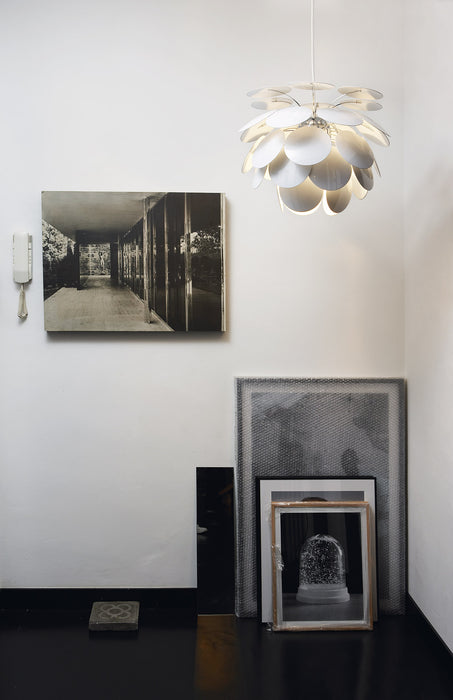

Discocó ceiling lamp
Exuberant even when switched off, the Discocó by Marset is a lamp that will leave no one indifferent. Its unique design creates a warm and welcoming atmosphere thanks to the richness of light it emits and the effective play of light and shadow projected onto its surroundings. More than a simple lamp, the Discocó is a work of art. Its detailed study of indirect light adds depth to the object and creates a unique visual experience. The chrome sphere at the core, where the discs are attached, creates additional reflections that enhance the lamp's beauty.
Available in a wide variety of colors and sizes, the Discocó adapts to any space. You can find it in white, gray, beige, gold black, and oak wood, a noble material that provides unparalleled elegance and warmth. The wooden version of the Discocó is a true challenge. Using this material and achieving a light weight without conveying apparent weight is a remarkable achievement. This version is available only as a pendant, with a diameter of 68 cm. The internal metal structure is presented in a graphite nickel finish for an elegant contrast.
Regardless of the size or color you choose, the Discocó will provide an extraordinarily cozy light that you'll love. It's the perfect lamp for creating a warm and elegant atmosphere in any space.
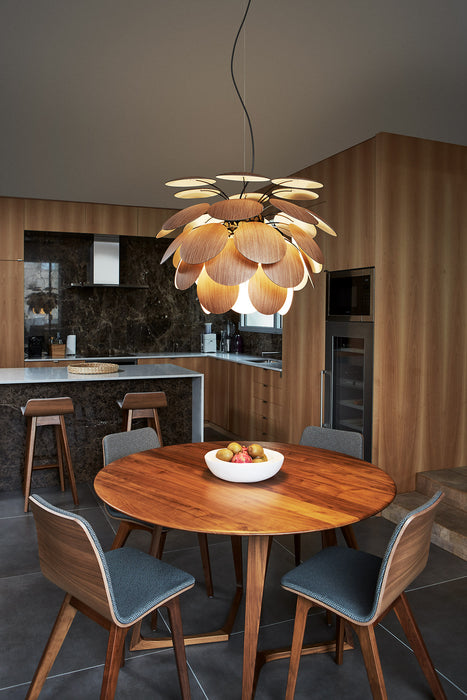

Discocó ceiling lamp
Exuberant even when switched off, the Discocó by Marset is a lamp that will leave no one indifferent. Its unique design creates a warm and welcoming atmosphere thanks to the richness of light it emits and the effective play of light and shadow projected onto its surroundings. More than a simple lamp, the Discocó is a work of art. Its detailed study of indirect light adds depth to the object and creates a unique visual experience. The chrome sphere at the core, where the discs are attached, creates additional reflections that enhance the lamp's beauty.
Available in a wide variety of colors and sizes, the Discocó adapts to any space. You can find it in white, gray, beige, gold black, and oak wood, a noble material that provides unparalleled elegance and warmth. The wooden version of the Discocó is a true challenge. Using this material and achieving a light weight without conveying apparent weight is a remarkable achievement. This version is available only as a pendant, with a diameter of 68 cm. The internal metal structure is presented in a graphite nickel finish for an elegant contrast.
Regardless of the size or color you choose, the Discocó will provide an extraordinarily cozy light that you'll love. It's the perfect lamp for creating a warm and elegant atmosphere in any space.


Dipping Light wall lamp
This version of the wall light allows you to choose the finish of the box between gold and graphite.
Dipping Light was born from the experiment of dipping a lit light bulb into paint repeatedly, transforming it into a lamp. By doing this, the different layers of paint draw concentric circles and trap the light, dimming its intensity. The paint becomes a shade, giving color to the light and adding texture. A brass base is designed as a support. This artisanal process makes each lamp unique and exclusive.
Beyond its function as a lamp, Dipping Light seeks to create emotion. When lit, it is mesmerizing, as its different shades of paint filter the light, creating a magical effect in the room. When unlit, it transforms into a colored glass sphere, making it an object of great aesthetic value.
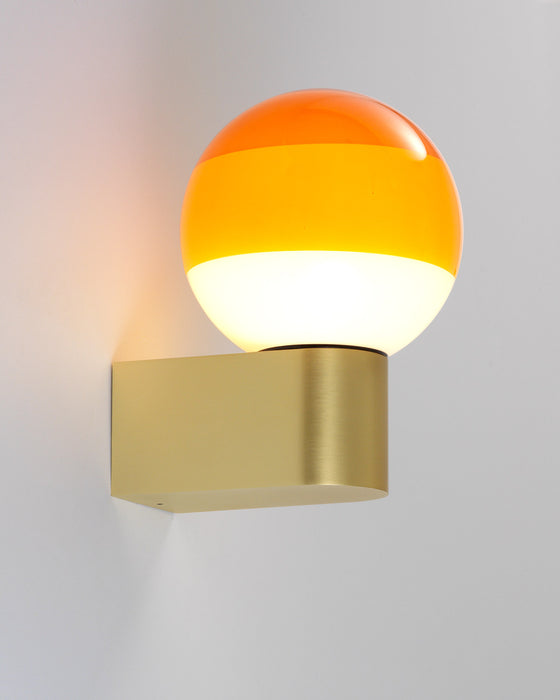

Dipping Light wall lamp
This version of the wall light allows you to choose the finish of the box between gold and graphite.
Dipping Light was born from the experiment of dipping a lit light bulb into paint repeatedly, transforming it into a lamp. By doing this, the different layers of paint draw concentric circles and trap the light, dimming its intensity. The paint becomes a shade, giving color to the light and adding texture. A brass base is designed as a support. This artisanal process makes each lamp unique and exclusive.
Beyond its function as a lamp, Dipping Light seeks to create emotion. When lit, it is mesmerizing, as its different shades of paint filter the light, creating a magical effect in the room. When unlit, it transforms into a colored glass sphere, making it an object of great aesthetic value.


Dipping Light wall lamp
This version of the wall light allows you to choose the finish of the box between gold and graphite.
Dipping Light was born from the experiment of dipping a lit light bulb into paint repeatedly, transforming it into a lamp. By doing this, the different layers of paint draw concentric circles and trap the light, dimming its intensity. The paint becomes a shade, giving color to the light and adding texture. A brass base is designed as a support. This artisanal process makes each lamp unique and exclusive.
Beyond its function as a lamp, Dipping Light seeks to create emotion. When lit, it is mesmerizing, as its different shades of paint filter the light, creating a magical effect in the room. When unlit, it transforms into a colored glass sphere, making it an object of great aesthetic value.
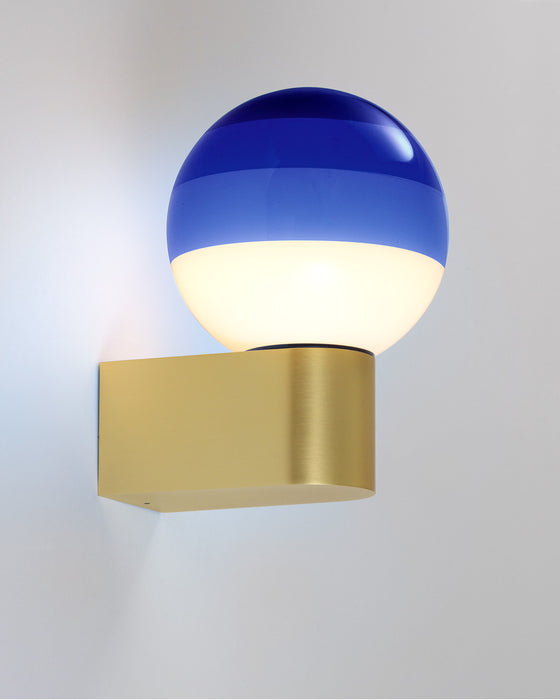

Dipping Light wall lamp
This version of the wall light allows you to choose the finish of the box between gold and graphite.
Dipping Light was born from the experiment of dipping a lit light bulb into paint repeatedly, transforming it into a lamp. By doing this, the different layers of paint draw concentric circles and trap the light, dimming its intensity. The paint becomes a shade, giving color to the light and adding texture. A brass base is designed as a support. This artisanal process makes each lamp unique and exclusive.
Beyond its function as a lamp, Dipping Light seeks to create emotion. When lit, it is mesmerizing, as its different shades of paint filter the light, creating a magical effect in the room. When unlit, it transforms into a colored glass sphere, making it an object of great aesthetic value.


Dipping Light wall lamp
This version of the wall light allows you to choose the finish of the box between gold and graphite.
Dipping Light was born from the experiment of dipping a lit light bulb into paint repeatedly, transforming it into a lamp. By doing this, the different layers of paint draw concentric circles and trap the light, dimming its intensity. The paint becomes a shade, giving color to the light and adding texture. A brass base is designed as a support. This artisanal process makes each lamp unique and exclusive.
Beyond its function as a lamp, Dipping Light seeks to create emotion. When lit, it is mesmerizing, as its different shades of paint filter the light, creating a magical effect in the room. When unlit, it transforms into a colored glass sphere, making it an object of great aesthetic value.
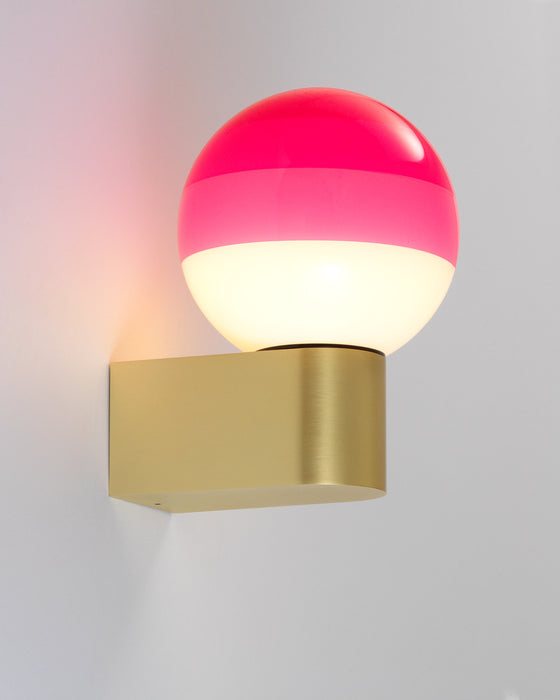

Dipping Light wall lamp
This version of the wall light allows you to choose the finish of the box between gold and graphite.
Dipping Light was born from the experiment of dipping a lit light bulb into paint repeatedly, transforming it into a lamp. By doing this, the different layers of paint draw concentric circles and trap the light, dimming its intensity. The paint becomes a shade, giving color to the light and adding texture. A brass base is designed as a support. This artisanal process makes each lamp unique and exclusive.
Beyond its function as a lamp, Dipping Light seeks to create emotion. When lit, it is mesmerizing, as its different shades of paint filter the light, creating a magical effect in the room. When unlit, it transforms into a colored glass sphere, making it an object of great aesthetic value.


Dipping Light wall lamp
This version of the wall light allows you to choose the finish of the box between gold and graphite.
Dipping Light was born from the experiment of dipping a lit light bulb into paint repeatedly, transforming it into a lamp. By doing this, the different layers of paint draw concentric circles and trap the light, dimming its intensity. The paint becomes a shade, giving color to the light and adding texture. A brass base is designed as a support. This artisanal process makes each lamp unique and exclusive.
Beyond its function as a lamp, Dipping Light seeks to create emotion. When lit, it is mesmerizing, as its different shades of paint filter the light, creating a magical effect in the room. When unlit, it transforms into a colored glass sphere, making it an object of great aesthetic value.


Dipping Light M table lamp
In this version, the largest of the three sizes offered by the poetic Dipping Light lamp, the base comes in two finishes: brushed brass or graphite. The shade's available colors remain the same.
Dipping Light was born from the experiment of dipping a lit light bulb into paint repeatedly, transforming it into a lamp. By doing this, the different layers of paint draw concentric circles and trap the light, dimming its intensity. The paint becomes a shade, giving color to the light and adding texture. A brass base is designed as a support. This artisanal process makes each lamp unique and exclusive.
Beyond its function as a lamp, Dipping Light seeks to create emotion. When lit, it is mesmerizing, as its different shades of paint filter the light, creating a magical effect in the room. When unlit, it transforms into a colored glass sphere, making it an object of great aesthetic value.
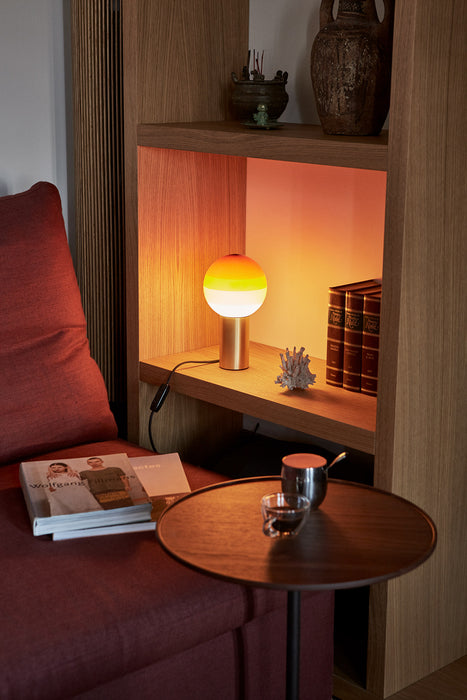

Dipping Light M table lamp
In this version, the largest of the three sizes offered by the poetic Dipping Light lamp, the base comes in two finishes: brushed brass or graphite. The shade's available colors remain the same.
Dipping Light was born from the experiment of dipping a lit light bulb into paint repeatedly, transforming it into a lamp. By doing this, the different layers of paint draw concentric circles and trap the light, dimming its intensity. The paint becomes a shade, giving color to the light and adding texture. A brass base is designed as a support. This artisanal process makes each lamp unique and exclusive.
Beyond its function as a lamp, Dipping Light seeks to create emotion. When lit, it is mesmerizing, as its different shades of paint filter the light, creating a magical effect in the room. When unlit, it transforms into a colored glass sphere, making it an object of great aesthetic value.


Dipping Light M table lamp
In this version, the largest of the three sizes offered by the poetic Dipping Light lamp, the base comes in two finishes: brushed brass or graphite. The shade's available colors remain the same.
Dipping Light was born from the experiment of dipping a lit light bulb into paint repeatedly, transforming it into a lamp. By doing this, the different layers of paint draw concentric circles and trap the light, dimming its intensity. The paint becomes a shade, giving color to the light and adding texture. A brass base is designed as a support. This artisanal process makes each lamp unique and exclusive.
Beyond its function as a lamp, Dipping Light seeks to create emotion. When lit, it is mesmerizing, as its different shades of paint filter the light, creating a magical effect in the room. When unlit, it transforms into a colored glass sphere, making it an object of great aesthetic value.
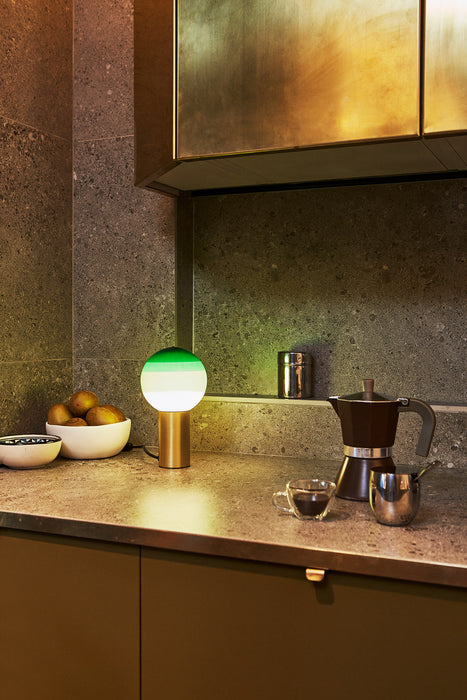

Dipping Light M table lamp
In this version, the largest of the three sizes offered by the poetic Dipping Light lamp, the base comes in two finishes: brushed brass or graphite. The shade's available colors remain the same.
Dipping Light was born from the experiment of dipping a lit light bulb into paint repeatedly, transforming it into a lamp. By doing this, the different layers of paint draw concentric circles and trap the light, dimming its intensity. The paint becomes a shade, giving color to the light and adding texture. A brass base is designed as a support. This artisanal process makes each lamp unique and exclusive.
Beyond its function as a lamp, Dipping Light seeks to create emotion. When lit, it is mesmerizing, as its different shades of paint filter the light, creating a magical effect in the room. When unlit, it transforms into a colored glass sphere, making it an object of great aesthetic value.
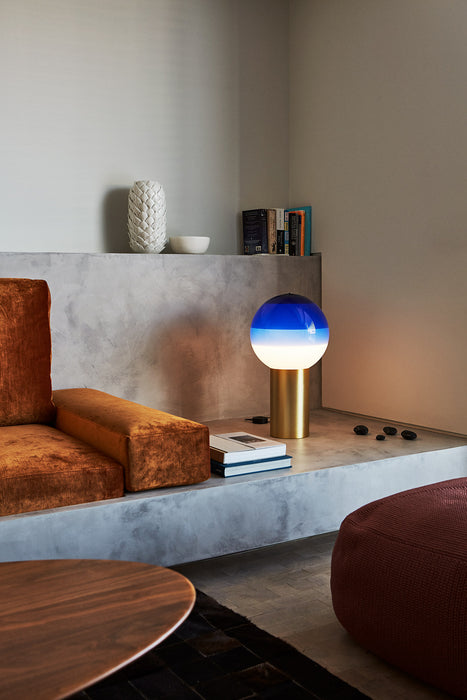

Dipping Light M table lamp
In this version, the largest of the three sizes offered by the poetic Dipping Light lamp, the base comes in two finishes: brushed brass or graphite. The shade's available colors remain the same.
Dipping Light was born from the experiment of dipping a lit light bulb into paint repeatedly, transforming it into a lamp. By doing this, the different layers of paint draw concentric circles and trap the light, dimming its intensity. The paint becomes a shade, giving color to the light and adding texture. A brass base is designed as a support. This artisanal process makes each lamp unique and exclusive.
Beyond its function as a lamp, Dipping Light seeks to create emotion. When lit, it is mesmerizing, as its different shades of paint filter the light, creating a magical effect in the room. When unlit, it transforms into a colored glass sphere, making it an object of great aesthetic value.
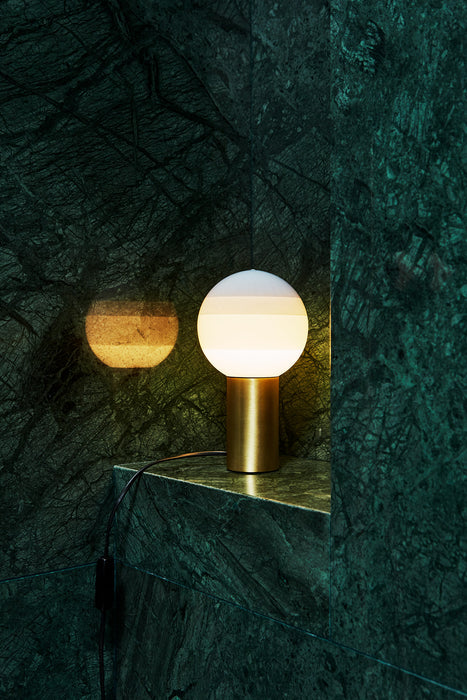

Dipping Light M table lamp
In this version, the largest of the three sizes offered by the poetic Dipping Light lamp, the base comes in two finishes: brushed brass or graphite. The shade's available colors remain the same.
Dipping Light was born from the experiment of dipping a lit light bulb into paint repeatedly, transforming it into a lamp. By doing this, the different layers of paint draw concentric circles and trap the light, dimming its intensity. The paint becomes a shade, giving color to the light and adding texture. A brass base is designed as a support. This artisanal process makes each lamp unique and exclusive.
Beyond its function as a lamp, Dipping Light seeks to create emotion. When lit, it is mesmerizing, as its different shades of paint filter the light, creating a magical effect in the room. When unlit, it transforms into a colored glass sphere, making it an object of great aesthetic value.


Dipping Light M table lamp
In this version, the largest of the three sizes offered by the poetic Dipping Light lamp, the base comes in two finishes: brushed brass or graphite. The shade's available colors remain the same.
Dipping Light was born from the experiment of dipping a lit light bulb into paint repeatedly, transforming it into a lamp. By doing this, the different layers of paint draw concentric circles and trap the light, dimming its intensity. The paint becomes a shade, giving color to the light and adding texture. A brass base is designed as a support. This artisanal process makes each lamp unique and exclusive.
Beyond its function as a lamp, Dipping Light seeks to create emotion. When lit, it is mesmerizing, as its different shades of paint filter the light, creating a magical effect in the room. When unlit, it transforms into a colored glass sphere, making it an object of great aesthetic value.


Dipping Light M table lamp
In this version, the largest of the three sizes offered by the poetic Dipping Light lamp, the base comes in two finishes: brushed brass or graphite. The shade's available colors remain the same.
Dipping Light was born from the experiment of dipping a lit light bulb into paint repeatedly, transforming it into a lamp. By doing this, the different layers of paint draw concentric circles and trap the light, dimming its intensity. The paint becomes a shade, giving color to the light and adding texture. A brass base is designed as a support. This artisanal process makes each lamp unique and exclusive.
Beyond its function as a lamp, Dipping Light seeks to create emotion. When lit, it is mesmerizing, as its different shades of paint filter the light, creating a magical effect in the room. When unlit, it transforms into a colored glass sphere, making it an object of great aesthetic value.
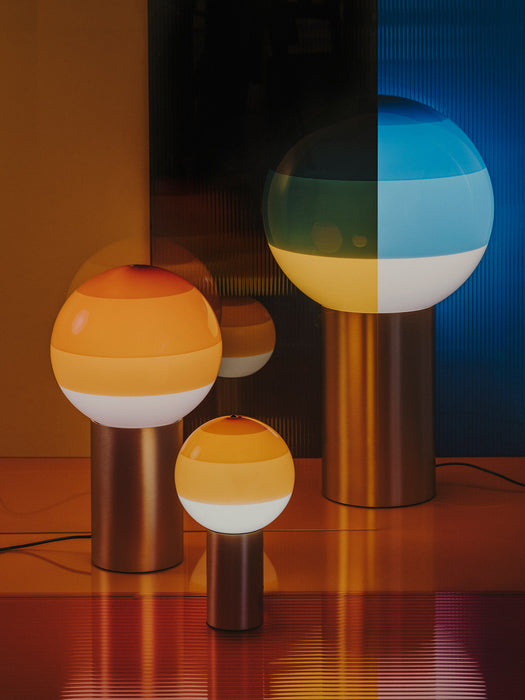

Dipping Light M table lamp
In this version, the largest of the three sizes offered by the poetic Dipping Light lamp, the base comes in two finishes: brushed brass or graphite. The shade's available colors remain the same.
Dipping Light was born from the experiment of dipping a lit light bulb into paint repeatedly, transforming it into a lamp. By doing this, the different layers of paint draw concentric circles and trap the light, dimming its intensity. The paint becomes a shade, giving color to the light and adding texture. A brass base is designed as a support. This artisanal process makes each lamp unique and exclusive.
Beyond its function as a lamp, Dipping Light seeks to create emotion. When lit, it is mesmerizing, as its different shades of paint filter the light, creating a magical effect in the room. When unlit, it transforms into a colored glass sphere, making it an object of great aesthetic value.
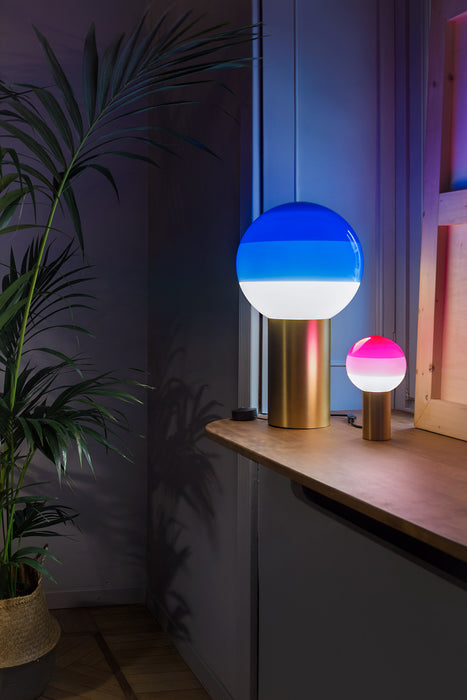

Dipping Light M table lamp
In this version, the largest of the three sizes offered by the poetic Dipping Light lamp, the base comes in two finishes: brushed brass or graphite. The shade's available colors remain the same.
Dipping Light was born from the experiment of dipping a lit light bulb into paint repeatedly, transforming it into a lamp. By doing this, the different layers of paint draw concentric circles and trap the light, dimming its intensity. The paint becomes a shade, giving color to the light and adding texture. A brass base is designed as a support. This artisanal process makes each lamp unique and exclusive.
Beyond its function as a lamp, Dipping Light seeks to create emotion. When lit, it is mesmerizing, as its different shades of paint filter the light, creating a magical effect in the room. When unlit, it transforms into a colored glass sphere, making it an object of great aesthetic value.


Dipping Light S table lamp
In this version, the medium of the three sizes offered by the poetic Dipping Light lamp, the base comes in two finishes: brushed brass or graphite. The available colors for the shade remain the same.
Dipping Light was born from the experiment of dipping a lit light bulb into paint repeatedly, transforming it into a lamp. By doing this, the different layers of paint draw concentric circles and trap the light, dimming its intensity. The paint becomes a shade, giving color to the light and adding texture. A brass base is designed as a support. This artisanal process makes each lamp unique and exclusive.
Beyond its function as a lamp, Dipping Light seeks to create emotion. When lit, it is mesmerizing, as its different shades of paint filter the light, creating a magical effect in the room. When unlit, it transforms into a colored glass sphere, making it an object of great aesthetic value.


Dipping Light S table lamp
In this version, the medium of the three sizes offered by the poetic Dipping Light lamp, the base comes in two finishes: brushed brass or graphite. The available colors for the shade remain the same.
Dipping Light was born from the experiment of dipping a lit light bulb into paint repeatedly, transforming it into a lamp. By doing this, the different layers of paint draw concentric circles and trap the light, dimming its intensity. The paint becomes a shade, giving color to the light and adding texture. A brass base is designed as a support. This artisanal process makes each lamp unique and exclusive.
Beyond its function as a lamp, Dipping Light seeks to create emotion. When lit, it is mesmerizing, as its different shades of paint filter the light, creating a magical effect in the room. When unlit, it transforms into a colored glass sphere, making it an object of great aesthetic value.


Dipping Light S table lamp
In this version, the medium of the three sizes offered by the poetic Dipping Light lamp, the base comes in two finishes: brushed brass or graphite. The available colors for the shade remain the same.
Dipping Light was born from the experiment of dipping a lit light bulb into paint repeatedly, transforming it into a lamp. By doing this, the different layers of paint draw concentric circles and trap the light, dimming its intensity. The paint becomes a shade, giving color to the light and adding texture. A brass base is designed as a support. This artisanal process makes each lamp unique and exclusive.
Beyond its function as a lamp, Dipping Light seeks to create emotion. When lit, it is mesmerizing, as its different shades of paint filter the light, creating a magical effect in the room. When unlit, it transforms into a colored glass sphere, making it an object of great aesthetic value.
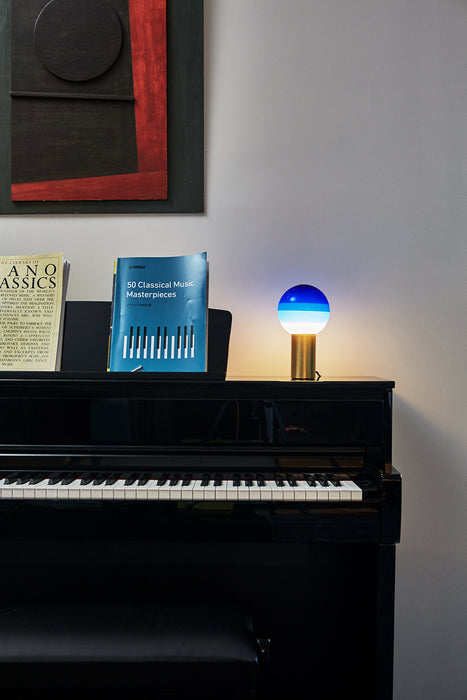

Dipping Light S table lamp
In this version, the medium of the three sizes offered by the poetic Dipping Light lamp, the base comes in two finishes: brushed brass or graphite. The available colors for the shade remain the same.
Dipping Light was born from the experiment of dipping a lit light bulb into paint repeatedly, transforming it into a lamp. By doing this, the different layers of paint draw concentric circles and trap the light, dimming its intensity. The paint becomes a shade, giving color to the light and adding texture. A brass base is designed as a support. This artisanal process makes each lamp unique and exclusive.
Beyond its function as a lamp, Dipping Light seeks to create emotion. When lit, it is mesmerizing, as its different shades of paint filter the light, creating a magical effect in the room. When unlit, it transforms into a colored glass sphere, making it an object of great aesthetic value.


Dipping Light S table lamp
In this version, the medium of the three sizes offered by the poetic Dipping Light lamp, the base comes in two finishes: brushed brass or graphite. The available colors for the shade remain the same.
Dipping Light was born from the experiment of dipping a lit light bulb into paint repeatedly, transforming it into a lamp. By doing this, the different layers of paint draw concentric circles and trap the light, dimming its intensity. The paint becomes a shade, giving color to the light and adding texture. A brass base is designed as a support. This artisanal process makes each lamp unique and exclusive.
Beyond its function as a lamp, Dipping Light seeks to create emotion. When lit, it is mesmerizing, as its different shades of paint filter the light, creating a magical effect in the room. When unlit, it transforms into a colored glass sphere, making it an object of great aesthetic value.
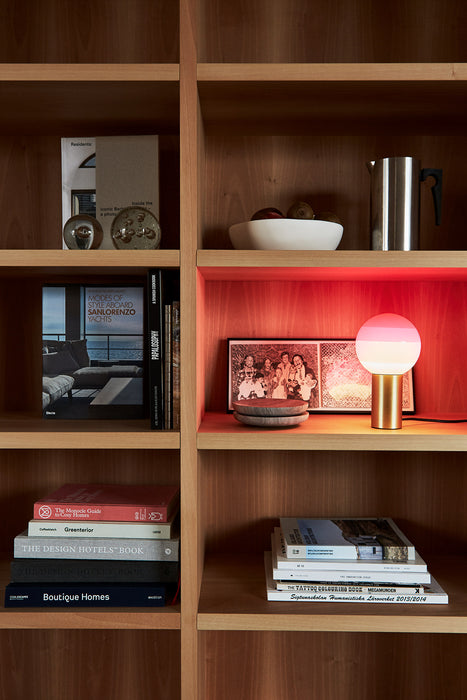

Dipping Light S table lamp
In this version, the medium of the three sizes offered by the poetic Dipping Light lamp, the base comes in two finishes: brushed brass or graphite. The available colors for the shade remain the same.
Dipping Light was born from the experiment of dipping a lit light bulb into paint repeatedly, transforming it into a lamp. By doing this, the different layers of paint draw concentric circles and trap the light, dimming its intensity. The paint becomes a shade, giving color to the light and adding texture. A brass base is designed as a support. This artisanal process makes each lamp unique and exclusive.
Beyond its function as a lamp, Dipping Light seeks to create emotion. When lit, it is mesmerizing, as its different shades of paint filter the light, creating a magical effect in the room. When unlit, it transforms into a colored glass sphere, making it an object of great aesthetic value.


Dipping Light S table lamp
In this version, the medium of the three sizes offered by the poetic Dipping Light lamp, the base comes in two finishes: brushed brass or graphite. The available colors for the shade remain the same.
Dipping Light was born from the experiment of dipping a lit light bulb into paint repeatedly, transforming it into a lamp. By doing this, the different layers of paint draw concentric circles and trap the light, dimming its intensity. The paint becomes a shade, giving color to the light and adding texture. A brass base is designed as a support. This artisanal process makes each lamp unique and exclusive.
Beyond its function as a lamp, Dipping Light seeks to create emotion. When lit, it is mesmerizing, as its different shades of paint filter the light, creating a magical effect in the room. When unlit, it transforms into a colored glass sphere, making it an object of great aesthetic value.


Dipping Light S table lamp
In this version, the medium of the three sizes offered by the poetic Dipping Light lamp, the base comes in two finishes: brushed brass or graphite. The available colors for the shade remain the same.
Dipping Light was born from the experiment of dipping a lit light bulb into paint repeatedly, transforming it into a lamp. By doing this, the different layers of paint draw concentric circles and trap the light, dimming its intensity. The paint becomes a shade, giving color to the light and adding texture. A brass base is designed as a support. This artisanal process makes each lamp unique and exclusive.
Beyond its function as a lamp, Dipping Light seeks to create emotion. When lit, it is mesmerizing, as its different shades of paint filter the light, creating a magical effect in the room. When unlit, it transforms into a colored glass sphere, making it an object of great aesthetic value.
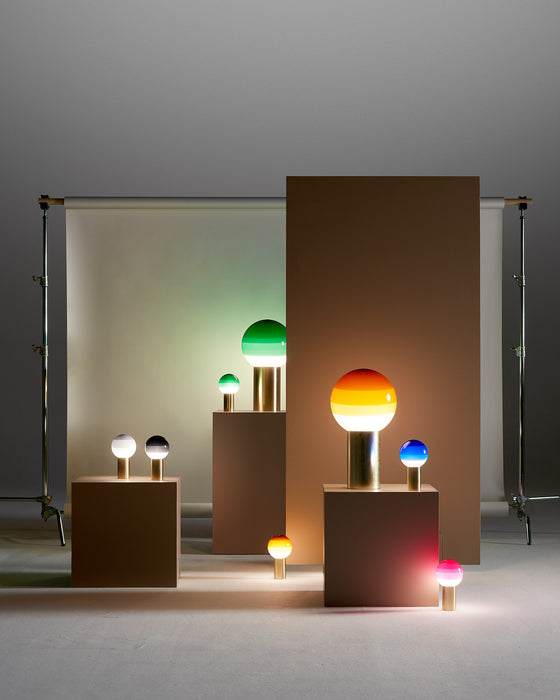

Dipping Light S table lamp
In this version, the medium of the three sizes offered by the poetic Dipping Light lamp, the base comes in two finishes: brushed brass or graphite. The available colors for the shade remain the same.
Dipping Light was born from the experiment of dipping a lit light bulb into paint repeatedly, transforming it into a lamp. By doing this, the different layers of paint draw concentric circles and trap the light, dimming its intensity. The paint becomes a shade, giving color to the light and adding texture. A brass base is designed as a support. This artisanal process makes each lamp unique and exclusive.
Beyond its function as a lamp, Dipping Light seeks to create emotion. When lit, it is mesmerizing, as its different shades of paint filter the light, creating a magical effect in the room. When unlit, it transforms into a colored glass sphere, making it an object of great aesthetic value.
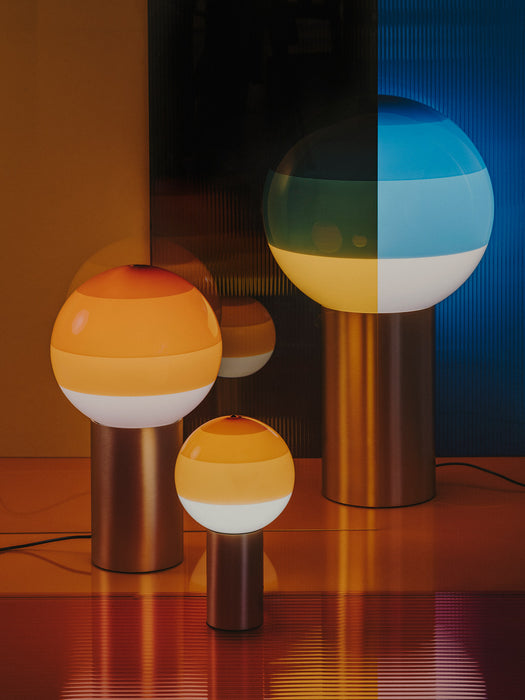

Dipping Light S table lamp
In this version, the medium of the three sizes offered by the poetic Dipping Light lamp, the base comes in two finishes: brushed brass or graphite. The available colors for the shade remain the same.
Dipping Light was born from the experiment of dipping a lit light bulb into paint repeatedly, transforming it into a lamp. By doing this, the different layers of paint draw concentric circles and trap the light, dimming its intensity. The paint becomes a shade, giving color to the light and adding texture. A brass base is designed as a support. This artisanal process makes each lamp unique and exclusive.
Beyond its function as a lamp, Dipping Light seeks to create emotion. When lit, it is mesmerizing, as its different shades of paint filter the light, creating a magical effect in the room. When unlit, it transforms into a colored glass sphere, making it an object of great aesthetic value.
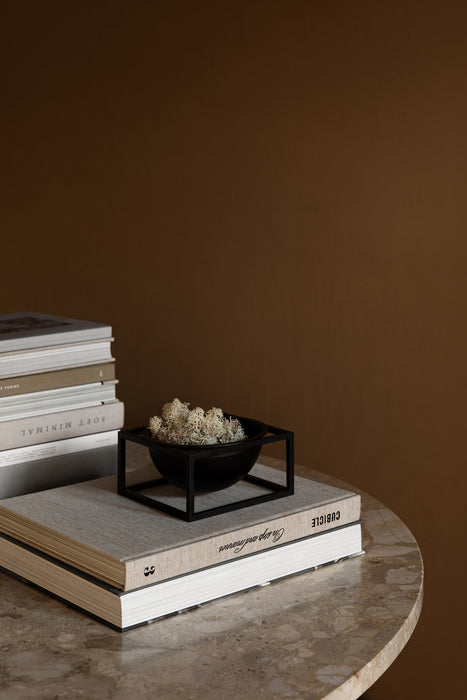

Kubus Bowl Centerpiece
The Kubus table scepter works perfectly as a container or as a decorative object. Its design is based on simple geometric shapes: a square and a circle.
Placed on a sideboard, a shelf, or as a centerpiece, it can also be used as a planter or display for fruits and vegetables. Each bowl includes a protective coating that makes it suitable for use with both plants and food.
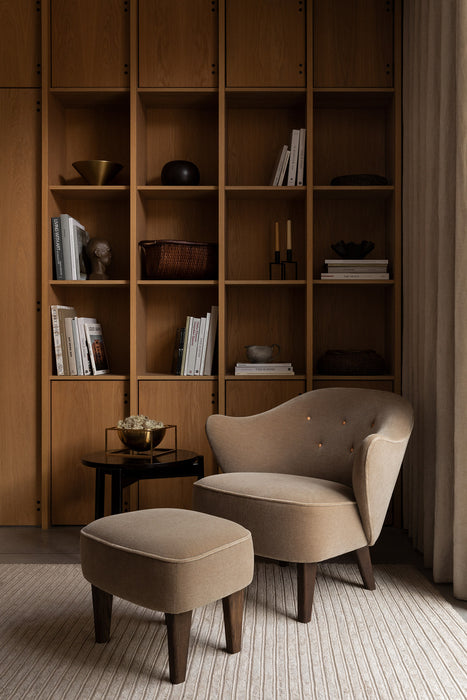

Kubus Bowl Centerpiece
The Kubus table scepter works perfectly as a container or as a decorative object. Its design is based on simple geometric shapes: a square and a circle.
Placed on a sideboard, a shelf, or as a centerpiece, it can also be used as a planter or display for fruits and vegetables. Each bowl includes a protective coating that makes it suitable for use with both plants and food.
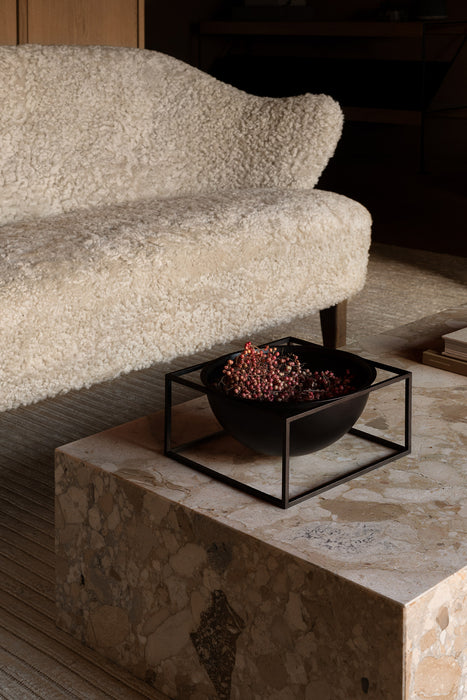

Kubus Bowl Centerpiece
The Kubus table scepter works perfectly as a container or as a decorative object. Its design is based on simple geometric shapes: a square and a circle.
Placed on a sideboard, a shelf, or as a centerpiece, it can also be used as a planter or display for fruits and vegetables. Each bowl includes a protective coating that makes it suitable for use with both plants and food.
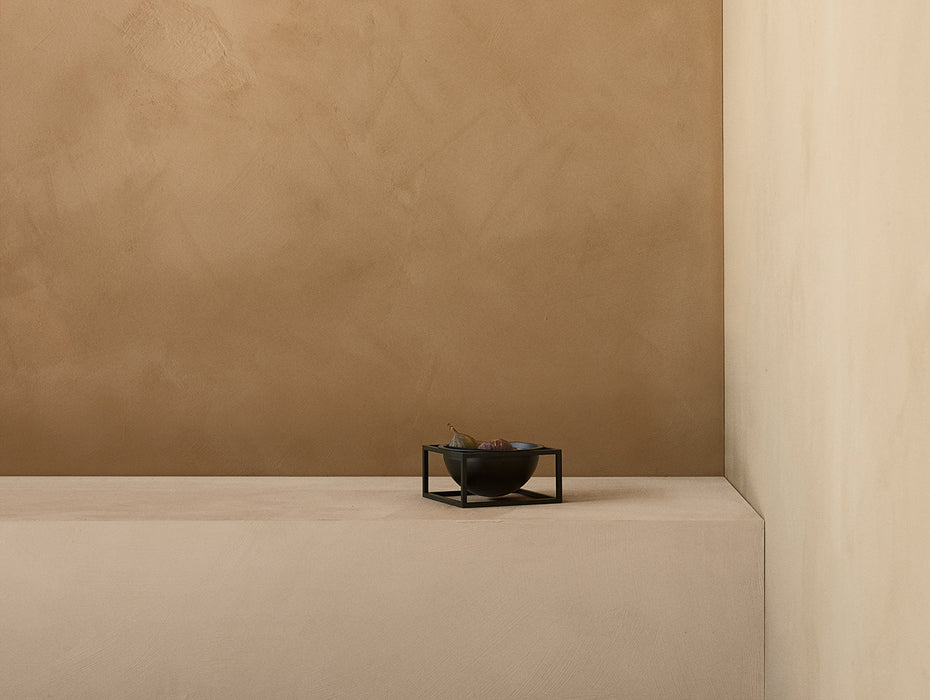

Kubus Bowl Centerpiece
The Kubus table scepter works perfectly as a container or as a decorative object. Its design is based on simple geometric shapes: a square and a circle.
Placed on a sideboard, a shelf, or as a centerpiece, it can also be used as a planter or display for fruits and vegetables. Each bowl includes a protective coating that makes it suitable for use with both plants and food.
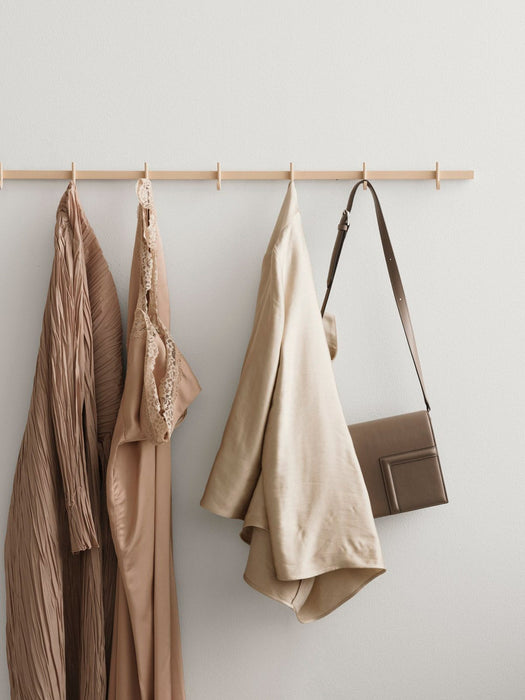

Large Relief Coat Rack
The Relief coat rack consists of a finely textured lacquered aluminum bar with hooks for hanging. This accessory from the Relief collection is available in three different sizes to fit the width of the Relief chests. This version measures 123 cm, the same width as the Relief low chest.
The new Relief system is composed of chests of drawers in various sizes and five different finish colors. These pieces can be connected to each other to form new arrangements with different dimensions and finishes. Every element of these chests, including the back, has been meticulously designed. This makes them ideal for use as room dividers as well. String Furniture 's Relief chests are functional both as standalone pieces and as connecting pieces to form larger groups of drawers.
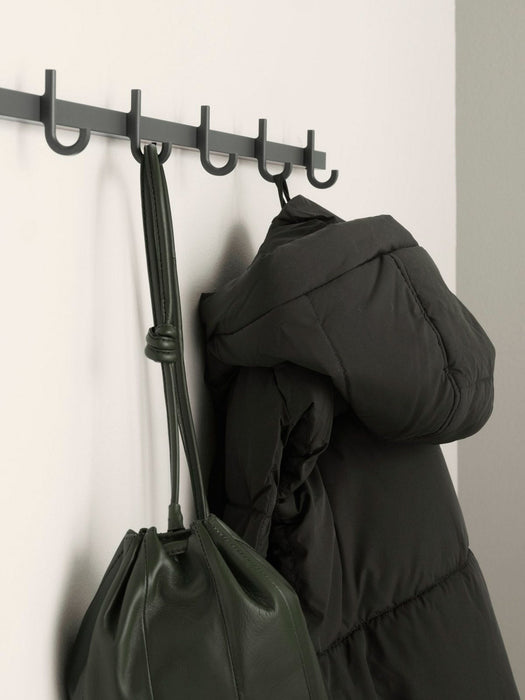

Large Relief Coat Rack
The Relief coat rack consists of a finely textured lacquered aluminum bar with hooks for hanging. This accessory from the Relief collection is available in three different sizes to fit the width of the Relief chests. This version measures 123 cm, the same width as the Relief low chest.
The new Relief system is composed of chests of drawers in various sizes and five different finish colors. These pieces can be connected to each other to form new arrangements with different dimensions and finishes. Every element of these chests, including the back, has been meticulously designed. This makes them ideal for use as room dividers as well. String Furniture 's Relief chests are functional both as standalone pieces and as connecting pieces to form larger groups of drawers.
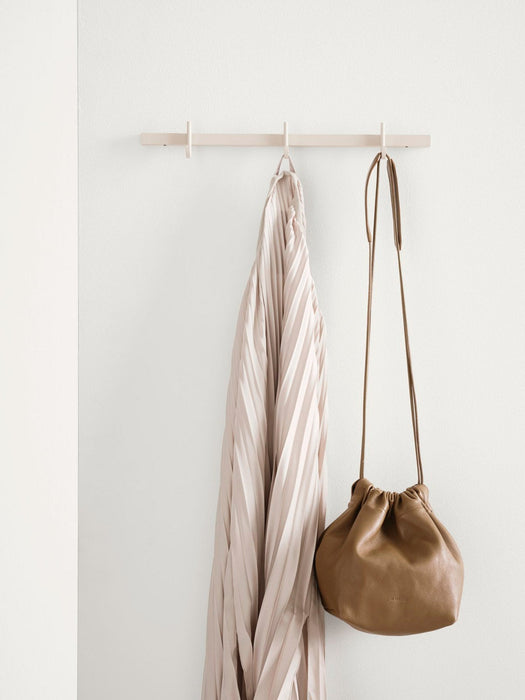

Large Relief Coat Rack
The Relief coat rack consists of a finely textured lacquered aluminum bar with hooks for hanging. This accessory from the Relief collection is available in three different sizes to fit the width of the Relief chests. This version measures 123 cm, the same width as the Relief low chest.
The new Relief system is composed of chests of drawers in various sizes and five different finish colors. These pieces can be connected to each other to form new arrangements with different dimensions and finishes. Every element of these chests, including the back, has been meticulously designed. This makes them ideal for use as room dividers as well. String Furniture 's Relief chests are functional both as standalone pieces and as connecting pieces to form larger groups of drawers.
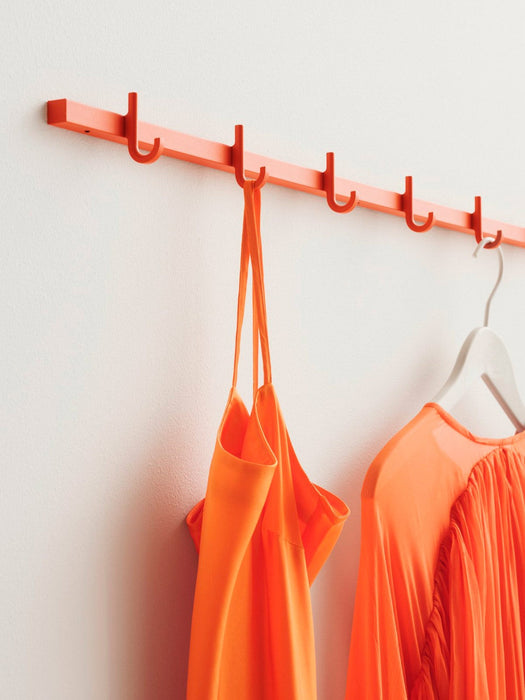

Large Relief Coat Rack
The Relief coat rack consists of a finely textured lacquered aluminum bar with hooks for hanging. This accessory from the Relief collection is available in three different sizes to fit the width of the Relief chests. This version measures 123 cm, the same width as the Relief low chest.
The new Relief system is composed of chests of drawers in various sizes and five different finish colors. These pieces can be connected to each other to form new arrangements with different dimensions and finishes. Every element of these chests, including the back, has been meticulously designed. This makes them ideal for use as room dividers as well. String Furniture 's Relief chests are functional both as standalone pieces and as connecting pieces to form larger groups of drawers.
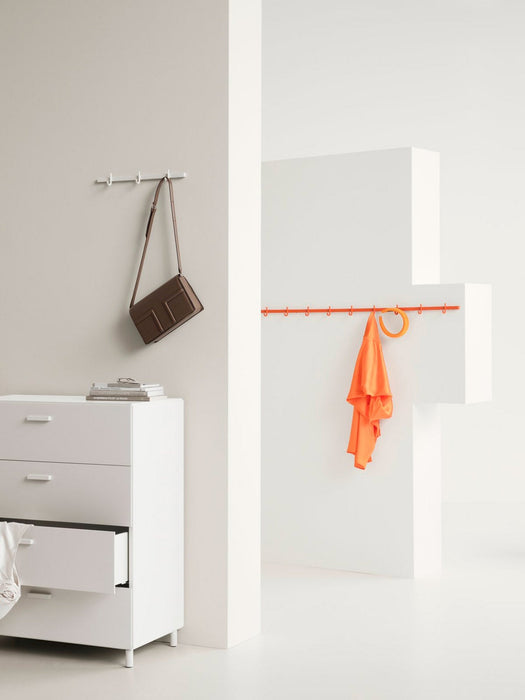

Large Relief Coat Rack
The Relief coat rack consists of a finely textured lacquered aluminum bar with hooks for hanging. This accessory from the Relief collection is available in three different sizes to fit the width of the Relief chests. This version measures 123 cm, the same width as the Relief low chest.
The new Relief system is composed of chests of drawers in various sizes and five different finish colors. These pieces can be connected to each other to form new arrangements with different dimensions and finishes. Every element of these chests, including the back, has been meticulously designed. This makes them ideal for use as room dividers as well. String Furniture 's Relief chests are functional both as standalone pieces and as connecting pieces to form larger groups of drawers.
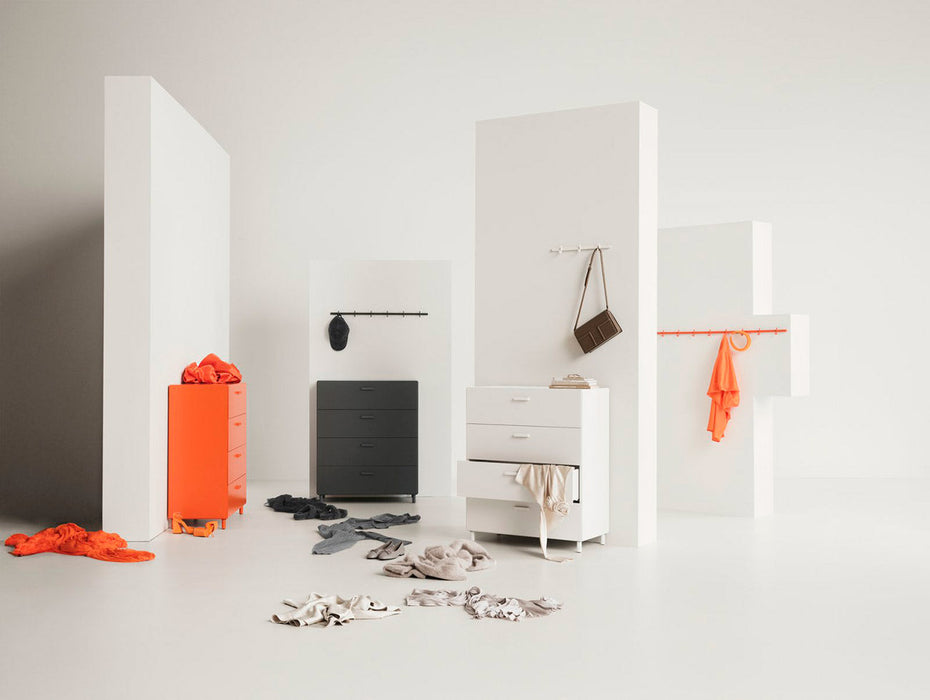

Large Relief Coat Rack
The Relief coat rack consists of a finely textured lacquered aluminum bar with hooks for hanging. This accessory from the Relief collection is available in three different sizes to fit the width of the Relief chests. This version measures 123 cm, the same width as the Relief low chest.
The new Relief system is composed of chests of drawers in various sizes and five different finish colors. These pieces can be connected to each other to form new arrangements with different dimensions and finishes. Every element of these chests, including the back, has been meticulously designed. This makes them ideal for use as room dividers as well. String Furniture 's Relief chests are functional both as standalone pieces and as connecting pieces to form larger groups of drawers.
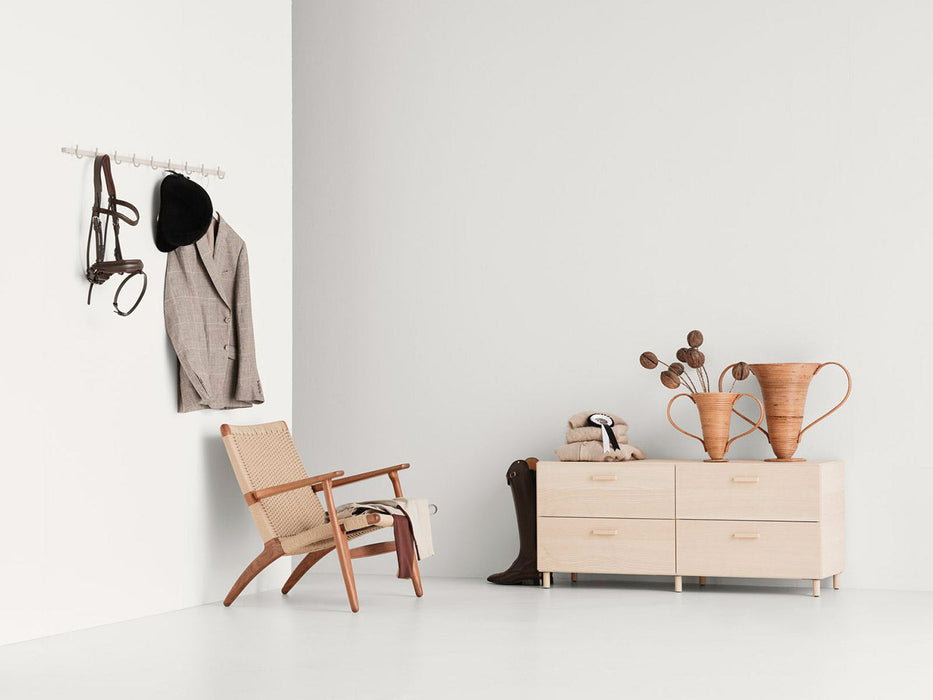

Large Relief Coat Rack
The Relief coat rack consists of a finely textured lacquered aluminum bar with hooks for hanging. This accessory from the Relief collection is available in three different sizes to fit the width of the Relief chests. This version measures 123 cm, the same width as the Relief low chest.
The new Relief system is composed of chests of drawers in various sizes and five different finish colors. These pieces can be connected to each other to form new arrangements with different dimensions and finishes. Every element of these chests, including the back, has been meticulously designed. This makes them ideal for use as room dividers as well. String Furniture 's Relief chests are functional both as standalone pieces and as connecting pieces to form larger groups of drawers.
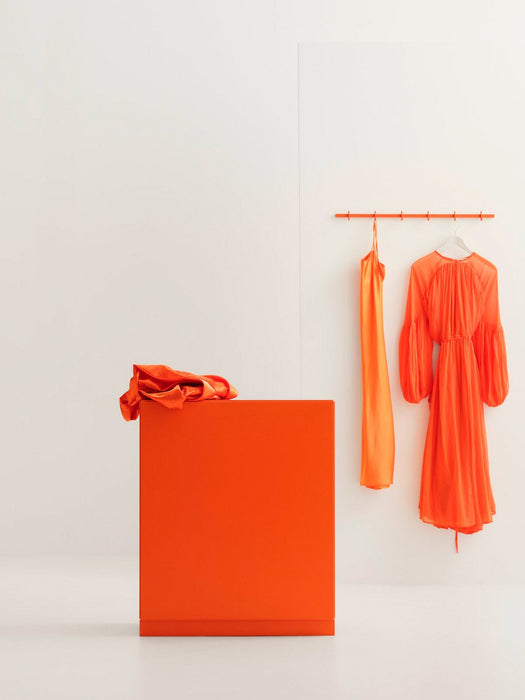

Large Relief Coat Rack
The Relief coat rack consists of a finely textured lacquered aluminum bar with hooks for hanging. This accessory from the Relief collection is available in three different sizes to fit the width of the Relief chests. This version measures 123 cm, the same width as the Relief low chest.
The new Relief system is composed of chests of drawers in various sizes and five different finish colors. These pieces can be connected to each other to form new arrangements with different dimensions and finishes. Every element of these chests, including the back, has been meticulously designed. This makes them ideal for use as room dividers as well. String Furniture 's Relief chests are functional both as standalone pieces and as connecting pieces to form larger groups of drawers.


Relief tall dresser with legs
The Relief tall five-drawer chest invites creativity thanks to its configuration possibilities. It is available in five finish colors. The interior dimensions of each drawer are 33 x 36.3 x 17 cm.
The new Relief system is composed of chests of drawers in various sizes and five different finish colors. These pieces can be connected to each other to form new arrangements with different dimensions and finishes. Every element of these chests, including the back, has been meticulously designed. This makes them ideal for use as room dividers as well. String Furniture 's Relief chests are functional both as standalone pieces and as connecting pieces to form larger groups of drawers.


Relief tall dresser with legs
The Relief tall five-drawer chest invites creativity thanks to its configuration possibilities. It is available in five finish colors. The interior dimensions of each drawer are 33 x 36.3 x 17 cm.
The new Relief system is composed of chests of drawers in various sizes and five different finish colors. These pieces can be connected to each other to form new arrangements with different dimensions and finishes. Every element of these chests, including the back, has been meticulously designed. This makes them ideal for use as room dividers as well. String Furniture 's Relief chests are functional both as standalone pieces and as connecting pieces to form larger groups of drawers.


Relief tall dresser with legs
The Relief tall five-drawer chest invites creativity thanks to its configuration possibilities. It is available in five finish colors. The interior dimensions of each drawer are 33 x 36.3 x 17 cm.
The new Relief system is composed of chests of drawers in various sizes and five different finish colors. These pieces can be connected to each other to form new arrangements with different dimensions and finishes. Every element of these chests, including the back, has been meticulously designed. This makes them ideal for use as room dividers as well. String Furniture 's Relief chests are functional both as standalone pieces and as connecting pieces to form larger groups of drawers.


Relief tall dresser with legs
The Relief tall five-drawer chest invites creativity thanks to its configuration possibilities. It is available in five finish colors. The interior dimensions of each drawer are 33 x 36.3 x 17 cm.
The new Relief system is composed of chests of drawers in various sizes and five different finish colors. These pieces can be connected to each other to form new arrangements with different dimensions and finishes. Every element of these chests, including the back, has been meticulously designed. This makes them ideal for use as room dividers as well. String Furniture 's Relief chests are functional both as standalone pieces and as connecting pieces to form larger groups of drawers.


Relief tall dresser with legs
The Relief tall five-drawer chest invites creativity thanks to its configuration possibilities. It is available in five finish colors. The interior dimensions of each drawer are 33 x 36.3 x 17 cm.
The new Relief system is composed of chests of drawers in various sizes and five different finish colors. These pieces can be connected to each other to form new arrangements with different dimensions and finishes. Every element of these chests, including the back, has been meticulously designed. This makes them ideal for use as room dividers as well. String Furniture 's Relief chests are functional both as standalone pieces and as connecting pieces to form larger groups of drawers.


Relief tall dresser with legs
The Relief tall five-drawer chest invites creativity thanks to its configuration possibilities. It is available in five finish colors. The interior dimensions of each drawer are 33 x 36.3 x 17 cm.
The new Relief system is composed of chests of drawers in various sizes and five different finish colors. These pieces can be connected to each other to form new arrangements with different dimensions and finishes. Every element of these chests, including the back, has been meticulously designed. This makes them ideal for use as room dividers as well. String Furniture 's Relief chests are functional both as standalone pieces and as connecting pieces to form larger groups of drawers.


Relief tall dresser with legs
The Relief tall five-drawer chest invites creativity thanks to its configuration possibilities. It is available in five finish colors. The interior dimensions of each drawer are 33 x 36.3 x 17 cm.
The new Relief system is composed of chests of drawers in various sizes and five different finish colors. These pieces can be connected to each other to form new arrangements with different dimensions and finishes. Every element of these chests, including the back, has been meticulously designed. This makes them ideal for use as room dividers as well. String Furniture 's Relief chests are functional both as standalone pieces and as connecting pieces to form larger groups of drawers.


Relief tall dresser with legs
The Relief tall five-drawer chest invites creativity thanks to its configuration possibilities. It is available in five finish colors. The interior dimensions of each drawer are 33 x 36.3 x 17 cm.
The new Relief system is composed of chests of drawers in various sizes and five different finish colors. These pieces can be connected to each other to form new arrangements with different dimensions and finishes. Every element of these chests, including the back, has been meticulously designed. This makes them ideal for use as room dividers as well. String Furniture 's Relief chests are functional both as standalone pieces and as connecting pieces to form larger groups of drawers.


Relief tall dresser with legs
The Relief tall five-drawer chest invites creativity thanks to its configuration possibilities. It is available in five finish colors. The interior dimensions of each drawer are 33 x 36.3 x 17 cm.
The new Relief system is composed of chests of drawers in various sizes and five different finish colors. These pieces can be connected to each other to form new arrangements with different dimensions and finishes. Every element of these chests, including the back, has been meticulously designed. This makes them ideal for use as room dividers as well. String Furniture 's Relief chests are functional both as standalone pieces and as connecting pieces to form larger groups of drawers.


Relief tall dresser with legs
The Relief tall five-drawer chest invites creativity thanks to its configuration possibilities. It is available in five finish colors. The interior dimensions of each drawer are 33 x 36.3 x 17 cm.
The new Relief system is composed of chests of drawers in various sizes and five different finish colors. These pieces can be connected to each other to form new arrangements with different dimensions and finishes. Every element of these chests, including the back, has been meticulously designed. This makes them ideal for use as room dividers as well. String Furniture 's Relief chests are functional both as standalone pieces and as connecting pieces to form larger groups of drawers.


Relief tall dresser with legs
The Relief tall five-drawer chest invites creativity thanks to its configuration possibilities. It is available in five finish colors. The interior dimensions of each drawer are 33 x 36.3 x 17 cm.
The new Relief system is composed of chests of drawers in various sizes and five different finish colors. These pieces can be connected to each other to form new arrangements with different dimensions and finishes. Every element of these chests, including the back, has been meticulously designed. This makes them ideal for use as room dividers as well. String Furniture 's Relief chests are functional both as standalone pieces and as connecting pieces to form larger groups of drawers.


Relief tall dresser with legs
The Relief tall five-drawer chest invites creativity thanks to its configuration possibilities. It is available in five finish colors. The interior dimensions of each drawer are 33 x 36.3 x 17 cm.
The new Relief system is composed of chests of drawers in various sizes and five different finish colors. These pieces can be connected to each other to form new arrangements with different dimensions and finishes. Every element of these chests, including the back, has been meticulously designed. This makes them ideal for use as room dividers as well. String Furniture 's Relief chests are functional both as standalone pieces and as connecting pieces to form larger groups of drawers.


Relief low chest of drawers with legs
The Relief low four-drawer dresser invites creativity thanks to its configuration possibilities. It is available in five finish colors. The interior dimensions of each drawer are 54 x 36.3 x 17 cm.
The new Relief system is composed of chests of drawers in various sizes and five different finish colors. These pieces can be connected to each other to form new arrangements with different dimensions and finishes. Every element of these chests, including the back, has been meticulously designed. This makes them ideal for use as room dividers as well. String Furniture 's Relief chests are functional both as standalone pieces and as connecting pieces to form larger groups of drawers.


Relief low chest of drawers with legs
The Relief low four-drawer dresser invites creativity thanks to its configuration possibilities. It is available in five finish colors. The interior dimensions of each drawer are 54 x 36.3 x 17 cm.
The new Relief system is composed of chests of drawers in various sizes and five different finish colors. These pieces can be connected to each other to form new arrangements with different dimensions and finishes. Every element of these chests, including the back, has been meticulously designed. This makes them ideal for use as room dividers as well. String Furniture 's Relief chests are functional both as standalone pieces and as connecting pieces to form larger groups of drawers.


Relief low chest of drawers with legs
The Relief low four-drawer dresser invites creativity thanks to its configuration possibilities. It is available in five finish colors. The interior dimensions of each drawer are 54 x 36.3 x 17 cm.
The new Relief system is composed of chests of drawers in various sizes and five different finish colors. These pieces can be connected to each other to form new arrangements with different dimensions and finishes. Every element of these chests, including the back, has been meticulously designed. This makes them ideal for use as room dividers as well. String Furniture 's Relief chests are functional both as standalone pieces and as connecting pieces to form larger groups of drawers.


Relief low chest of drawers with legs
The Relief low four-drawer dresser invites creativity thanks to its configuration possibilities. It is available in five finish colors. The interior dimensions of each drawer are 54 x 36.3 x 17 cm.
The new Relief system is composed of chests of drawers in various sizes and five different finish colors. These pieces can be connected to each other to form new arrangements with different dimensions and finishes. Every element of these chests, including the back, has been meticulously designed. This makes them ideal for use as room dividers as well. String Furniture 's Relief chests are functional both as standalone pieces and as connecting pieces to form larger groups of drawers.


Relief low chest of drawers with legs
The Relief low four-drawer dresser invites creativity thanks to its configuration possibilities. It is available in five finish colors. The interior dimensions of each drawer are 54 x 36.3 x 17 cm.
The new Relief system is composed of chests of drawers in various sizes and five different finish colors. These pieces can be connected to each other to form new arrangements with different dimensions and finishes. Every element of these chests, including the back, has been meticulously designed. This makes them ideal for use as room dividers as well. String Furniture 's Relief chests are functional both as standalone pieces and as connecting pieces to form larger groups of drawers.


Relief low chest of drawers with legs
The Relief low four-drawer dresser invites creativity thanks to its configuration possibilities. It is available in five finish colors. The interior dimensions of each drawer are 54 x 36.3 x 17 cm.
The new Relief system is composed of chests of drawers in various sizes and five different finish colors. These pieces can be connected to each other to form new arrangements with different dimensions and finishes. Every element of these chests, including the back, has been meticulously designed. This makes them ideal for use as room dividers as well. String Furniture 's Relief chests are functional both as standalone pieces and as connecting pieces to form larger groups of drawers.
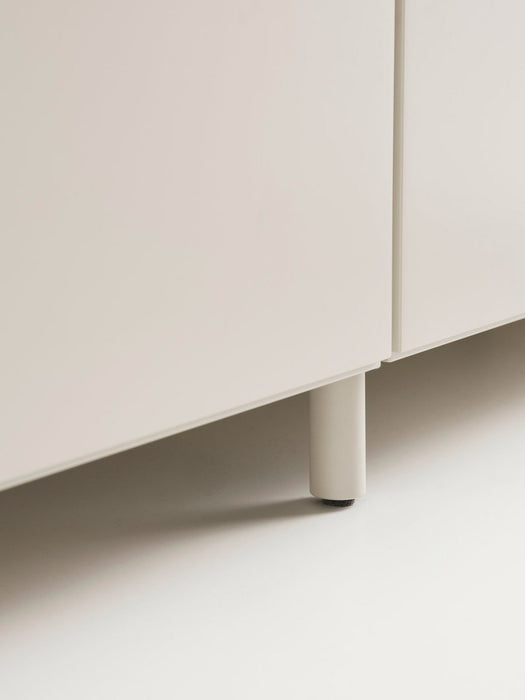

Relief low chest of drawers with legs
The Relief low four-drawer dresser invites creativity thanks to its configuration possibilities. It is available in five finish colors. The interior dimensions of each drawer are 54 x 36.3 x 17 cm.
The new Relief system is composed of chests of drawers in various sizes and five different finish colors. These pieces can be connected to each other to form new arrangements with different dimensions and finishes. Every element of these chests, including the back, has been meticulously designed. This makes them ideal for use as room dividers as well. String Furniture 's Relief chests are functional both as standalone pieces and as connecting pieces to form larger groups of drawers.


Relief low chest of drawers with legs
The Relief low four-drawer dresser invites creativity thanks to its configuration possibilities. It is available in five finish colors. The interior dimensions of each drawer are 54 x 36.3 x 17 cm.
The new Relief system is composed of chests of drawers in various sizes and five different finish colors. These pieces can be connected to each other to form new arrangements with different dimensions and finishes. Every element of these chests, including the back, has been meticulously designed. This makes them ideal for use as room dividers as well. String Furniture 's Relief chests are functional both as standalone pieces and as connecting pieces to form larger groups of drawers.


Relief chest of drawers with legs
The Relief four-drawer dresser invites creativity thanks to its configuration possibilities. It is available in five finish colors. The interior dimensions of each drawer are 74 x 36.3 x 17 cm.
The new Relief system is composed of chests of drawers in various sizes and five different finish colors. These pieces can be connected to each other to form new arrangements with different dimensions and finishes. Every element of these chests, including the back, has been meticulously designed. This makes them ideal for use as room dividers as well. String Furniture 's Relief chests are functional both as standalone pieces and as connecting pieces to form larger groups of drawers.
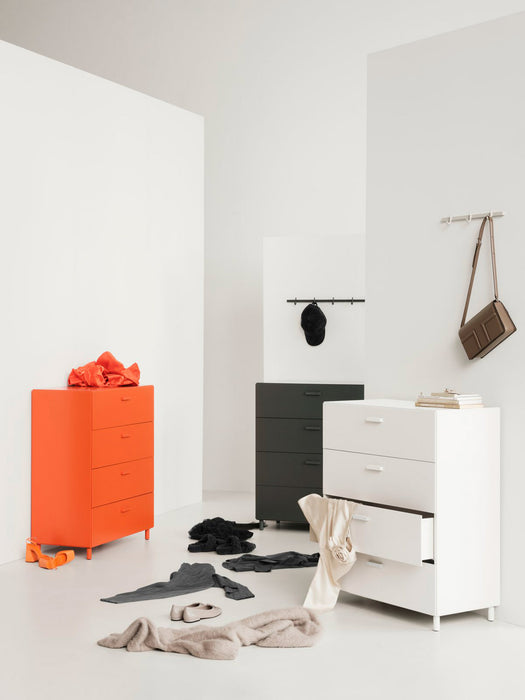

Relief chest of drawers with legs
The Relief four-drawer dresser invites creativity thanks to its configuration possibilities. It is available in five finish colors. The interior dimensions of each drawer are 74 x 36.3 x 17 cm.
The new Relief system is composed of chests of drawers in various sizes and five different finish colors. These pieces can be connected to each other to form new arrangements with different dimensions and finishes. Every element of these chests, including the back, has been meticulously designed. This makes them ideal for use as room dividers as well. String Furniture 's Relief chests are functional both as standalone pieces and as connecting pieces to form larger groups of drawers.
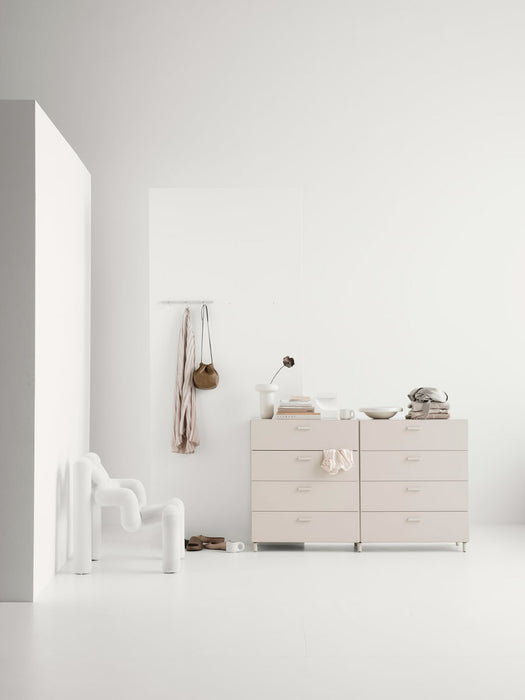

Relief chest of drawers with legs
The Relief four-drawer dresser invites creativity thanks to its configuration possibilities. It is available in five finish colors. The interior dimensions of each drawer are 74 x 36.3 x 17 cm.
The new Relief system is composed of chests of drawers in various sizes and five different finish colors. These pieces can be connected to each other to form new arrangements with different dimensions and finishes. Every element of these chests, including the back, has been meticulously designed. This makes them ideal for use as room dividers as well. String Furniture 's Relief chests are functional both as standalone pieces and as connecting pieces to form larger groups of drawers.
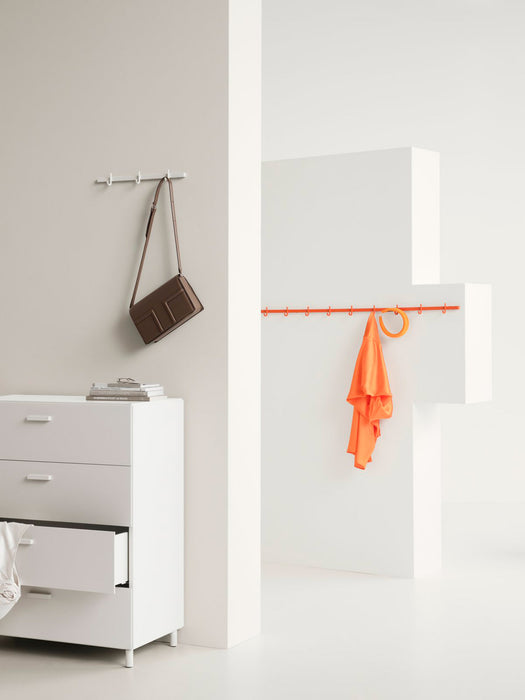

Relief chest of drawers with legs
The Relief four-drawer dresser invites creativity thanks to its configuration possibilities. It is available in five finish colors. The interior dimensions of each drawer are 74 x 36.3 x 17 cm.
The new Relief system is composed of chests of drawers in various sizes and five different finish colors. These pieces can be connected to each other to form new arrangements with different dimensions and finishes. Every element of these chests, including the back, has been meticulously designed. This makes them ideal for use as room dividers as well. String Furniture 's Relief chests are functional both as standalone pieces and as connecting pieces to form larger groups of drawers.
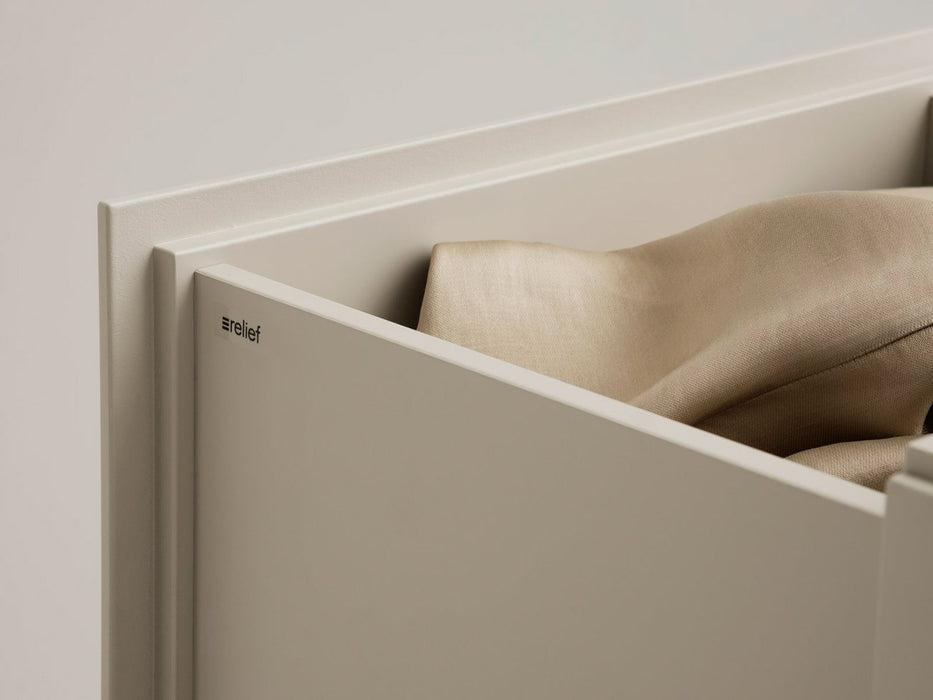

Relief chest of drawers with legs
The Relief four-drawer dresser invites creativity thanks to its configuration possibilities. It is available in five finish colors. The interior dimensions of each drawer are 74 x 36.3 x 17 cm.
The new Relief system is composed of chests of drawers in various sizes and five different finish colors. These pieces can be connected to each other to form new arrangements with different dimensions and finishes. Every element of these chests, including the back, has been meticulously designed. This makes them ideal for use as room dividers as well. String Furniture 's Relief chests are functional both as standalone pieces and as connecting pieces to form larger groups of drawers.
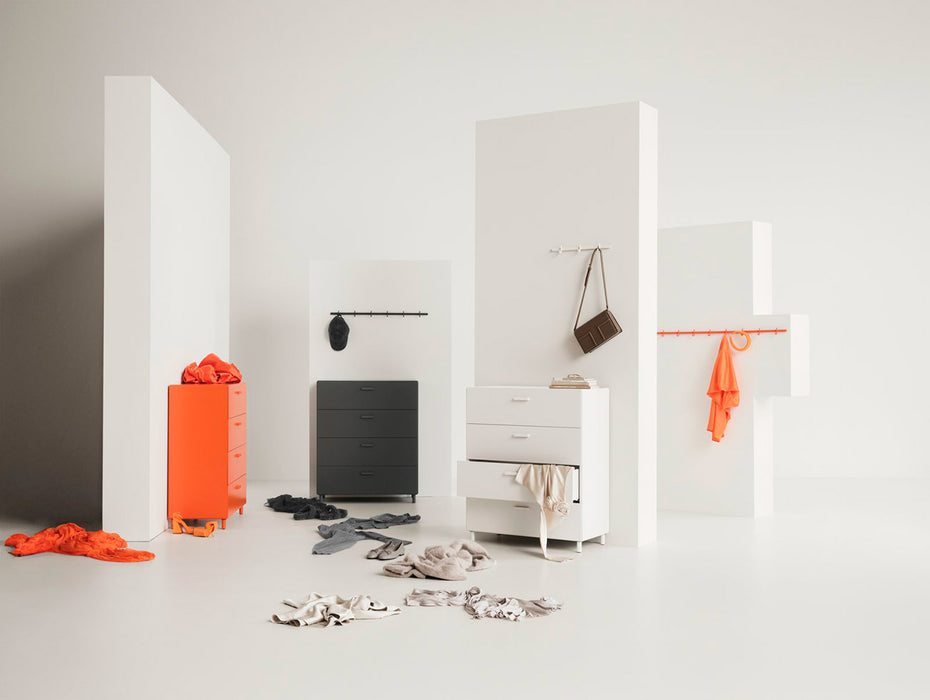

Relief chest of drawers with legs
The Relief four-drawer dresser invites creativity thanks to its configuration possibilities. It is available in five finish colors. The interior dimensions of each drawer are 74 x 36.3 x 17 cm.
The new Relief system is composed of chests of drawers in various sizes and five different finish colors. These pieces can be connected to each other to form new arrangements with different dimensions and finishes. Every element of these chests, including the back, has been meticulously designed. This makes them ideal for use as room dividers as well. String Furniture 's Relief chests are functional both as standalone pieces and as connecting pieces to form larger groups of drawers.


Relief chest of drawers with legs
The Relief four-drawer dresser invites creativity thanks to its configuration possibilities. It is available in five finish colors. The interior dimensions of each drawer are 74 x 36.3 x 17 cm.
The new Relief system is composed of chests of drawers in various sizes and five different finish colors. These pieces can be connected to each other to form new arrangements with different dimensions and finishes. Every element of these chests, including the back, has been meticulously designed. This makes them ideal for use as room dividers as well. String Furniture 's Relief chests are functional both as standalone pieces and as connecting pieces to form larger groups of drawers.


Relief chest of drawers with legs
The Relief four-drawer dresser invites creativity thanks to its configuration possibilities. It is available in five finish colors. The interior dimensions of each drawer are 74 x 36.3 x 17 cm.
The new Relief system is composed of chests of drawers in various sizes and five different finish colors. These pieces can be connected to each other to form new arrangements with different dimensions and finishes. Every element of these chests, including the back, has been meticulously designed. This makes them ideal for use as room dividers as well. String Furniture 's Relief chests are functional both as standalone pieces and as connecting pieces to form larger groups of drawers.


Relief chest of drawers with legs
The Relief four-drawer dresser invites creativity thanks to its configuration possibilities. It is available in five finish colors. The interior dimensions of each drawer are 74 x 36.3 x 17 cm.
The new Relief system is composed of chests of drawers in various sizes and five different finish colors. These pieces can be connected to each other to form new arrangements with different dimensions and finishes. Every element of these chests, including the back, has been meticulously designed. This makes them ideal for use as room dividers as well. String Furniture 's Relief chests are functional both as standalone pieces and as connecting pieces to form larger groups of drawers.


Relief chest of drawers with legs
The Relief four-drawer dresser invites creativity thanks to its configuration possibilities. It is available in five finish colors. The interior dimensions of each drawer are 74 x 36.3 x 17 cm.
The new Relief system is composed of chests of drawers in various sizes and five different finish colors. These pieces can be connected to each other to form new arrangements with different dimensions and finishes. Every element of these chests, including the back, has been meticulously designed. This makes them ideal for use as room dividers as well. String Furniture 's Relief chests are functional both as standalone pieces and as connecting pieces to form larger groups of drawers.
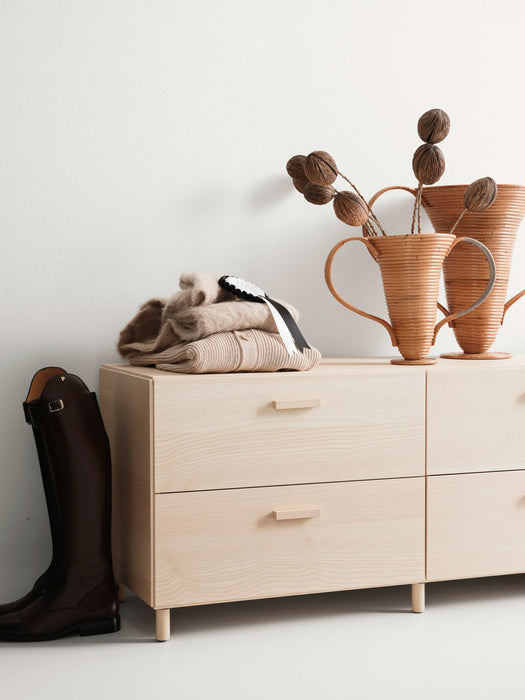

Relief Low Dresser
The Relief low four-drawer dresser invites creativity thanks to its configuration possibilities. It is available in five finish colors. The interior dimensions of each drawer are 54 x 36.3 x 17 cm.
The new Relief system is composed of chests of drawers in various sizes and five different finish colors. These pieces can be connected to each other to form new arrangements with different dimensions and finishes. Every element of these chests, including the back, has been meticulously designed. This makes them ideal for use as room dividers as well. String Furniture 's Relief chests are functional both as standalone pieces and as connecting pieces to form larger groups of drawers.
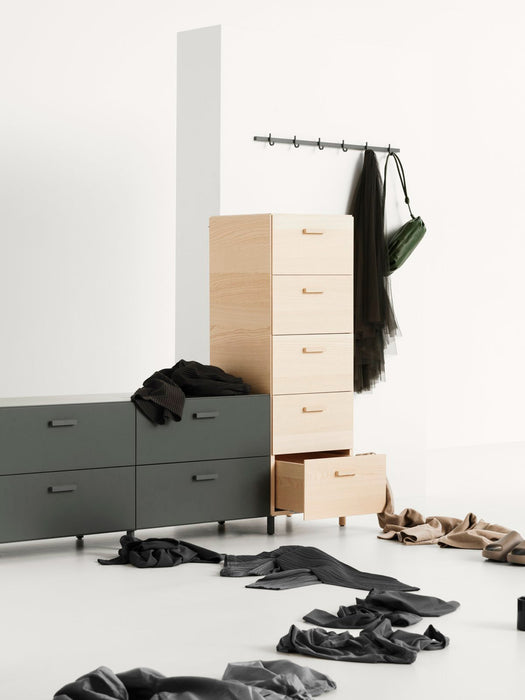

Relief Low Dresser
The Relief low four-drawer dresser invites creativity thanks to its configuration possibilities. It is available in five finish colors. The interior dimensions of each drawer are 54 x 36.3 x 17 cm.
The new Relief system is composed of chests of drawers in various sizes and five different finish colors. These pieces can be connected to each other to form new arrangements with different dimensions and finishes. Every element of these chests, including the back, has been meticulously designed. This makes them ideal for use as room dividers as well. String Furniture 's Relief chests are functional both as standalone pieces and as connecting pieces to form larger groups of drawers.
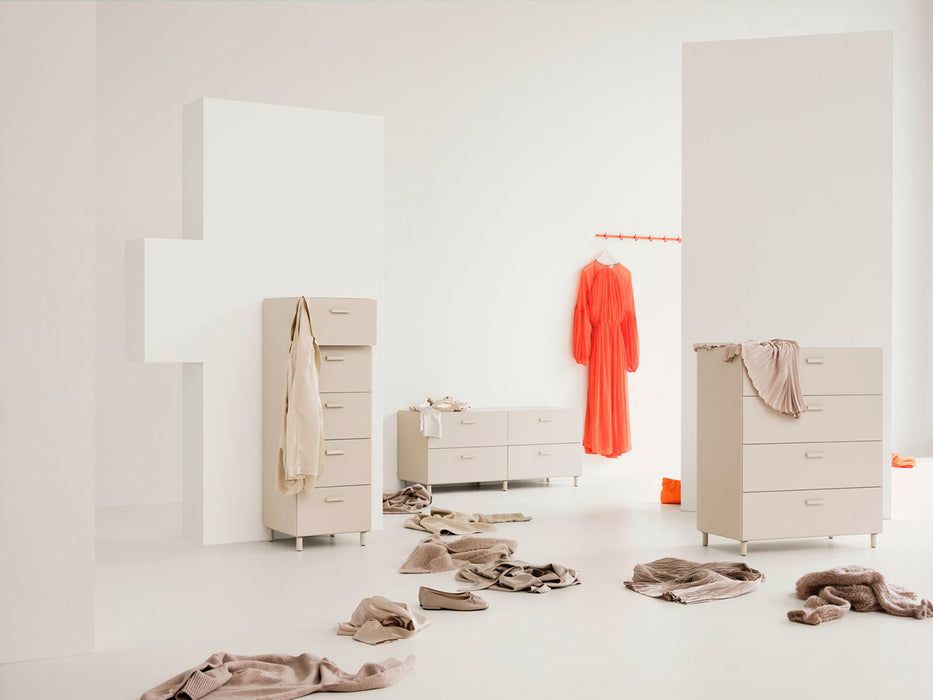

Relief Low Dresser
The Relief low four-drawer dresser invites creativity thanks to its configuration possibilities. It is available in five finish colors. The interior dimensions of each drawer are 54 x 36.3 x 17 cm.
The new Relief system is composed of chests of drawers in various sizes and five different finish colors. These pieces can be connected to each other to form new arrangements with different dimensions and finishes. Every element of these chests, including the back, has been meticulously designed. This makes them ideal for use as room dividers as well. String Furniture 's Relief chests are functional both as standalone pieces and as connecting pieces to form larger groups of drawers.
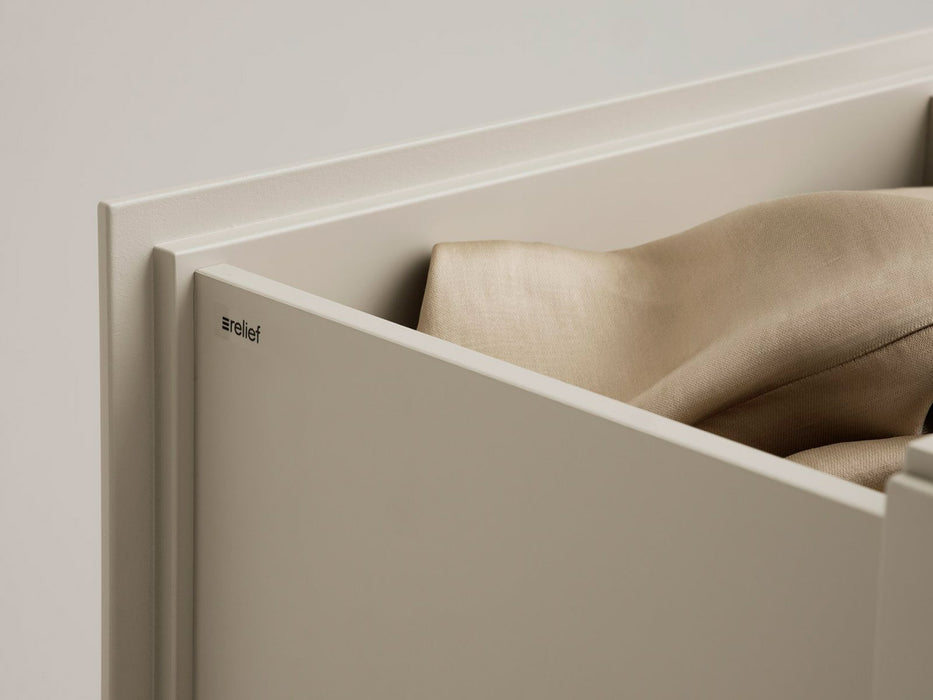

Relief Low Dresser
The Relief low four-drawer dresser invites creativity thanks to its configuration possibilities. It is available in five finish colors. The interior dimensions of each drawer are 54 x 36.3 x 17 cm.
The new Relief system is composed of chests of drawers in various sizes and five different finish colors. These pieces can be connected to each other to form new arrangements with different dimensions and finishes. Every element of these chests, including the back, has been meticulously designed. This makes them ideal for use as room dividers as well. String Furniture 's Relief chests are functional both as standalone pieces and as connecting pieces to form larger groups of drawers.
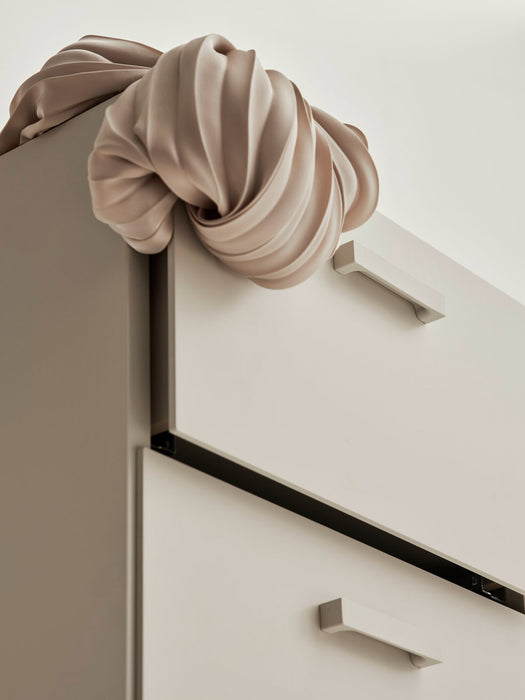

Relief Low Dresser
The Relief low four-drawer dresser invites creativity thanks to its configuration possibilities. It is available in five finish colors. The interior dimensions of each drawer are 54 x 36.3 x 17 cm.
The new Relief system is composed of chests of drawers in various sizes and five different finish colors. These pieces can be connected to each other to form new arrangements with different dimensions and finishes. Every element of these chests, including the back, has been meticulously designed. This makes them ideal for use as room dividers as well. String Furniture 's Relief chests are functional both as standalone pieces and as connecting pieces to form larger groups of drawers.
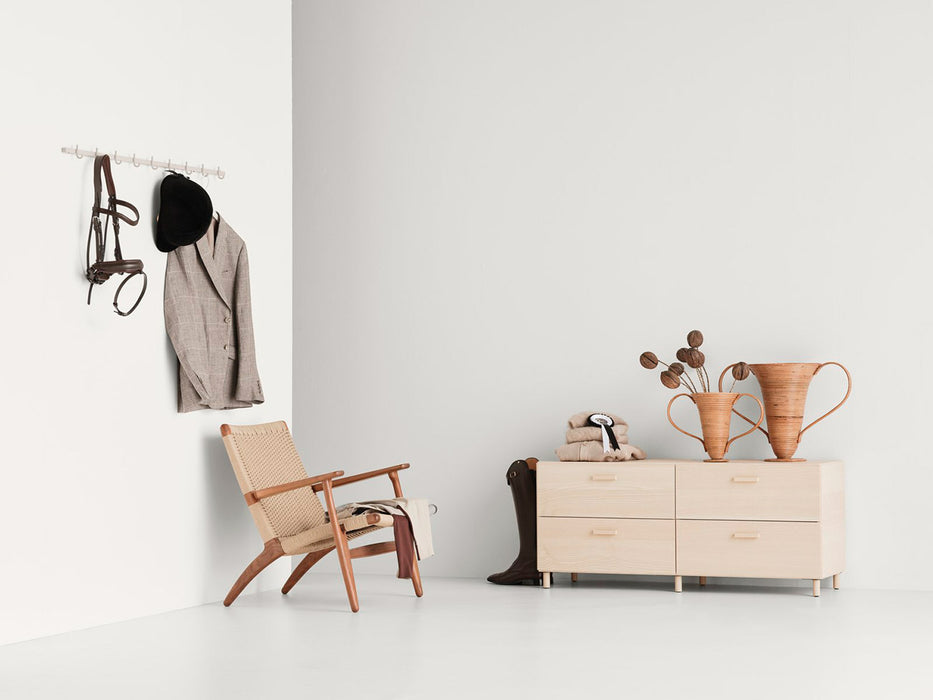

Relief Low Dresser
The Relief low four-drawer dresser invites creativity thanks to its configuration possibilities. It is available in five finish colors. The interior dimensions of each drawer are 54 x 36.3 x 17 cm.
The new Relief system is composed of chests of drawers in various sizes and five different finish colors. These pieces can be connected to each other to form new arrangements with different dimensions and finishes. Every element of these chests, including the back, has been meticulously designed. This makes them ideal for use as room dividers as well. String Furniture 's Relief chests are functional both as standalone pieces and as connecting pieces to form larger groups of drawers.
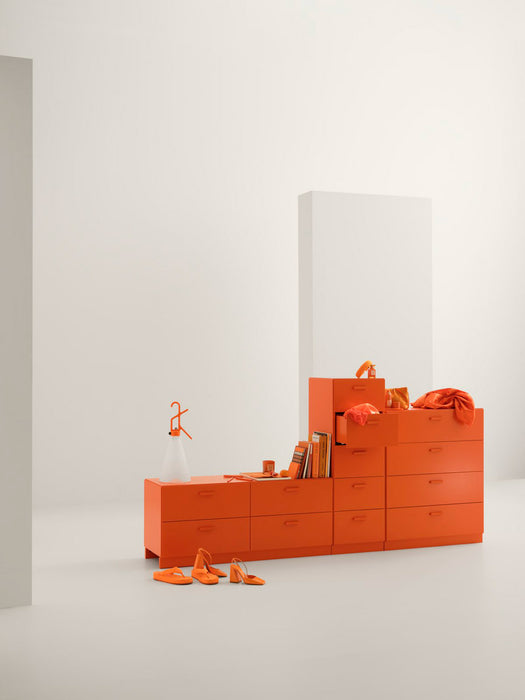

Relief Low Dresser
The Relief low four-drawer dresser invites creativity thanks to its configuration possibilities. It is available in five finish colors. The interior dimensions of each drawer are 54 x 36.3 x 17 cm.
The new Relief system is composed of chests of drawers in various sizes and five different finish colors. These pieces can be connected to each other to form new arrangements with different dimensions and finishes. Every element of these chests, including the back, has been meticulously designed. This makes them ideal for use as room dividers as well. String Furniture 's Relief chests are functional both as standalone pieces and as connecting pieces to form larger groups of drawers.
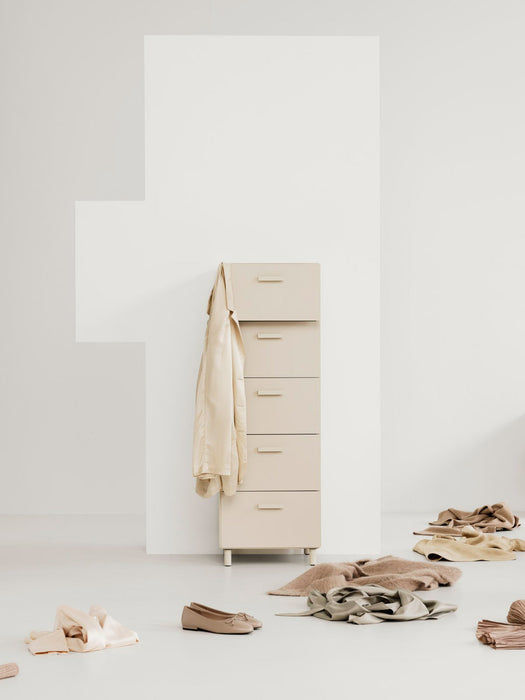

Relief High Dresser
The Relief tall five-drawer chest invites creativity thanks to its configuration possibilities. It is available in five finish colors. The interior dimensions of each drawer are 33 x 36.3 x 17 cm.
The new Relief system is composed of chests of drawers in various sizes and five different finish colors. These pieces can be connected to each other to form new arrangements with different dimensions and finishes. Every element of these chests, including the back, has been meticulously designed. This makes them ideal for use as room dividers as well. String Furniture 's Relief chests are functional both as standalone pieces and as connecting pieces to form larger groups of drawers.
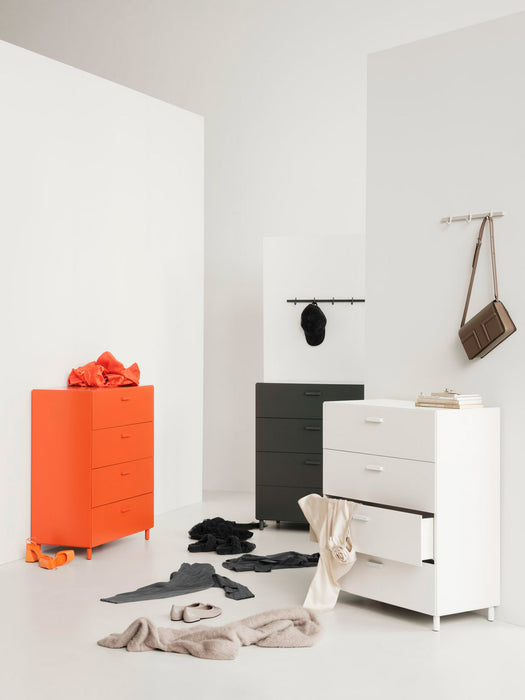

Relief High Dresser
The Relief tall five-drawer chest invites creativity thanks to its configuration possibilities. It is available in five finish colors. The interior dimensions of each drawer are 33 x 36.3 x 17 cm.
The new Relief system is composed of chests of drawers in various sizes and five different finish colors. These pieces can be connected to each other to form new arrangements with different dimensions and finishes. Every element of these chests, including the back, has been meticulously designed. This makes them ideal for use as room dividers as well. String Furniture 's Relief chests are functional both as standalone pieces and as connecting pieces to form larger groups of drawers.
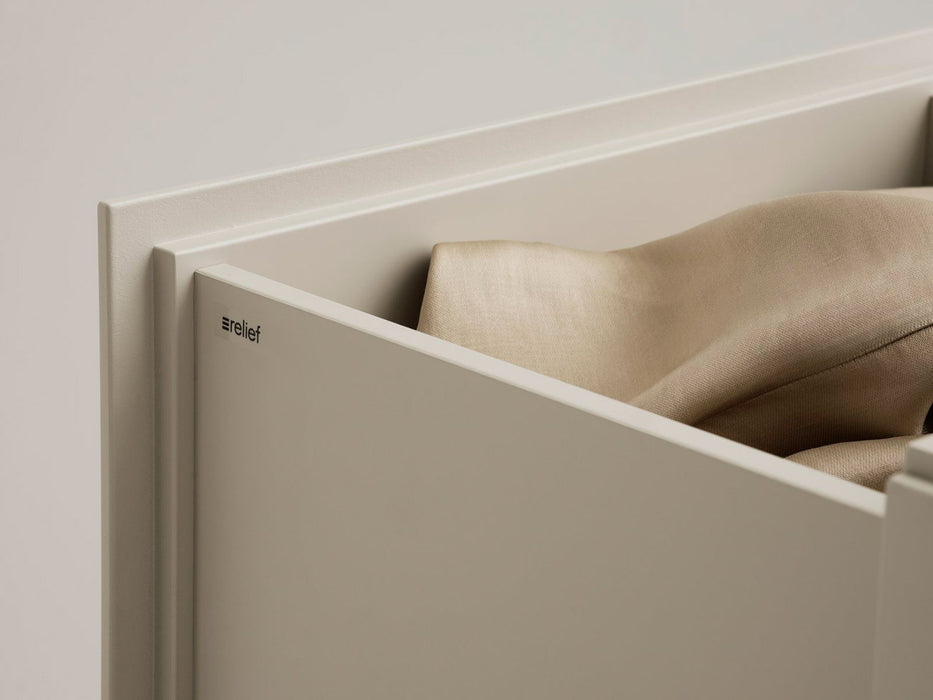

Relief High Dresser
The Relief tall five-drawer chest invites creativity thanks to its configuration possibilities. It is available in five finish colors. The interior dimensions of each drawer are 33 x 36.3 x 17 cm.
The new Relief system is composed of chests of drawers in various sizes and five different finish colors. These pieces can be connected to each other to form new arrangements with different dimensions and finishes. Every element of these chests, including the back, has been meticulously designed. This makes them ideal for use as room dividers as well. String Furniture 's Relief chests are functional both as standalone pieces and as connecting pieces to form larger groups of drawers.
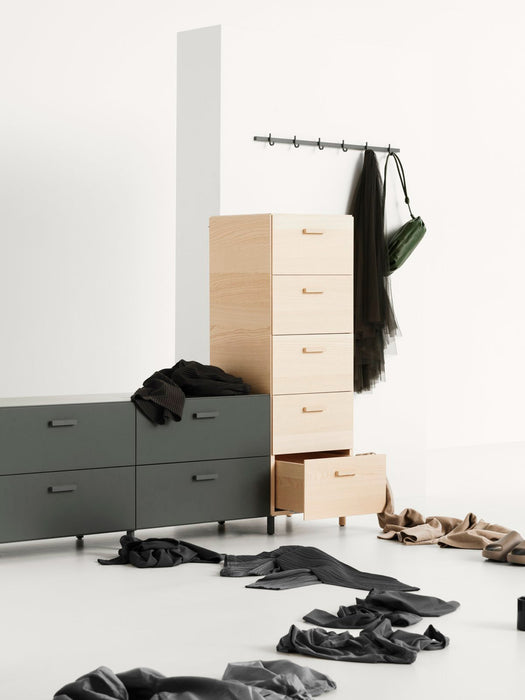

Relief High Dresser
The Relief tall five-drawer chest invites creativity thanks to its configuration possibilities. It is available in five finish colors. The interior dimensions of each drawer are 33 x 36.3 x 17 cm.
The new Relief system is composed of chests of drawers in various sizes and five different finish colors. These pieces can be connected to each other to form new arrangements with different dimensions and finishes. Every element of these chests, including the back, has been meticulously designed. This makes them ideal for use as room dividers as well. String Furniture 's Relief chests are functional both as standalone pieces and as connecting pieces to form larger groups of drawers.
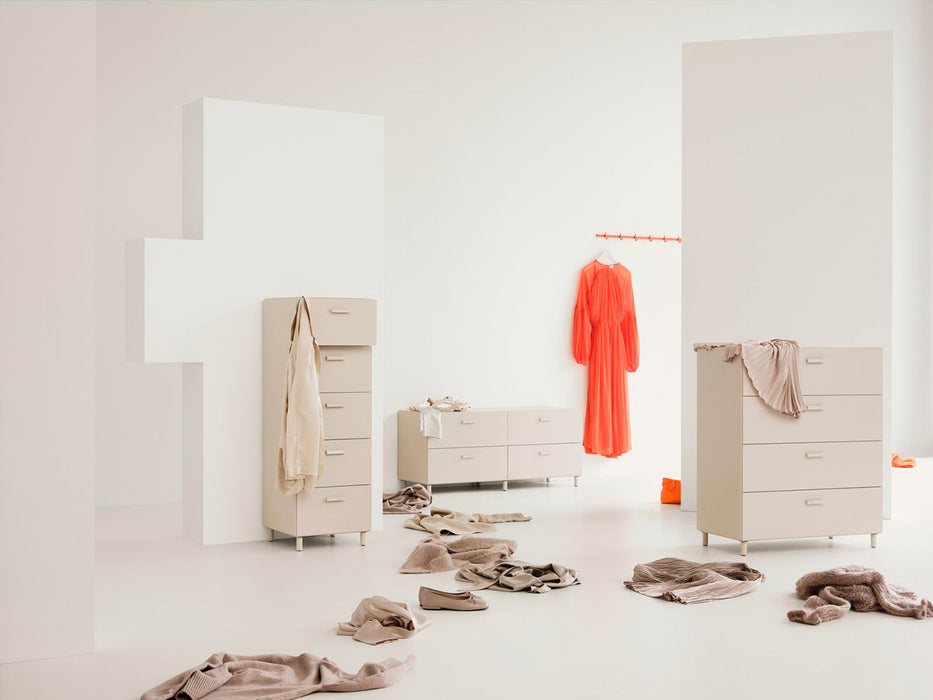

Relief High Dresser
The Relief tall five-drawer chest invites creativity thanks to its configuration possibilities. It is available in five finish colors. The interior dimensions of each drawer are 33 x 36.3 x 17 cm.
The new Relief system is composed of chests of drawers in various sizes and five different finish colors. These pieces can be connected to each other to form new arrangements with different dimensions and finishes. Every element of these chests, including the back, has been meticulously designed. This makes them ideal for use as room dividers as well. String Furniture 's Relief chests are functional both as standalone pieces and as connecting pieces to form larger groups of drawers.
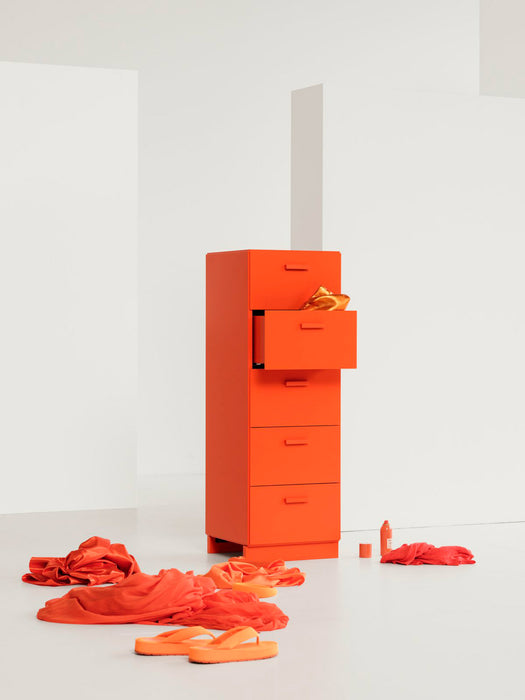

Relief High Dresser
The Relief tall five-drawer chest invites creativity thanks to its configuration possibilities. It is available in five finish colors. The interior dimensions of each drawer are 33 x 36.3 x 17 cm.
The new Relief system is composed of chests of drawers in various sizes and five different finish colors. These pieces can be connected to each other to form new arrangements with different dimensions and finishes. Every element of these chests, including the back, has been meticulously designed. This makes them ideal for use as room dividers as well. String Furniture 's Relief chests are functional both as standalone pieces and as connecting pieces to form larger groups of drawers.
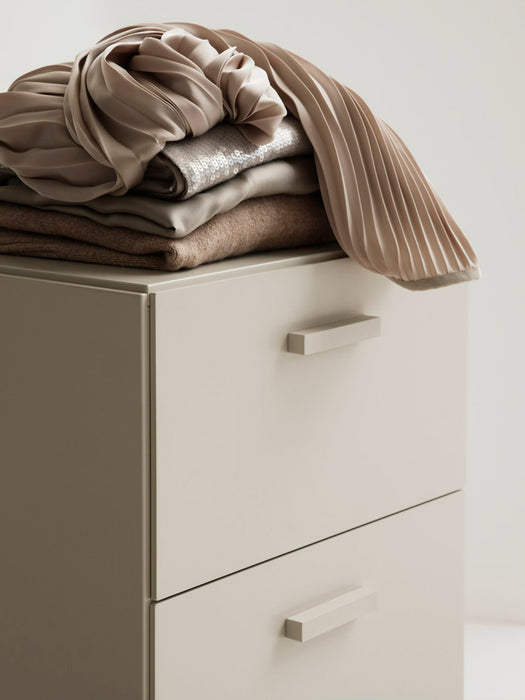

Relief High Dresser
The Relief tall five-drawer chest invites creativity thanks to its configuration possibilities. It is available in five finish colors. The interior dimensions of each drawer are 33 x 36.3 x 17 cm.
The new Relief system is composed of chests of drawers in various sizes and five different finish colors. These pieces can be connected to each other to form new arrangements with different dimensions and finishes. Every element of these chests, including the back, has been meticulously designed. This makes them ideal for use as room dividers as well. String Furniture 's Relief chests are functional both as standalone pieces and as connecting pieces to form larger groups of drawers.
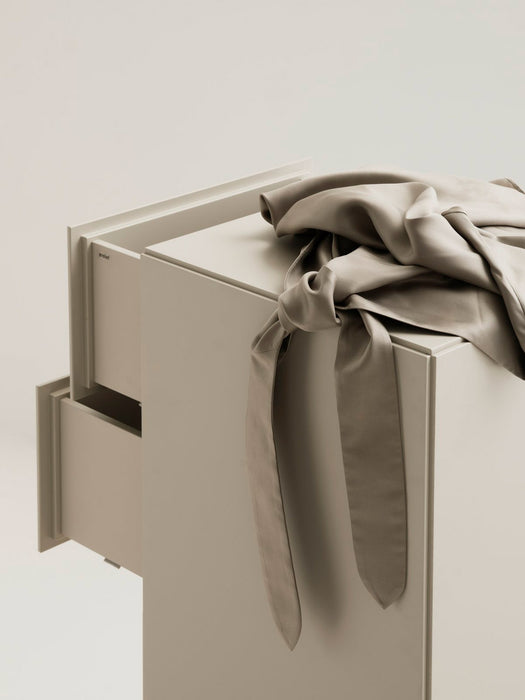

Relief High Dresser
The Relief tall five-drawer chest invites creativity thanks to its configuration possibilities. It is available in five finish colors. The interior dimensions of each drawer are 33 x 36.3 x 17 cm.
The new Relief system is composed of chests of drawers in various sizes and five different finish colors. These pieces can be connected to each other to form new arrangements with different dimensions and finishes. Every element of these chests, including the back, has been meticulously designed. This makes them ideal for use as room dividers as well. String Furniture 's Relief chests are functional both as standalone pieces and as connecting pieces to form larger groups of drawers.
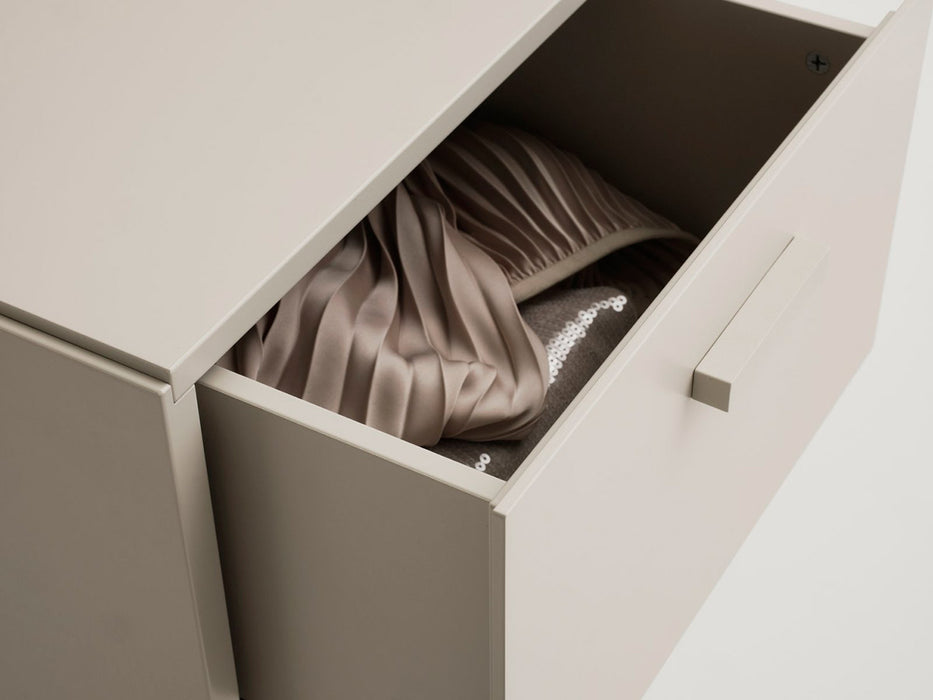

Relief High Dresser
The Relief tall five-drawer chest invites creativity thanks to its configuration possibilities. It is available in five finish colors. The interior dimensions of each drawer are 33 x 36.3 x 17 cm.
The new Relief system is composed of chests of drawers in various sizes and five different finish colors. These pieces can be connected to each other to form new arrangements with different dimensions and finishes. Every element of these chests, including the back, has been meticulously designed. This makes them ideal for use as room dividers as well. String Furniture 's Relief chests are functional both as standalone pieces and as connecting pieces to form larger groups of drawers.
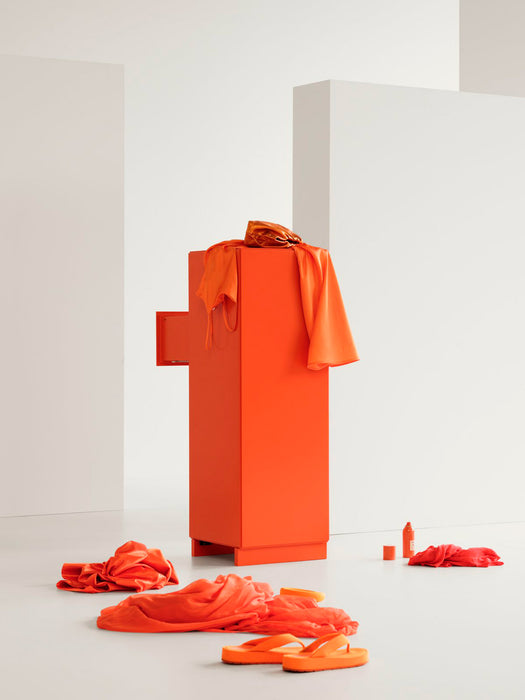

Relief High Dresser
The Relief tall five-drawer chest invites creativity thanks to its configuration possibilities. It is available in five finish colors. The interior dimensions of each drawer are 33 x 36.3 x 17 cm.
The new Relief system is composed of chests of drawers in various sizes and five different finish colors. These pieces can be connected to each other to form new arrangements with different dimensions and finishes. Every element of these chests, including the back, has been meticulously designed. This makes them ideal for use as room dividers as well. String Furniture 's Relief chests are functional both as standalone pieces and as connecting pieces to form larger groups of drawers.
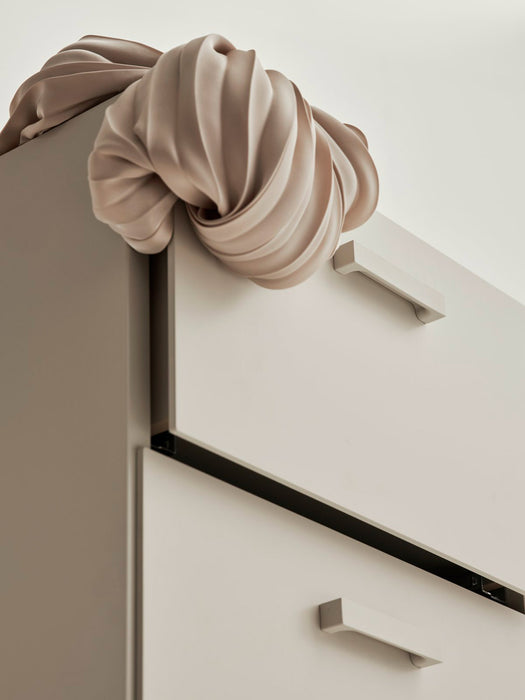

Relief High Dresser
The Relief tall five-drawer chest invites creativity thanks to its configuration possibilities. It is available in five finish colors. The interior dimensions of each drawer are 33 x 36.3 x 17 cm.
The new Relief system is composed of chests of drawers in various sizes and five different finish colors. These pieces can be connected to each other to form new arrangements with different dimensions and finishes. Every element of these chests, including the back, has been meticulously designed. This makes them ideal for use as room dividers as well. String Furniture 's Relief chests are functional both as standalone pieces and as connecting pieces to form larger groups of drawers.
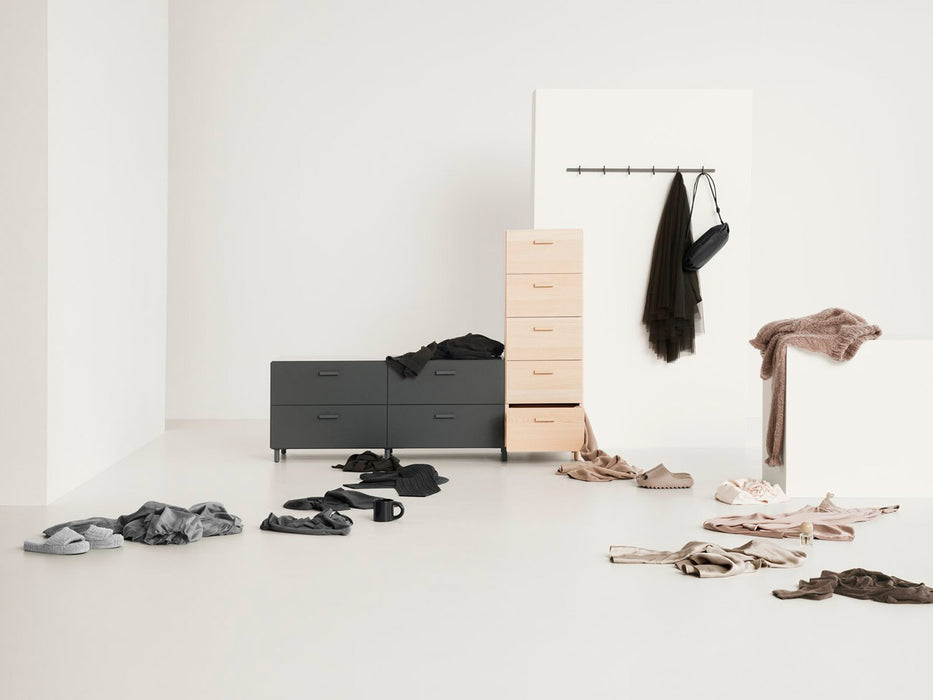

Relief High Dresser
The Relief tall five-drawer chest invites creativity thanks to its configuration possibilities. It is available in five finish colors. The interior dimensions of each drawer are 33 x 36.3 x 17 cm.
The new Relief system is composed of chests of drawers in various sizes and five different finish colors. These pieces can be connected to each other to form new arrangements with different dimensions and finishes. Every element of these chests, including the back, has been meticulously designed. This makes them ideal for use as room dividers as well. String Furniture 's Relief chests are functional both as standalone pieces and as connecting pieces to form larger groups of drawers.
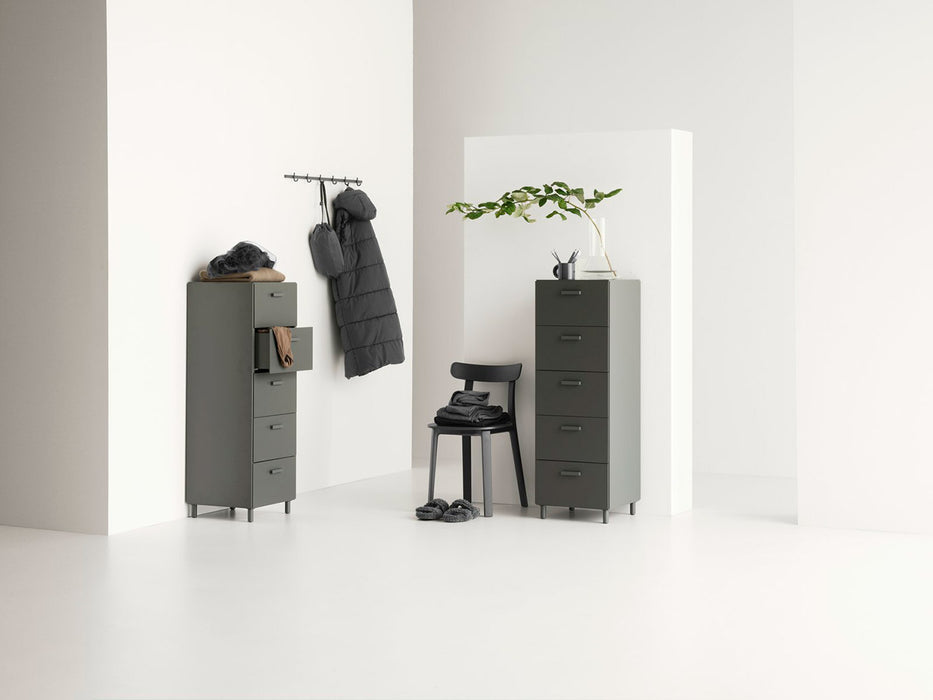

Relief High Dresser
The Relief tall five-drawer chest invites creativity thanks to its configuration possibilities. It is available in five finish colors. The interior dimensions of each drawer are 33 x 36.3 x 17 cm.
The new Relief system is composed of chests of drawers in various sizes and five different finish colors. These pieces can be connected to each other to form new arrangements with different dimensions and finishes. Every element of these chests, including the back, has been meticulously designed. This makes them ideal for use as room dividers as well. String Furniture 's Relief chests are functional both as standalone pieces and as connecting pieces to form larger groups of drawers.
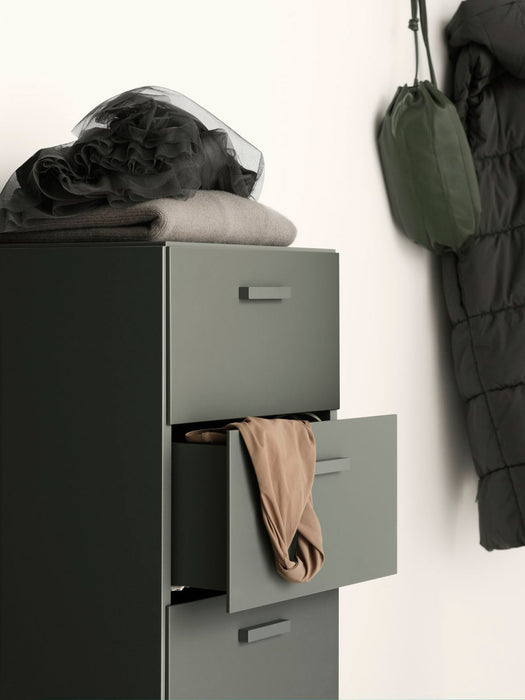

Relief High Dresser
The Relief tall five-drawer chest invites creativity thanks to its configuration possibilities. It is available in five finish colors. The interior dimensions of each drawer are 33 x 36.3 x 17 cm.
The new Relief system is composed of chests of drawers in various sizes and five different finish colors. These pieces can be connected to each other to form new arrangements with different dimensions and finishes. Every element of these chests, including the back, has been meticulously designed. This makes them ideal for use as room dividers as well. String Furniture 's Relief chests are functional both as standalone pieces and as connecting pieces to form larger groups of drawers.
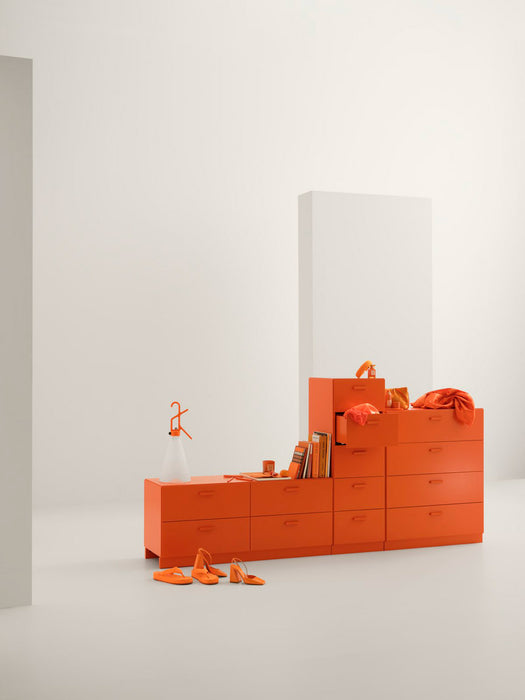

Relief High Dresser
The Relief tall five-drawer chest invites creativity thanks to its configuration possibilities. It is available in five finish colors. The interior dimensions of each drawer are 33 x 36.3 x 17 cm.
The new Relief system is composed of chests of drawers in various sizes and five different finish colors. These pieces can be connected to each other to form new arrangements with different dimensions and finishes. Every element of these chests, including the back, has been meticulously designed. This makes them ideal for use as room dividers as well. String Furniture 's Relief chests are functional both as standalone pieces and as connecting pieces to form larger groups of drawers.
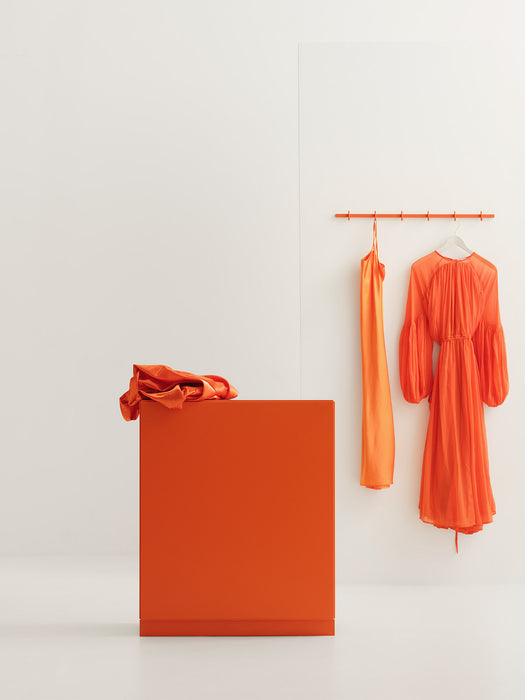

Relief Dresser
The Relief four-drawer dresser invites creativity thanks to its configuration possibilities. It is available in five finish colors. The interior dimensions of each drawer are 74 x 36.3 x 17 cm.
The new Relief system is composed of chests of drawers in various sizes and five different finish colors. These pieces can be connected to each other to form new arrangements with different dimensions and finishes. Every element of these chests, including the back, has been meticulously designed. This makes them ideal for use as room dividers as well. String Furniture 's Relief chests are functional both as standalone pieces and as connecting pieces to form larger groups of drawers.
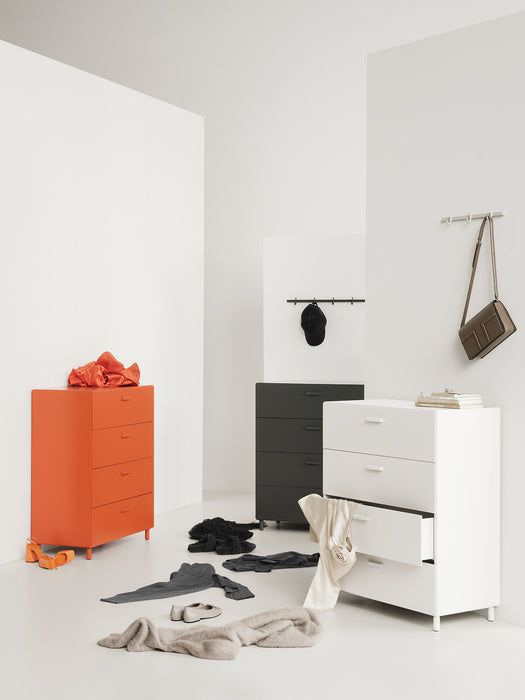

Relief Dresser
The Relief four-drawer dresser invites creativity thanks to its configuration possibilities. It is available in five finish colors. The interior dimensions of each drawer are 74 x 36.3 x 17 cm.
The new Relief system is composed of chests of drawers in various sizes and five different finish colors. These pieces can be connected to each other to form new arrangements with different dimensions and finishes. Every element of these chests, including the back, has been meticulously designed. This makes them ideal for use as room dividers as well. String Furniture 's Relief chests are functional both as standalone pieces and as connecting pieces to form larger groups of drawers.
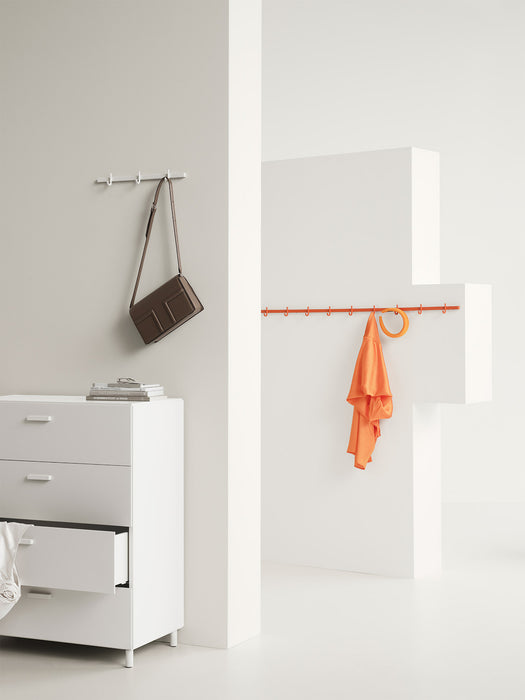

Relief Dresser
The Relief four-drawer dresser invites creativity thanks to its configuration possibilities. It is available in five finish colors. The interior dimensions of each drawer are 74 x 36.3 x 17 cm.
The new Relief system is composed of chests of drawers in various sizes and five different finish colors. These pieces can be connected to each other to form new arrangements with different dimensions and finishes. Every element of these chests, including the back, has been meticulously designed. This makes them ideal for use as room dividers as well. String Furniture 's Relief chests are functional both as standalone pieces and as connecting pieces to form larger groups of drawers.
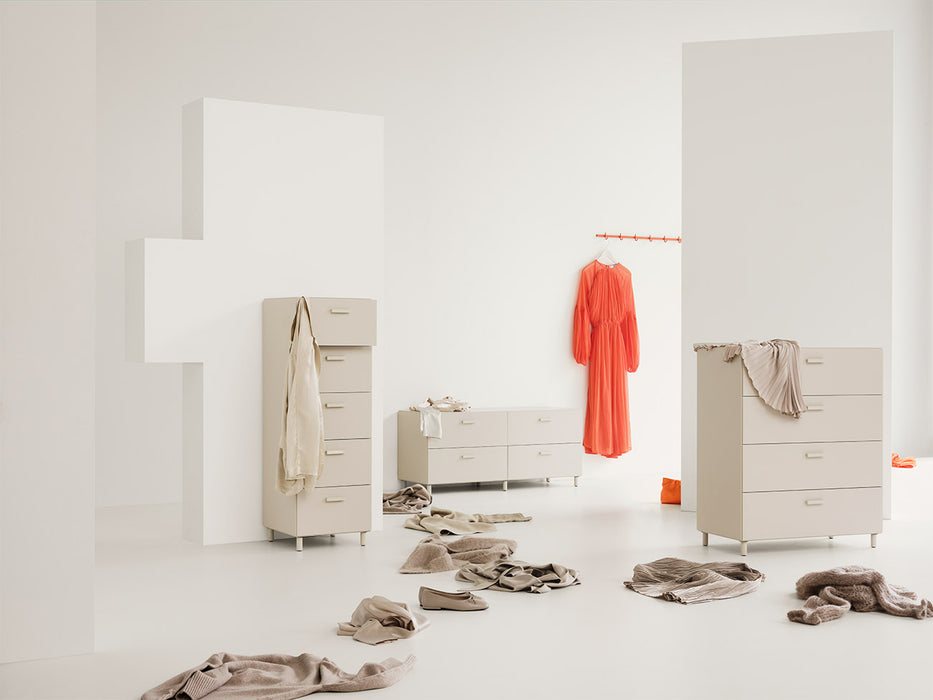

Relief Dresser
The Relief four-drawer dresser invites creativity thanks to its configuration possibilities. It is available in five finish colors. The interior dimensions of each drawer are 74 x 36.3 x 17 cm.
The new Relief system is composed of chests of drawers in various sizes and five different finish colors. These pieces can be connected to each other to form new arrangements with different dimensions and finishes. Every element of these chests, including the back, has been meticulously designed. This makes them ideal for use as room dividers as well. String Furniture 's Relief chests are functional both as standalone pieces and as connecting pieces to form larger groups of drawers.
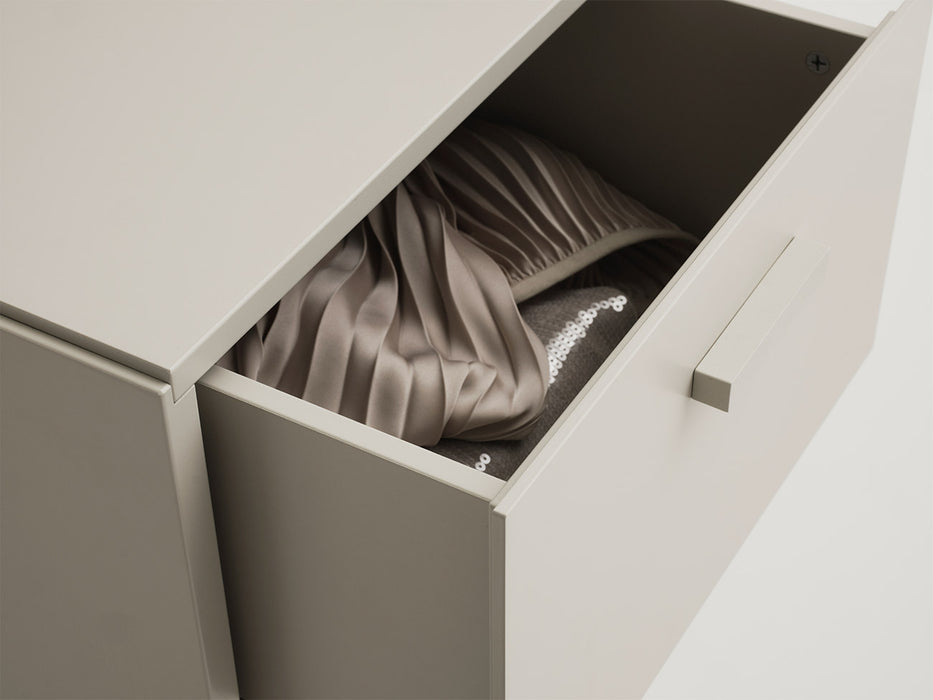

Relief Dresser
The Relief four-drawer dresser invites creativity thanks to its configuration possibilities. It is available in five finish colors. The interior dimensions of each drawer are 74 x 36.3 x 17 cm.
The new Relief system is composed of chests of drawers in various sizes and five different finish colors. These pieces can be connected to each other to form new arrangements with different dimensions and finishes. Every element of these chests, including the back, has been meticulously designed. This makes them ideal for use as room dividers as well. String Furniture 's Relief chests are functional both as standalone pieces and as connecting pieces to form larger groups of drawers.
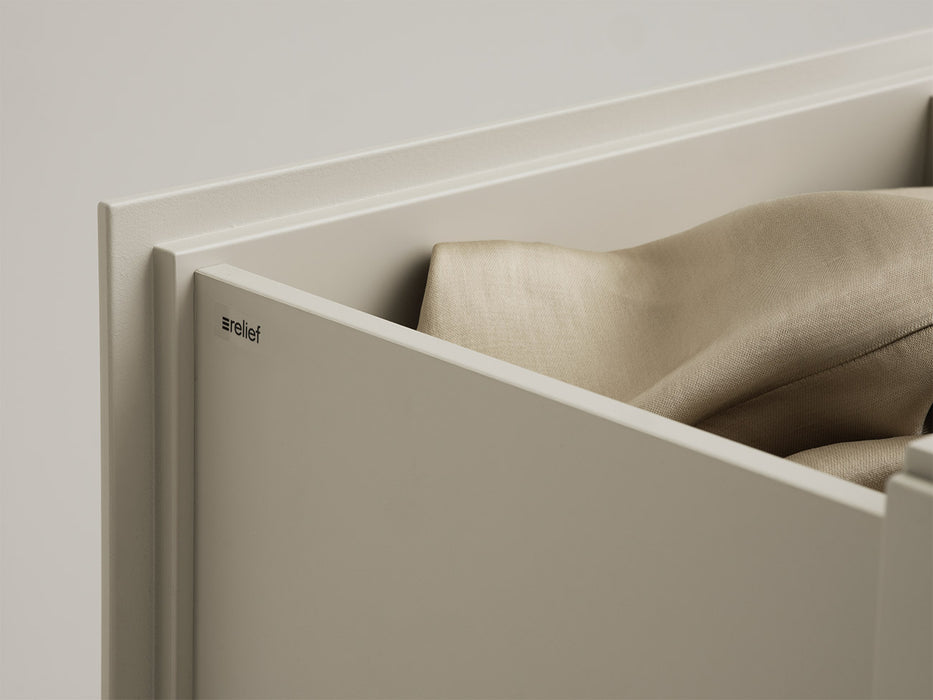

Relief Dresser
The Relief four-drawer dresser invites creativity thanks to its configuration possibilities. It is available in five finish colors. The interior dimensions of each drawer are 74 x 36.3 x 17 cm.
The new Relief system is composed of chests of drawers in various sizes and five different finish colors. These pieces can be connected to each other to form new arrangements with different dimensions and finishes. Every element of these chests, including the back, has been meticulously designed. This makes them ideal for use as room dividers as well. String Furniture 's Relief chests are functional both as standalone pieces and as connecting pieces to form larger groups of drawers.
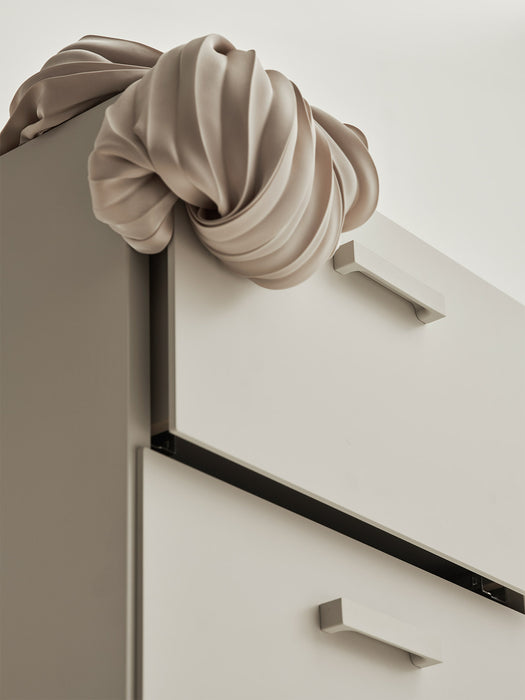

Relief Dresser
The Relief four-drawer dresser invites creativity thanks to its configuration possibilities. It is available in five finish colors. The interior dimensions of each drawer are 74 x 36.3 x 17 cm.
The new Relief system is composed of chests of drawers in various sizes and five different finish colors. These pieces can be connected to each other to form new arrangements with different dimensions and finishes. Every element of these chests, including the back, has been meticulously designed. This makes them ideal for use as room dividers as well. String Furniture 's Relief chests are functional both as standalone pieces and as connecting pieces to form larger groups of drawers.
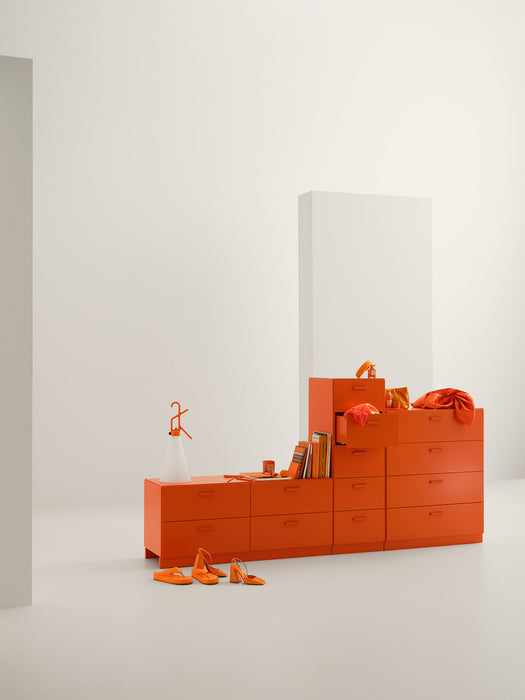

Relief Dresser
The Relief four-drawer dresser invites creativity thanks to its configuration possibilities. It is available in five finish colors. The interior dimensions of each drawer are 74 x 36.3 x 17 cm.
The new Relief system is composed of chests of drawers in various sizes and five different finish colors. These pieces can be connected to each other to form new arrangements with different dimensions and finishes. Every element of these chests, including the back, has been meticulously designed. This makes them ideal for use as room dividers as well. String Furniture 's Relief chests are functional both as standalone pieces and as connecting pieces to form larger groups of drawers.
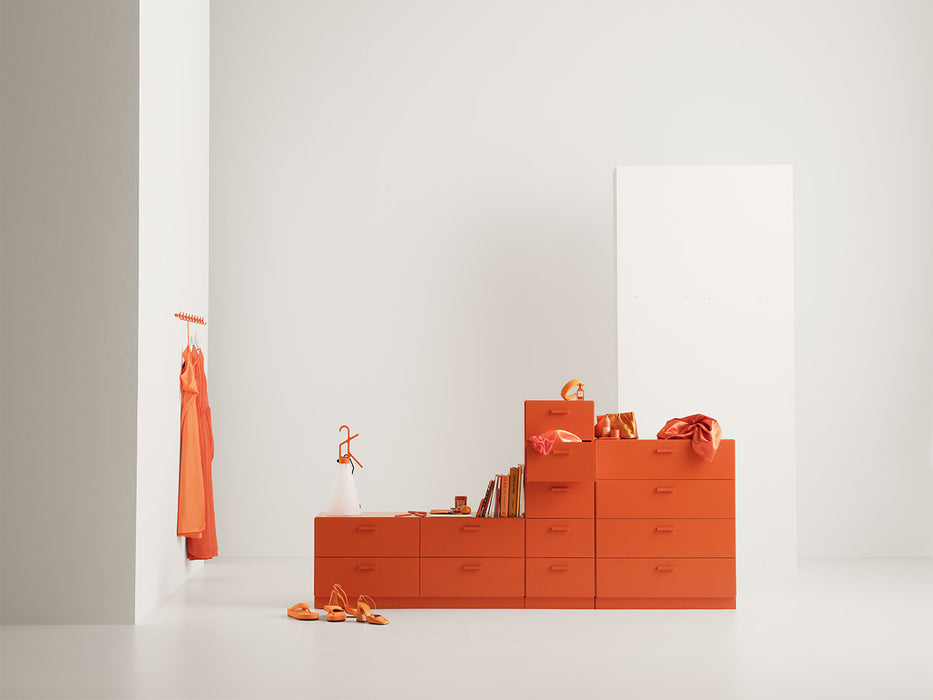

Relief Dresser
The Relief four-drawer dresser invites creativity thanks to its configuration possibilities. It is available in five finish colors. The interior dimensions of each drawer are 74 x 36.3 x 17 cm.
The new Relief system is composed of chests of drawers in various sizes and five different finish colors. These pieces can be connected to each other to form new arrangements with different dimensions and finishes. Every element of these chests, including the back, has been meticulously designed. This makes them ideal for use as room dividers as well. String Furniture 's Relief chests are functional both as standalone pieces and as connecting pieces to form larger groups of drawers.
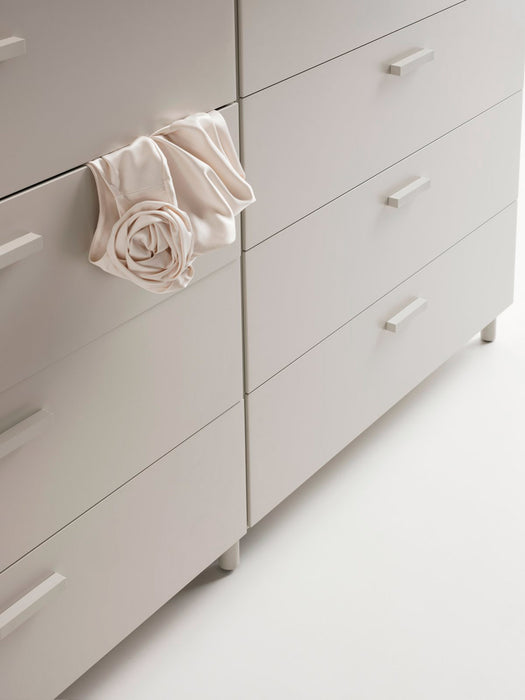

Relief Dresser
The Relief four-drawer dresser invites creativity thanks to its configuration possibilities. It is available in five finish colors. The interior dimensions of each drawer are 74 x 36.3 x 17 cm.
The new Relief system is composed of chests of drawers in various sizes and five different finish colors. These pieces can be connected to each other to form new arrangements with different dimensions and finishes. Every element of these chests, including the back, has been meticulously designed. This makes them ideal for use as room dividers as well. String Furniture 's Relief chests are functional both as standalone pieces and as connecting pieces to form larger groups of drawers.
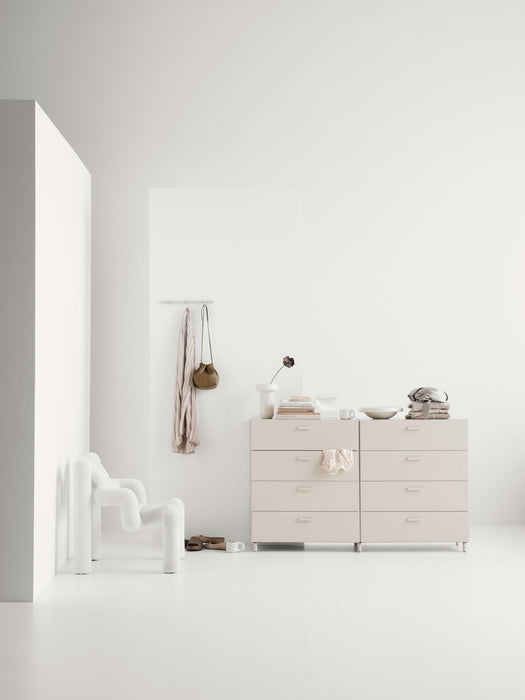

Relief Dresser
The Relief four-drawer dresser invites creativity thanks to its configuration possibilities. It is available in five finish colors. The interior dimensions of each drawer are 74 x 36.3 x 17 cm.
The new Relief system is composed of chests of drawers in various sizes and five different finish colors. These pieces can be connected to each other to form new arrangements with different dimensions and finishes. Every element of these chests, including the back, has been meticulously designed. This makes them ideal for use as room dividers as well. String Furniture 's Relief chests are functional both as standalone pieces and as connecting pieces to form larger groups of drawers.
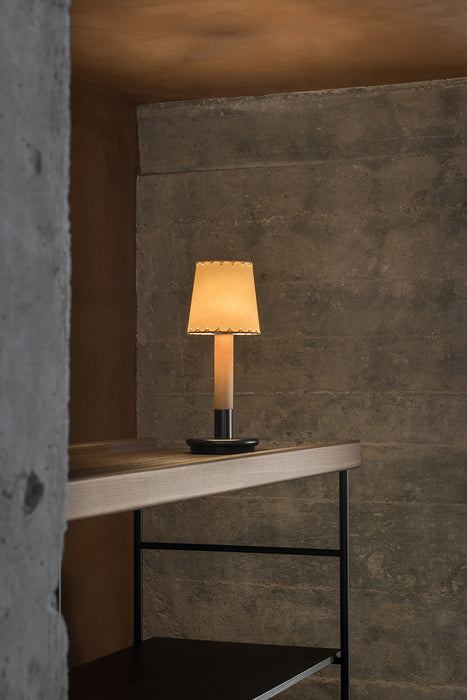

Basic Minimal Portable Lamp
The Básica Mínima Portable Battery Lamp is a lightweight and practical adaptation of the corded version, joining the Básica family . Maintaining its essence, this version champions a modern, handcrafted approach with the freedom of a practical battery, allowing it to be carried anywhere.
Like the classic version, its cylindrical birch wood structure and lampshade are handcrafted. You can choose between a sewn beige cardboard lampshade or a ribbon-wrapped lampshade. The circular base, finished in graphite, is the distinctive element that makes the Basic Minimal Battery portable, allowing it to be turned on and off with a light tap.
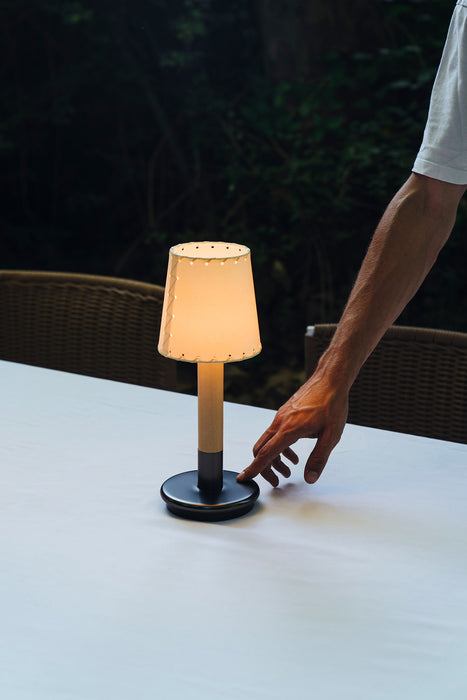

Basic Minimal Portable Lamp
The Básica Mínima Portable Battery Lamp is a lightweight and practical adaptation of the corded version, joining the Básica family . Maintaining its essence, this version champions a modern, handcrafted approach with the freedom of a practical battery, allowing it to be carried anywhere.
Like the classic version, its cylindrical birch wood structure and lampshade are handcrafted. You can choose between a sewn beige cardboard lampshade or a ribbon-wrapped lampshade. The circular base, finished in graphite, is the distinctive element that makes the Basic Minimal Battery portable, allowing it to be turned on and off with a light tap.
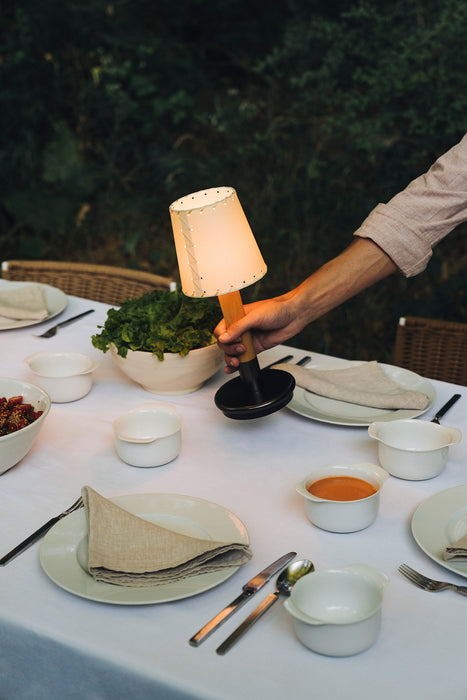

Basic Minimal Portable Lamp
The Básica Mínima Portable Battery Lamp is a lightweight and practical adaptation of the corded version, joining the Básica family . Maintaining its essence, this version champions a modern, handcrafted approach with the freedom of a practical battery, allowing it to be carried anywhere.
Like the classic version, its cylindrical birch wood structure and lampshade are handcrafted. You can choose between a sewn beige cardboard lampshade or a ribbon-wrapped lampshade. The circular base, finished in graphite, is the distinctive element that makes the Basic Minimal Battery portable, allowing it to be turned on and off with a light tap.
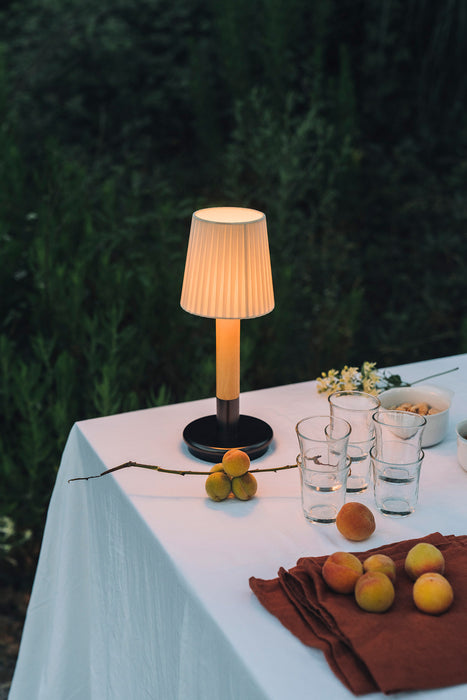

Basic Minimal Portable Lamp
The Básica Mínima Portable Battery Lamp is a lightweight and practical adaptation of the corded version, joining the Básica family . Maintaining its essence, this version champions a modern, handcrafted approach with the freedom of a practical battery, allowing it to be carried anywhere.
Like the classic version, its cylindrical birch wood structure and lampshade are handcrafted. You can choose between a sewn beige cardboard lampshade or a ribbon-wrapped lampshade. The circular base, finished in graphite, is the distinctive element that makes the Basic Minimal Battery portable, allowing it to be turned on and off with a light tap.
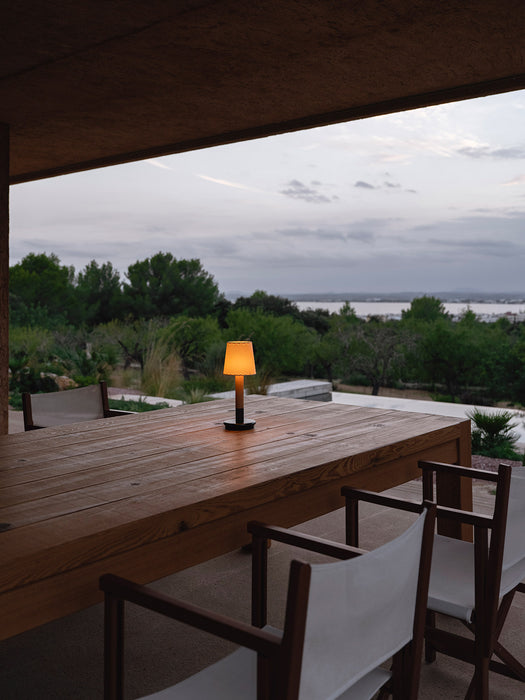

Basic Minimal Portable Lamp
The Básica Mínima Portable Battery Lamp is a lightweight and practical adaptation of the corded version, joining the Básica family . Maintaining its essence, this version champions a modern, handcrafted approach with the freedom of a practical battery, allowing it to be carried anywhere.
Like the classic version, its cylindrical birch wood structure and lampshade are handcrafted. You can choose between a sewn beige cardboard lampshade or a ribbon-wrapped lampshade. The circular base, finished in graphite, is the distinctive element that makes the Basic Minimal Battery portable, allowing it to be turned on and off with a light tap.
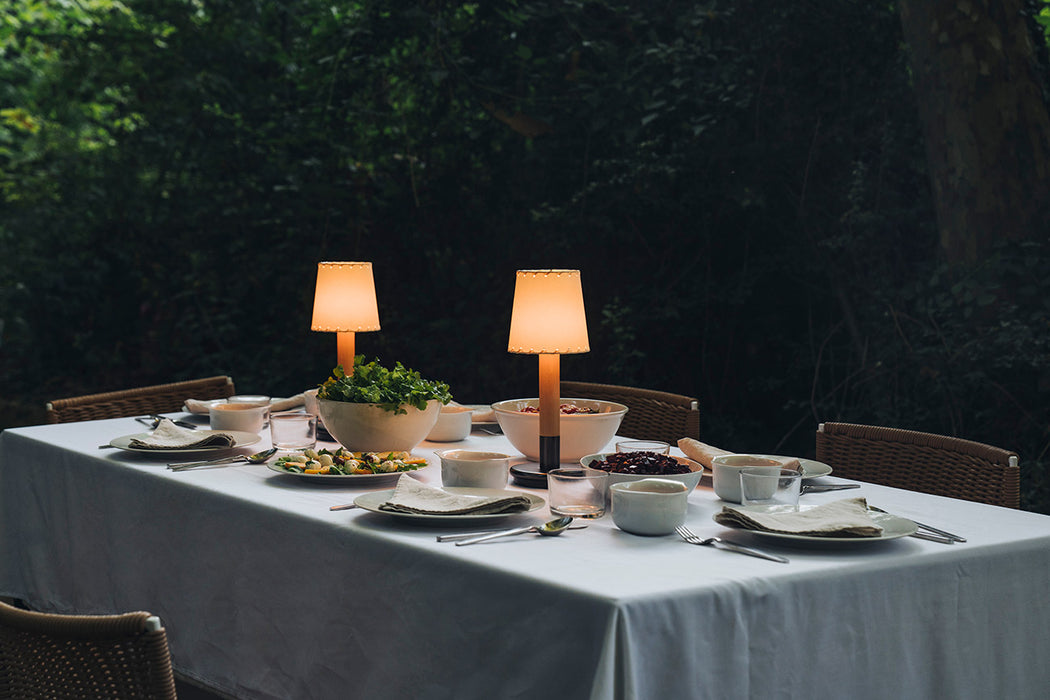

Basic Minimal Portable Lamp
The Básica Mínima Portable Battery Lamp is a lightweight and practical adaptation of the corded version, joining the Básica family . Maintaining its essence, this version champions a modern, handcrafted approach with the freedom of a practical battery, allowing it to be carried anywhere.
Like the classic version, its cylindrical birch wood structure and lampshade are handcrafted. You can choose between a sewn beige cardboard lampshade or a ribbon-wrapped lampshade. The circular base, finished in graphite, is the distinctive element that makes the Basic Minimal Battery portable, allowing it to be turned on and off with a light tap.


Basic Minimal Portable Lamp
The Básica Mínima Portable Battery Lamp is a lightweight and practical adaptation of the corded version, joining the Básica family . Maintaining its essence, this version champions a modern, handcrafted approach with the freedom of a practical battery, allowing it to be carried anywhere.
Like the classic version, its cylindrical birch wood structure and lampshade are handcrafted. You can choose between a sewn beige cardboard lampshade or a ribbon-wrapped lampshade. The circular base, finished in graphite, is the distinctive element that makes the Basic Minimal Battery portable, allowing it to be turned on and off with a light tap.
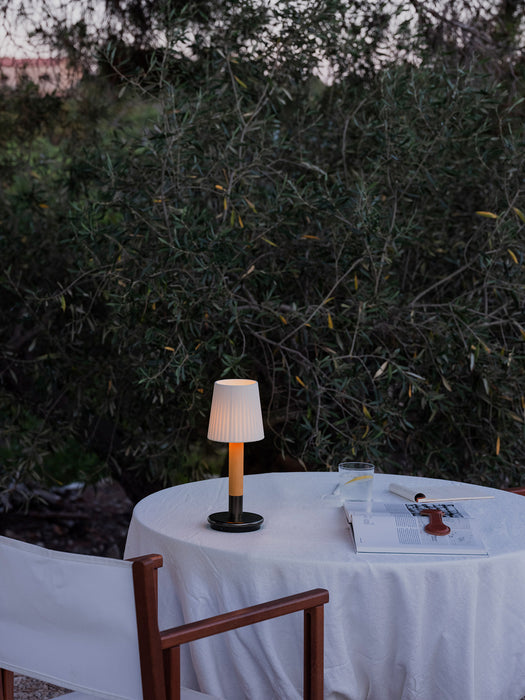

Basic Minimal Portable Lamp
The Básica Mínima Portable Battery Lamp is a lightweight and practical adaptation of the corded version, joining the Básica family . Maintaining its essence, this version champions a modern, handcrafted approach with the freedom of a practical battery, allowing it to be carried anywhere.
Like the classic version, its cylindrical birch wood structure and lampshade are handcrafted. You can choose between a sewn beige cardboard lampshade or a ribbon-wrapped lampshade. The circular base, finished in graphite, is the distinctive element that makes the Basic Minimal Battery portable, allowing it to be turned on and off with a light tap.


Basic Minimal Portable Lamp
The Básica Mínima Portable Battery Lamp is a lightweight and practical adaptation of the corded version, joining the Básica family . Maintaining its essence, this version champions a modern, handcrafted approach with the freedom of a practical battery, allowing it to be carried anywhere.
Like the classic version, its cylindrical birch wood structure and lampshade are handcrafted. You can choose between a sewn beige cardboard lampshade or a ribbon-wrapped lampshade. The circular base, finished in graphite, is the distinctive element that makes the Basic Minimal Battery portable, allowing it to be turned on and off with a light tap.
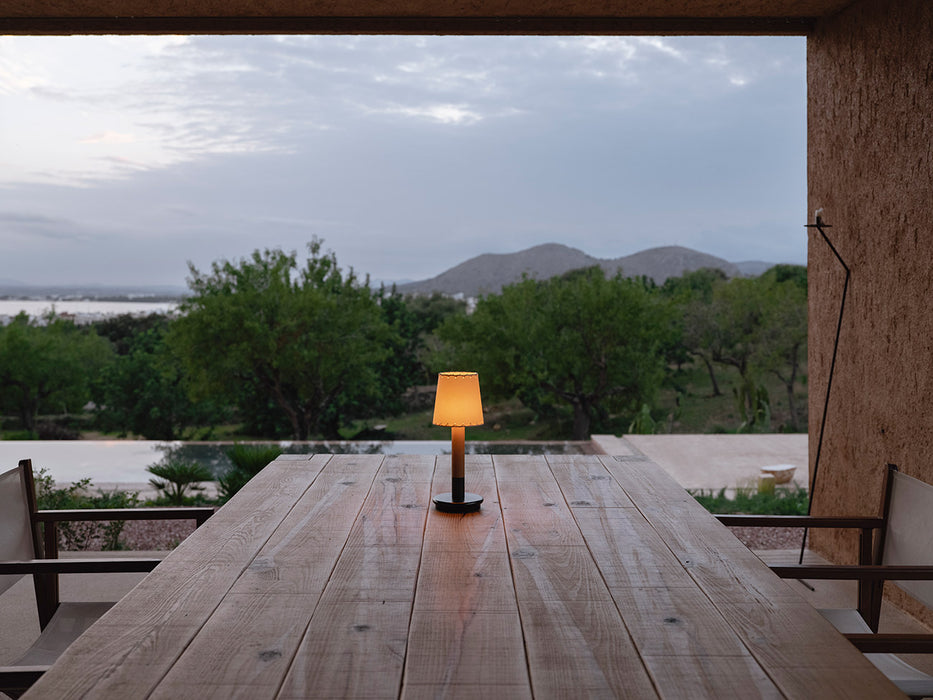

Basic Minimal Portable Lamp
The Básica Mínima Portable Battery Lamp is a lightweight and practical adaptation of the corded version, joining the Básica family . Maintaining its essence, this version champions a modern, handcrafted approach with the freedom of a practical battery, allowing it to be carried anywhere.
Like the classic version, its cylindrical birch wood structure and lampshade are handcrafted. You can choose between a sewn beige cardboard lampshade or a ribbon-wrapped lampshade. The circular base, finished in graphite, is the distinctive element that makes the Basic Minimal Battery portable, allowing it to be turned on and off with a light tap.
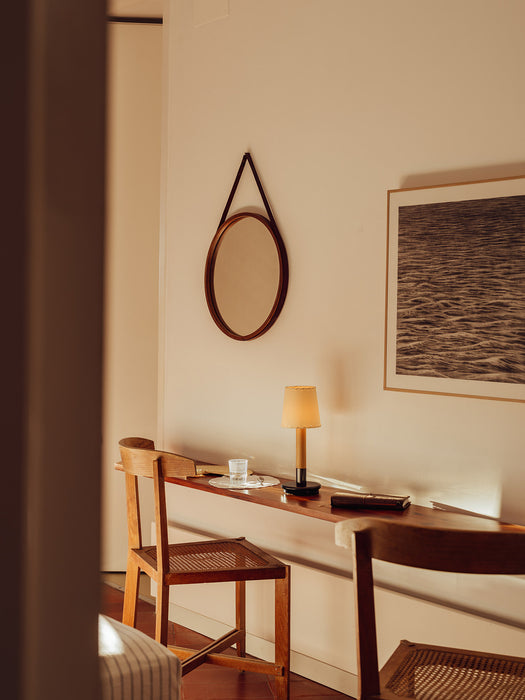

Basic Minimal Portable Lamp
The Básica Mínima Portable Battery Lamp is a lightweight and practical adaptation of the corded version, joining the Básica family . Maintaining its essence, this version champions a modern, handcrafted approach with the freedom of a practical battery, allowing it to be carried anywhere.
Like the classic version, its cylindrical birch wood structure and lampshade are handcrafted. You can choose between a sewn beige cardboard lampshade or a ribbon-wrapped lampshade. The circular base, finished in graphite, is the distinctive element that makes the Basic Minimal Battery portable, allowing it to be turned on and off with a light tap.
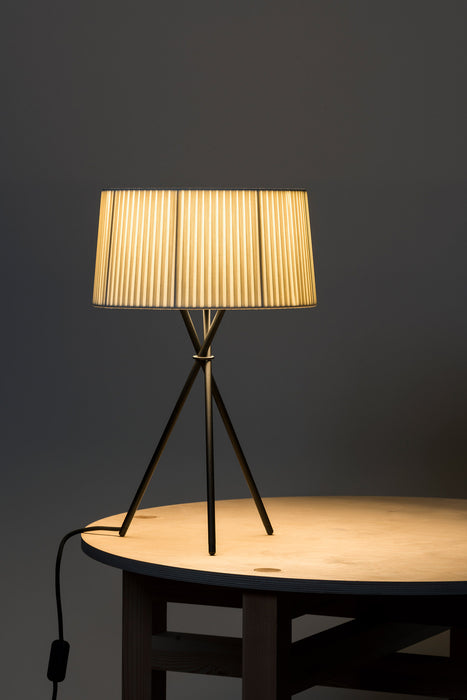

M3 Tripod Table Lamp
Tripod humanizes neutral spaces with its colorful and functional simplicity. It is manually taped, turn after turn, and its base offers the best possible stability. When lit, it provides a characteristic warm light, rich in nuances. And when unlit, it constitutes a small volumetric sculpture that invites immediate use.
The GT5 pendant lamp, from 1994, was the first of a large family that emerged as an alternative to the use of cardboard, methacrylate, or continuous textile shades, recovering forgotten crafts through its handmade cotton ribbons.
As the Tripod family has grown to meet diverse needs, so have its wrapping options.
In 2013, together with the Raw Color studio in Eindhoven (Netherlands), new colors were developed based on three threads: a brick red, a mustard yellow, and a green, which were added to the basic colors that have been in place since 1994: off-white, amber red, and black. In 2022, for its 25th anniversary, we are presenting two new options designed by textile expert Júlia Esqué. Her intervention results in the Breton and Diplomatic stripes, two types of ribbons that provide rhythm and personality. A totem of contemporary design: understated, colorful, and functional.
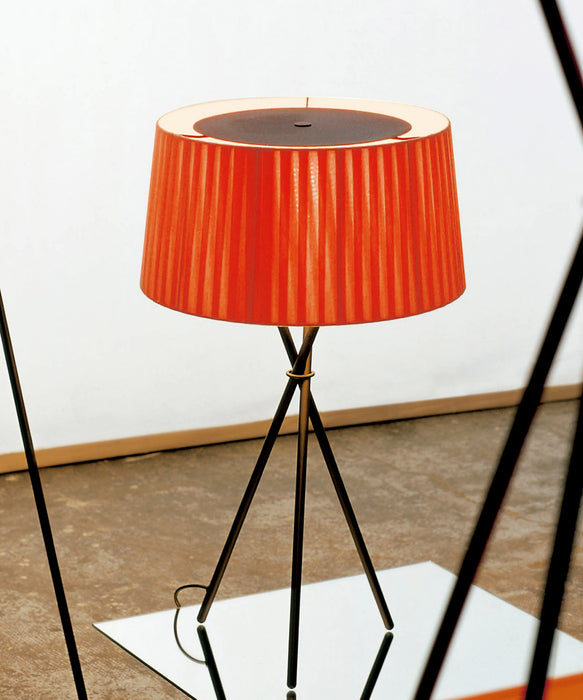

M3 Tripod Table Lamp
Tripod humanizes neutral spaces with its colorful and functional simplicity. It is manually taped, turn after turn, and its base offers the best possible stability. When lit, it provides a characteristic warm light, rich in nuances. And when unlit, it constitutes a small volumetric sculpture that invites immediate use.
The GT5 pendant lamp, from 1994, was the first of a large family that emerged as an alternative to the use of cardboard, methacrylate, or continuous textile shades, recovering forgotten crafts through its handmade cotton ribbons.
As the Tripod family has grown to meet diverse needs, so have its wrapping options.
In 2013, together with the Raw Color studio in Eindhoven (Netherlands), new colors were developed based on three threads: a brick red, a mustard yellow, and a green, which were added to the basic colors that have been in place since 1994: off-white, amber red, and black. In 2022, for its 25th anniversary, we are presenting two new options designed by textile expert Júlia Esqué. Her intervention results in the Breton and Diplomatic stripes, two types of ribbons that provide rhythm and personality. A totem of contemporary design: understated, colorful, and functional.
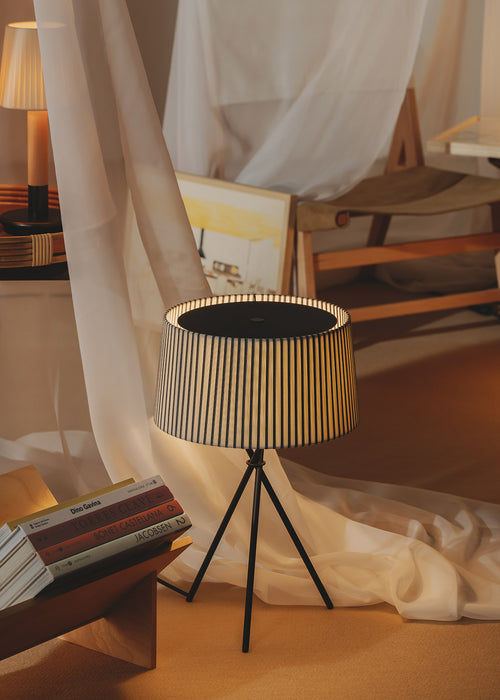

M3 Tripod Table Lamp
Tripod humanizes neutral spaces with its colorful and functional simplicity. It is manually taped, turn after turn, and its base offers the best possible stability. When lit, it provides a characteristic warm light, rich in nuances. And when unlit, it constitutes a small volumetric sculpture that invites immediate use.
The GT5 pendant lamp, from 1994, was the first of a large family that emerged as an alternative to the use of cardboard, methacrylate, or continuous textile shades, recovering forgotten crafts through its handmade cotton ribbons.
As the Tripod family has grown to meet diverse needs, so have its wrapping options.
In 2013, together with the Raw Color studio in Eindhoven (Netherlands), new colors were developed based on three threads: a brick red, a mustard yellow, and a green, which were added to the basic colors that have been in place since 1994: off-white, amber red, and black. In 2022, for its 25th anniversary, we are presenting two new options designed by textile expert Júlia Esqué. Her intervention results in the Breton and Diplomatic stripes, two types of ribbons that provide rhythm and personality. A totem of contemporary design: understated, colorful, and functional.
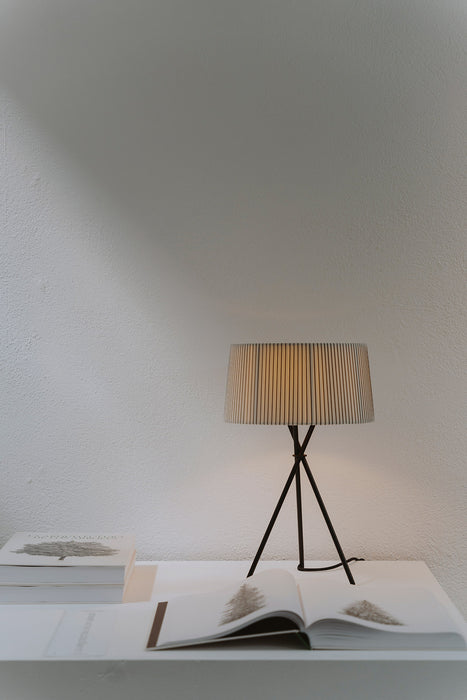

M3 Tripod Table Lamp
Tripod humanizes neutral spaces with its colorful and functional simplicity. It is manually taped, turn after turn, and its base offers the best possible stability. When lit, it provides a characteristic warm light, rich in nuances. And when unlit, it constitutes a small volumetric sculpture that invites immediate use.
The GT5 pendant lamp, from 1994, was the first of a large family that emerged as an alternative to the use of cardboard, methacrylate, or continuous textile shades, recovering forgotten crafts through its handmade cotton ribbons.
As the Tripod family has grown to meet diverse needs, so have its wrapping options.
In 2013, together with the Raw Color studio in Eindhoven (Netherlands), new colors were developed based on three threads: a brick red, a mustard yellow, and a green, which were added to the basic colors that have been in place since 1994: off-white, amber red, and black. In 2022, for its 25th anniversary, we are presenting two new options designed by textile expert Júlia Esqué. Her intervention results in the Breton and Diplomatic stripes, two types of ribbons that provide rhythm and personality. A totem of contemporary design: understated, colorful, and functional.
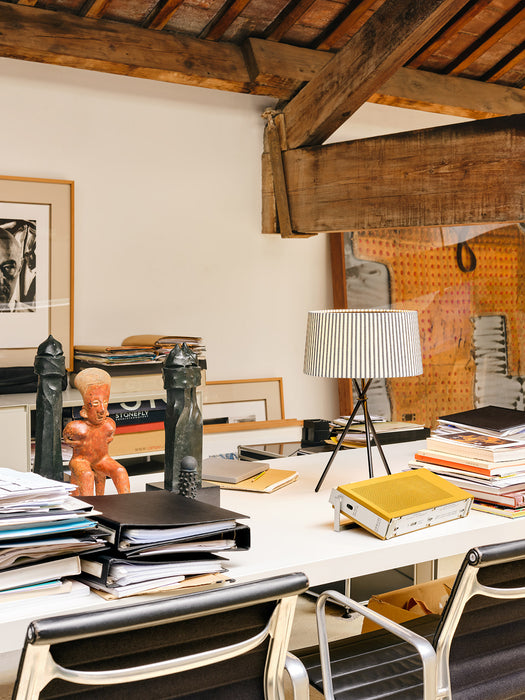

M3 Tripod Table Lamp
Tripod humanizes neutral spaces with its colorful and functional simplicity. It is manually taped, turn after turn, and its base offers the best possible stability. When lit, it provides a characteristic warm light, rich in nuances. And when unlit, it constitutes a small volumetric sculpture that invites immediate use.
The GT5 pendant lamp, from 1994, was the first of a large family that emerged as an alternative to the use of cardboard, methacrylate, or continuous textile shades, recovering forgotten crafts through its handmade cotton ribbons.
As the Tripod family has grown to meet diverse needs, so have its wrapping options.
In 2013, together with the Raw Color studio in Eindhoven (Netherlands), new colors were developed based on three threads: a brick red, a mustard yellow, and a green, which were added to the basic colors that have been in place since 1994: off-white, amber red, and black. In 2022, for its 25th anniversary, we are presenting two new options designed by textile expert Júlia Esqué. Her intervention results in the Breton and Diplomatic stripes, two types of ribbons that provide rhythm and personality. A totem of contemporary design: understated, colorful, and functional.
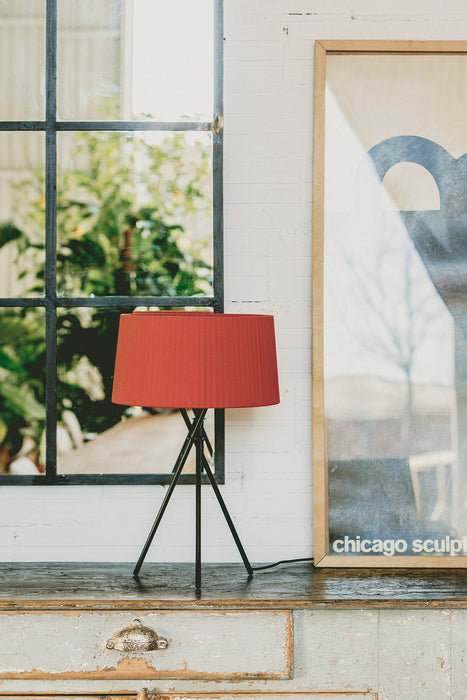

M3 Tripod Table Lamp
Tripod humanizes neutral spaces with its colorful and functional simplicity. It is manually taped, turn after turn, and its base offers the best possible stability. When lit, it provides a characteristic warm light, rich in nuances. And when unlit, it constitutes a small volumetric sculpture that invites immediate use.
The GT5 pendant lamp, from 1994, was the first of a large family that emerged as an alternative to the use of cardboard, methacrylate, or continuous textile shades, recovering forgotten crafts through its handmade cotton ribbons.
As the Tripod family has grown to meet diverse needs, so have its wrapping options.
In 2013, together with the Raw Color studio in Eindhoven (Netherlands), new colors were developed based on three threads: a brick red, a mustard yellow, and a green, which were added to the basic colors that have been in place since 1994: off-white, amber red, and black. In 2022, for its 25th anniversary, we are presenting two new options designed by textile expert Júlia Esqué. Her intervention results in the Breton and Diplomatic stripes, two types of ribbons that provide rhythm and personality. A totem of contemporary design: understated, colorful, and functional.
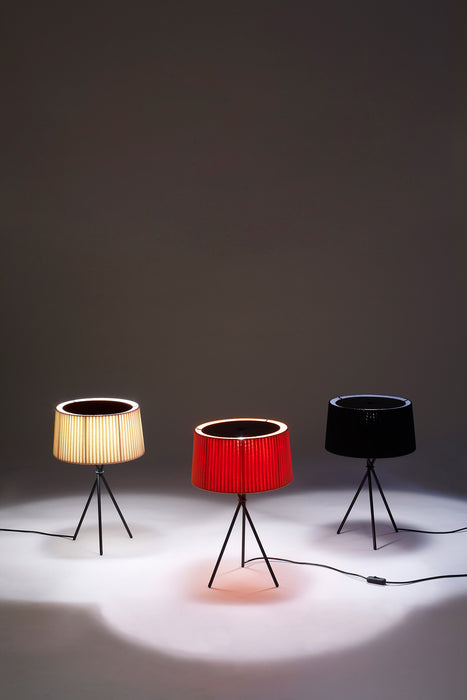

M3 Tripod Table Lamp
Tripod humanizes neutral spaces with its colorful and functional simplicity. It is manually taped, turn after turn, and its base offers the best possible stability. When lit, it provides a characteristic warm light, rich in nuances. And when unlit, it constitutes a small volumetric sculpture that invites immediate use.
The GT5 pendant lamp, from 1994, was the first of a large family that emerged as an alternative to the use of cardboard, methacrylate, or continuous textile shades, recovering forgotten crafts through its handmade cotton ribbons.
As the Tripod family has grown to meet diverse needs, so have its wrapping options.
In 2013, together with the Raw Color studio in Eindhoven (Netherlands), new colors were developed based on three threads: a brick red, a mustard yellow, and a green, which were added to the basic colors that have been in place since 1994: off-white, amber red, and black. In 2022, for its 25th anniversary, we are presenting two new options designed by textile expert Júlia Esqué. Her intervention results in the Breton and Diplomatic stripes, two types of ribbons that provide rhythm and personality. A totem of contemporary design: understated, colorful, and functional.
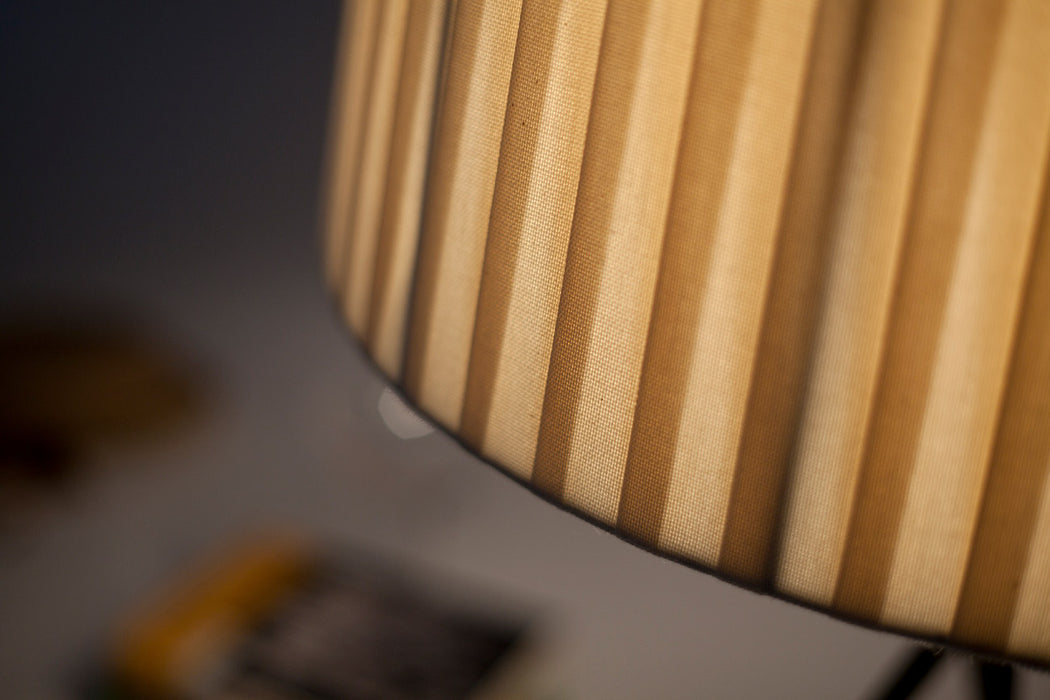

M3 Tripod Table Lamp
Tripod humanizes neutral spaces with its colorful and functional simplicity. It is manually taped, turn after turn, and its base offers the best possible stability. When lit, it provides a characteristic warm light, rich in nuances. And when unlit, it constitutes a small volumetric sculpture that invites immediate use.
The GT5 pendant lamp, from 1994, was the first of a large family that emerged as an alternative to the use of cardboard, methacrylate, or continuous textile shades, recovering forgotten crafts through its handmade cotton ribbons.
As the Tripod family has grown to meet diverse needs, so have its wrapping options.
In 2013, together with the Raw Color studio in Eindhoven (Netherlands), new colors were developed based on three threads: a brick red, a mustard yellow, and a green, which were added to the basic colors that have been in place since 1994: off-white, amber red, and black. In 2022, for its 25th anniversary, we are presenting two new options designed by textile expert Júlia Esqué. Her intervention results in the Breton and Diplomatic stripes, two types of ribbons that provide rhythm and personality. A totem of contemporary design: understated, colorful, and functional.
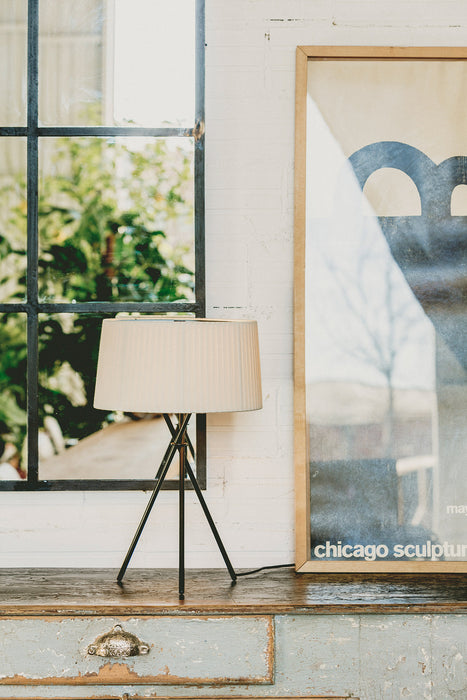

M3 Tripod Table Lamp
Tripod humanizes neutral spaces with its colorful and functional simplicity. It is manually taped, turn after turn, and its base offers the best possible stability. When lit, it provides a characteristic warm light, rich in nuances. And when unlit, it constitutes a small volumetric sculpture that invites immediate use.
The GT5 pendant lamp, from 1994, was the first of a large family that emerged as an alternative to the use of cardboard, methacrylate, or continuous textile shades, recovering forgotten crafts through its handmade cotton ribbons.
As the Tripod family has grown to meet diverse needs, so have its wrapping options.
In 2013, together with the Raw Color studio in Eindhoven (Netherlands), new colors were developed based on three threads: a brick red, a mustard yellow, and a green, which were added to the basic colors that have been in place since 1994: off-white, amber red, and black. In 2022, for its 25th anniversary, we are presenting two new options designed by textile expert Júlia Esqué. Her intervention results in the Breton and Diplomatic stripes, two types of ribbons that provide rhythm and personality. A totem of contemporary design: understated, colorful, and functional.
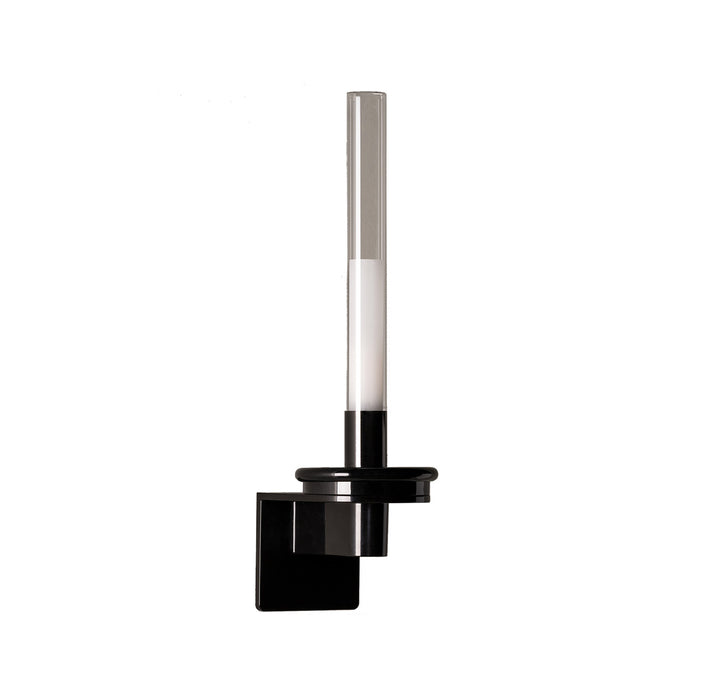

Sylvestrina wall lamp
Maintaining its designers' inspiration from the traditional oil lamp, the Sylvestrina wall light provides ambient light suitable for both large spaces and hallways, as well as more secluded corners. This wall light features a circular metal base with a glossy black finish and a cylindrical glass shade that diffuses a warm light.
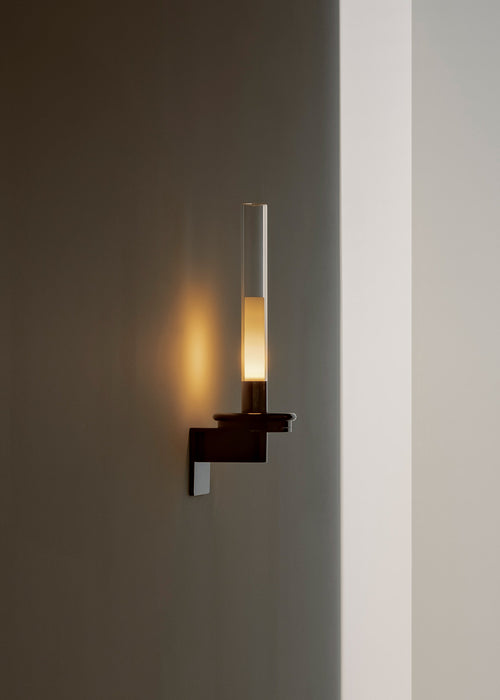

Sylvestrina wall lamp
Maintaining its designers' inspiration from the traditional oil lamp, the Sylvestrina wall light provides ambient light suitable for both large spaces and hallways, as well as more secluded corners. This wall light features a circular metal base with a glossy black finish and a cylindrical glass shade that diffuses a warm light.
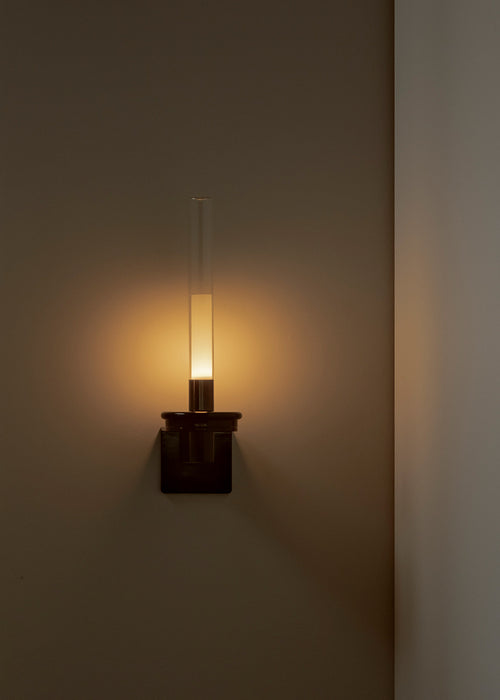

Sylvestrina wall lamp
Maintaining its designers' inspiration from the traditional oil lamp, the Sylvestrina wall light provides ambient light suitable for both large spaces and hallways, as well as more secluded corners. This wall light features a circular metal base with a glossy black finish and a cylindrical glass shade that diffuses a warm light.
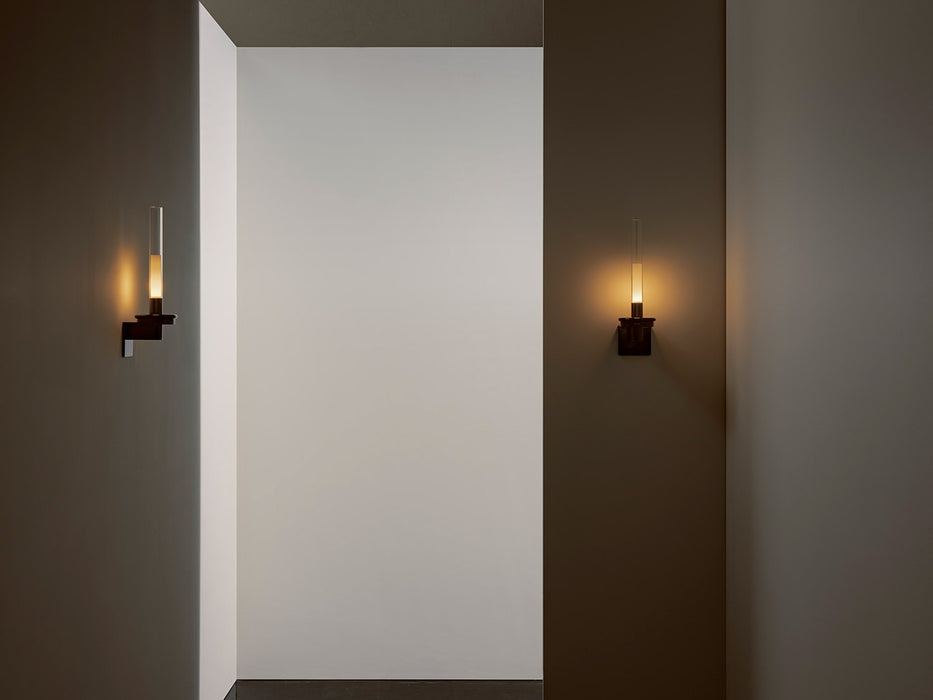

Sylvestrina wall lamp
Maintaining its designers' inspiration from the traditional oil lamp, the Sylvestrina wall light provides ambient light suitable for both large spaces and hallways, as well as more secluded corners. This wall light features a circular metal base with a glossy black finish and a cylindrical glass shade that diffuses a warm light.
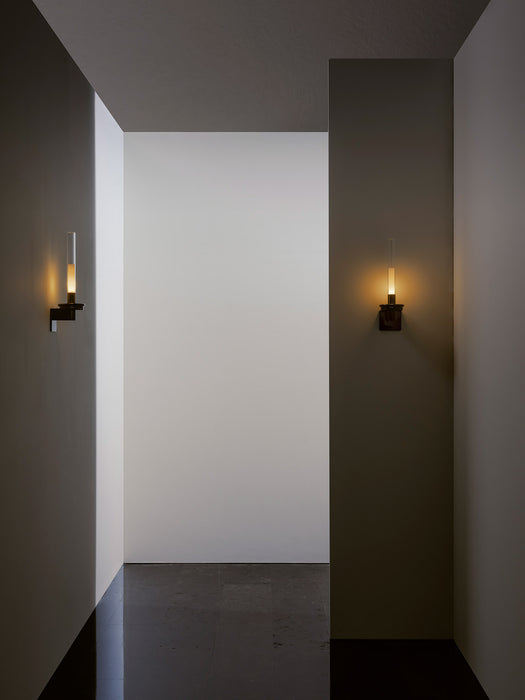

Sylvestrina wall lamp
Maintaining its designers' inspiration from the traditional oil lamp, the Sylvestrina wall light provides ambient light suitable for both large spaces and hallways, as well as more secluded corners. This wall light features a circular metal base with a glossy black finish and a cylindrical glass shade that diffuses a warm light.
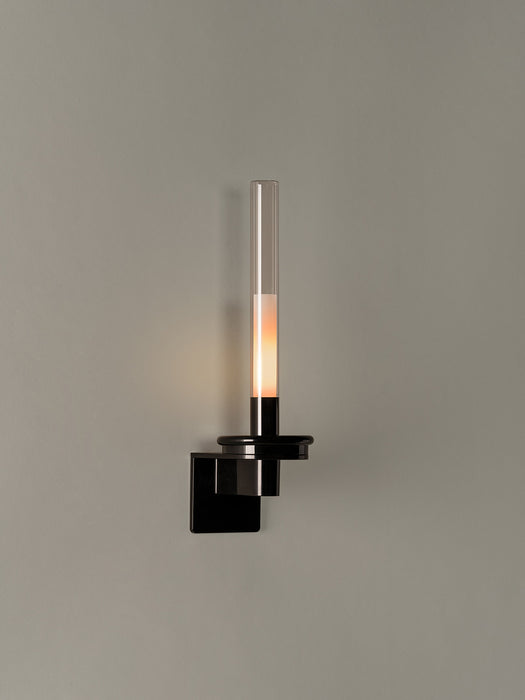

Sylvestrina wall lamp
Maintaining its designers' inspiration from the traditional oil lamp, the Sylvestrina wall light provides ambient light suitable for both large spaces and hallways, as well as more secluded corners. This wall light features a circular metal base with a glossy black finish and a cylindrical glass shade that diffuses a warm light.
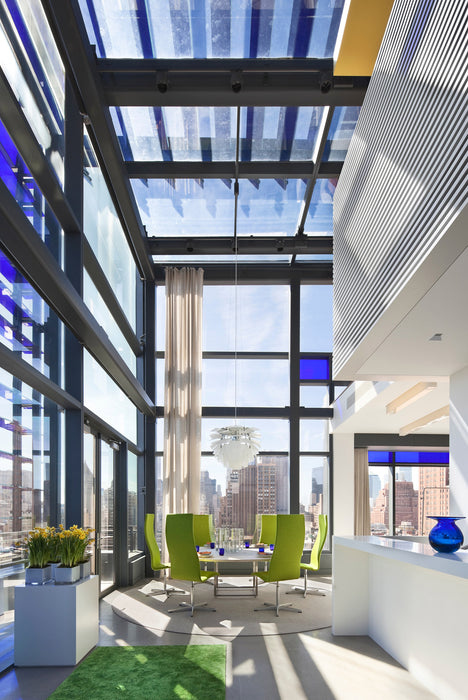

PH Artichoke Glass Ceiling Lamp
The PH Artichoke Glass lamp is a handcrafted piece of sand-blown glass. The soft light it emits diffuses through its leaves to provide a comfortable and pleasant illumination. Whether lit or unlit, the lamp has an "ice-like appearance" that radiates elegance and luminosity to any space.
The PH Artichoke chandelier was designed in 1958 by Poul Henningsen. He originally created it for the Langelinie Pavilionen, a modernist restaurant in Copenhagen, where the PH Artichoke continues to delight diners. It was conceived to be as impressive as a classic chandelier, while providing a beautiful, glare-free light with its sculptural properties.
Its sculptural design and the exceptional light it generates have given this pendant lamp its status as an international design icon. Each of the 72 leaves is carefully assembled in the perfect position, by hand, to ensure that the light is glare-free and the light source cannot be seen from any angle. With its iconic and undeniably timeless design, the PH Artichoke is a beautiful addition to any home.
A design that transcends time and space: that's what makes it an icon.
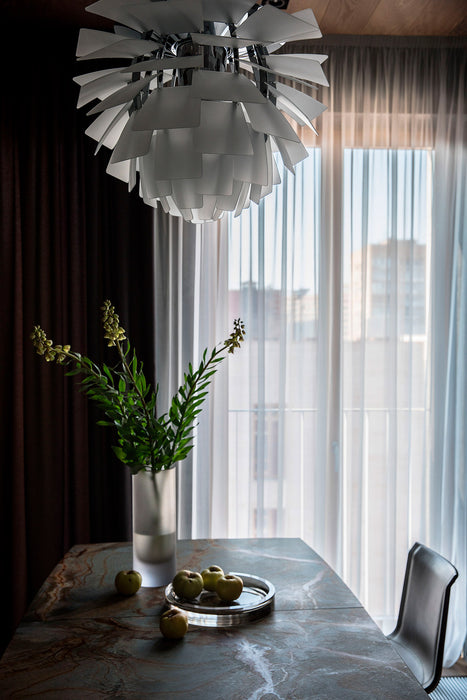

PH Artichoke Glass Ceiling Lamp
The PH Artichoke Glass lamp is a handcrafted piece of sand-blown glass. The soft light it emits diffuses through its leaves to provide a comfortable and pleasant illumination. Whether lit or unlit, the lamp has an "ice-like appearance" that radiates elegance and luminosity to any space.
The PH Artichoke chandelier was designed in 1958 by Poul Henningsen. He originally created it for the Langelinie Pavilionen, a modernist restaurant in Copenhagen, where the PH Artichoke continues to delight diners. It was conceived to be as impressive as a classic chandelier, while providing a beautiful, glare-free light with its sculptural properties.
Its sculptural design and the exceptional light it generates have given this pendant lamp its status as an international design icon. Each of the 72 leaves is carefully assembled in the perfect position, by hand, to ensure that the light is glare-free and the light source cannot be seen from any angle. With its iconic and undeniably timeless design, the PH Artichoke is a beautiful addition to any home.
A design that transcends time and space: that's what makes it an icon.
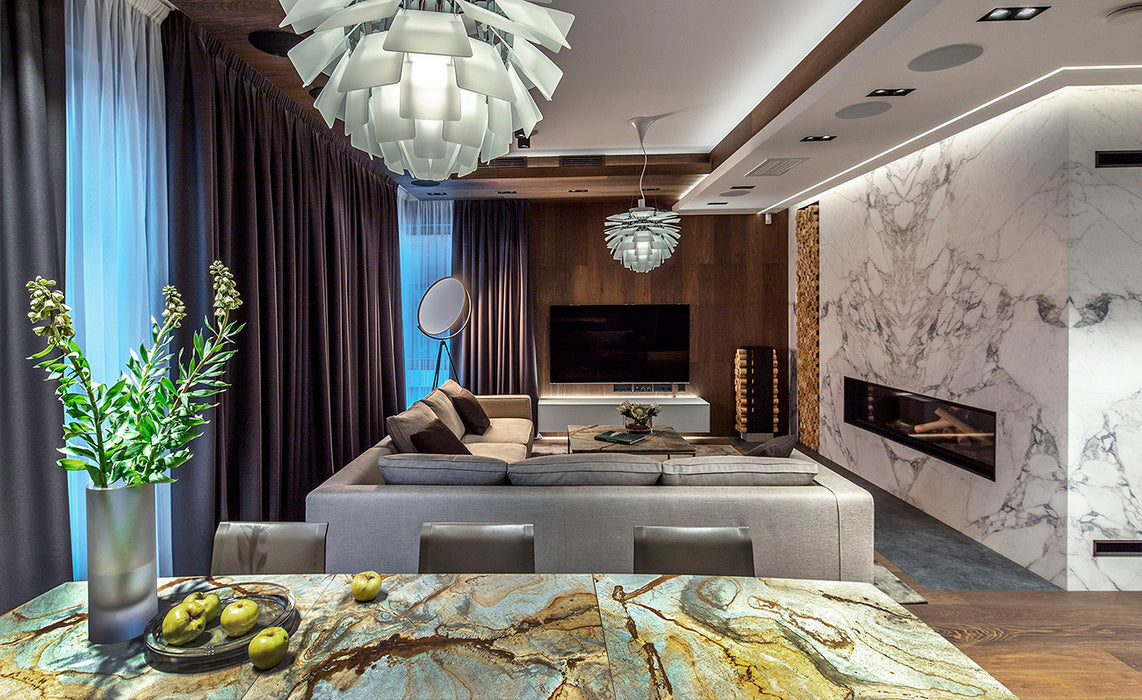

PH Artichoke Glass Ceiling Lamp
The PH Artichoke Glass lamp is a handcrafted piece of sand-blown glass. The soft light it emits diffuses through its leaves to provide a comfortable and pleasant illumination. Whether lit or unlit, the lamp has an "ice-like appearance" that radiates elegance and luminosity to any space.
The PH Artichoke chandelier was designed in 1958 by Poul Henningsen. He originally created it for the Langelinie Pavilionen, a modernist restaurant in Copenhagen, where the PH Artichoke continues to delight diners. It was conceived to be as impressive as a classic chandelier, while providing a beautiful, glare-free light with its sculptural properties.
Its sculptural design and the exceptional light it generates have given this pendant lamp its status as an international design icon. Each of the 72 leaves is carefully assembled in the perfect position, by hand, to ensure that the light is glare-free and the light source cannot be seen from any angle. With its iconic and undeniably timeless design, the PH Artichoke is a beautiful addition to any home.
A design that transcends time and space: that's what makes it an icon.
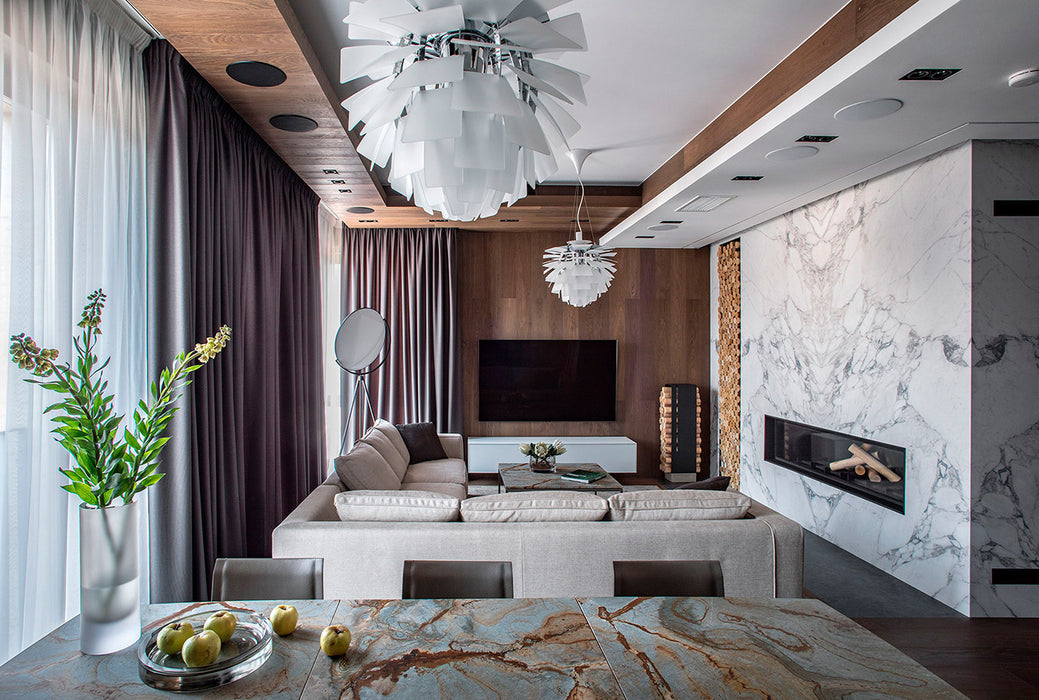

PH Artichoke Glass Ceiling Lamp
The PH Artichoke Glass lamp is a handcrafted piece of sand-blown glass. The soft light it emits diffuses through its leaves to provide a comfortable and pleasant illumination. Whether lit or unlit, the lamp has an "ice-like appearance" that radiates elegance and luminosity to any space.
The PH Artichoke chandelier was designed in 1958 by Poul Henningsen. He originally created it for the Langelinie Pavilionen, a modernist restaurant in Copenhagen, where the PH Artichoke continues to delight diners. It was conceived to be as impressive as a classic chandelier, while providing a beautiful, glare-free light with its sculptural properties.
Its sculptural design and the exceptional light it generates have given this pendant lamp its status as an international design icon. Each of the 72 leaves is carefully assembled in the perfect position, by hand, to ensure that the light is glare-free and the light source cannot be seen from any angle. With its iconic and undeniably timeless design, the PH Artichoke is a beautiful addition to any home.
A design that transcends time and space: that's what makes it an icon.
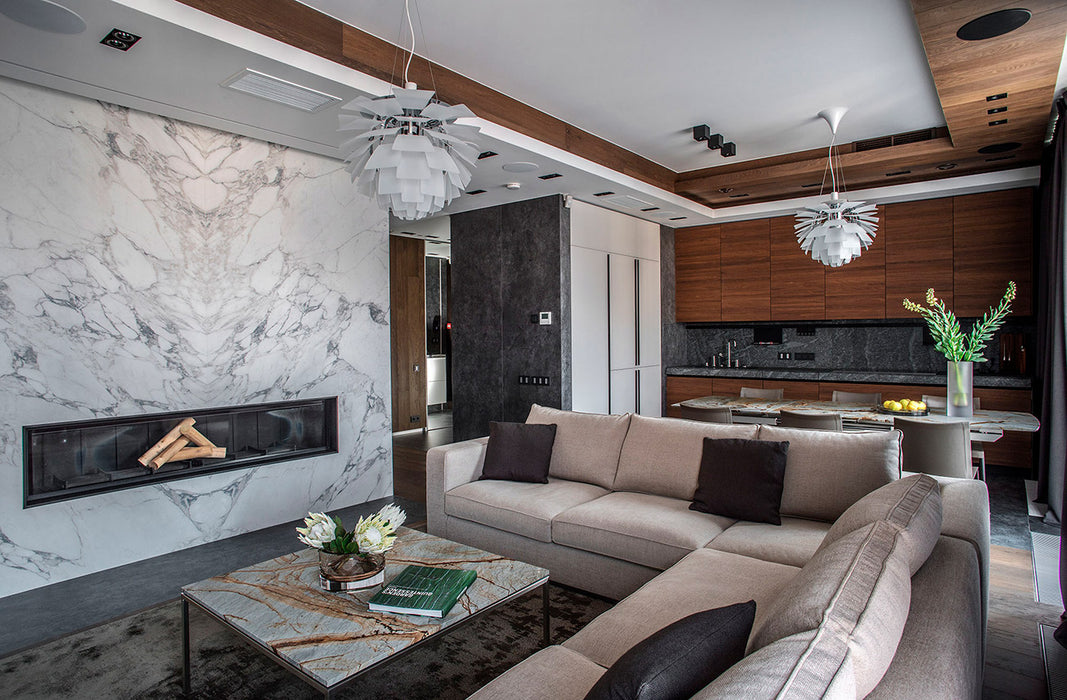

PH Artichoke Glass Ceiling Lamp
The PH Artichoke Glass lamp is a handcrafted piece of sand-blown glass. The soft light it emits diffuses through its leaves to provide a comfortable and pleasant illumination. Whether lit or unlit, the lamp has an "ice-like appearance" that radiates elegance and luminosity to any space.
The PH Artichoke chandelier was designed in 1958 by Poul Henningsen. He originally created it for the Langelinie Pavilionen, a modernist restaurant in Copenhagen, where the PH Artichoke continues to delight diners. It was conceived to be as impressive as a classic chandelier, while providing a beautiful, glare-free light with its sculptural properties.
Its sculptural design and the exceptional light it generates have given this pendant lamp its status as an international design icon. Each of the 72 leaves is carefully assembled in the perfect position, by hand, to ensure that the light is glare-free and the light source cannot be seen from any angle. With its iconic and undeniably timeless design, the PH Artichoke is a beautiful addition to any home.
A design that transcends time and space: that's what makes it an icon.
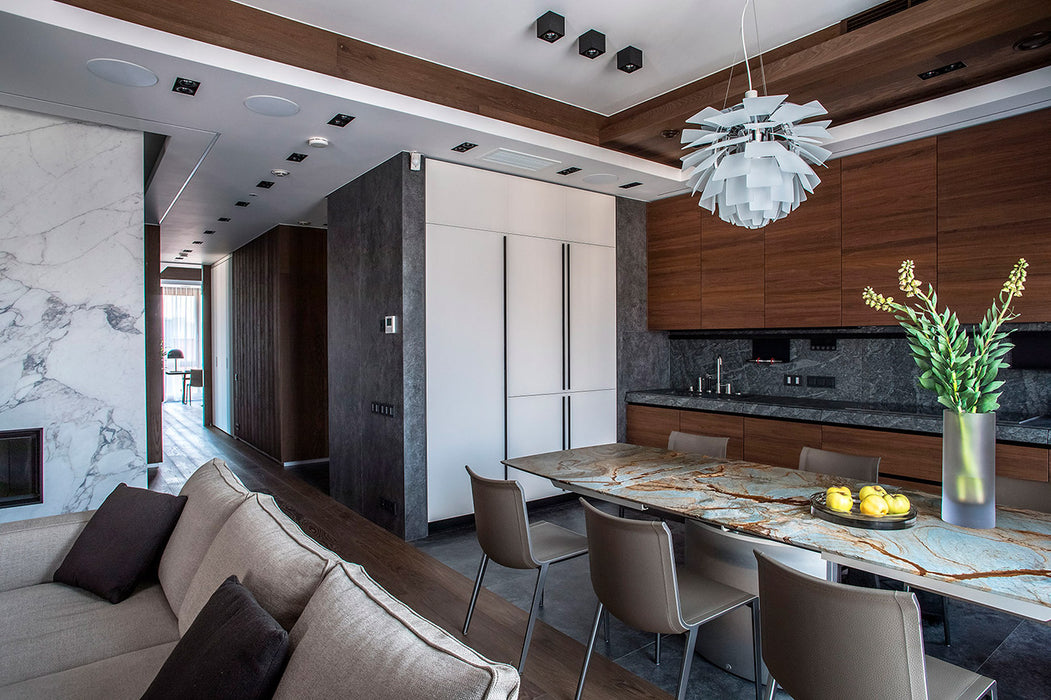

PH Artichoke Glass Ceiling Lamp
The PH Artichoke Glass lamp is a handcrafted piece of sand-blown glass. The soft light it emits diffuses through its leaves to provide a comfortable and pleasant illumination. Whether lit or unlit, the lamp has an "ice-like appearance" that radiates elegance and luminosity to any space.
The PH Artichoke chandelier was designed in 1958 by Poul Henningsen. He originally created it for the Langelinie Pavilionen, a modernist restaurant in Copenhagen, where the PH Artichoke continues to delight diners. It was conceived to be as impressive as a classic chandelier, while providing a beautiful, glare-free light with its sculptural properties.
Its sculptural design and the exceptional light it generates have given this pendant lamp its status as an international design icon. Each of the 72 leaves is carefully assembled in the perfect position, by hand, to ensure that the light is glare-free and the light source cannot be seen from any angle. With its iconic and undeniably timeless design, the PH Artichoke is a beautiful addition to any home.
A design that transcends time and space: that's what makes it an icon.
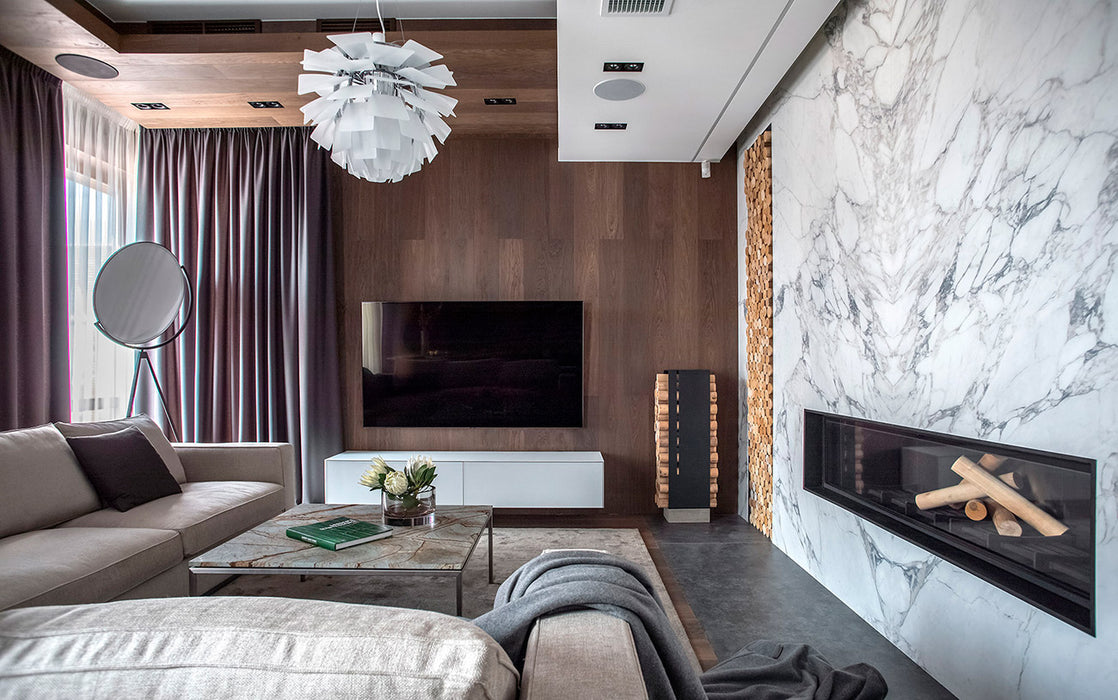

PH Artichoke Glass Ceiling Lamp
The PH Artichoke Glass lamp is a handcrafted piece of sand-blown glass. The soft light it emits diffuses through its leaves to provide a comfortable and pleasant illumination. Whether lit or unlit, the lamp has an "ice-like appearance" that radiates elegance and luminosity to any space.
The PH Artichoke chandelier was designed in 1958 by Poul Henningsen. He originally created it for the Langelinie Pavilionen, a modernist restaurant in Copenhagen, where the PH Artichoke continues to delight diners. It was conceived to be as impressive as a classic chandelier, while providing a beautiful, glare-free light with its sculptural properties.
Its sculptural design and the exceptional light it generates have given this pendant lamp its status as an international design icon. Each of the 72 leaves is carefully assembled in the perfect position, by hand, to ensure that the light is glare-free and the light source cannot be seen from any angle. With its iconic and undeniably timeless design, the PH Artichoke is a beautiful addition to any home.
A design that transcends time and space: that's what makes it an icon.
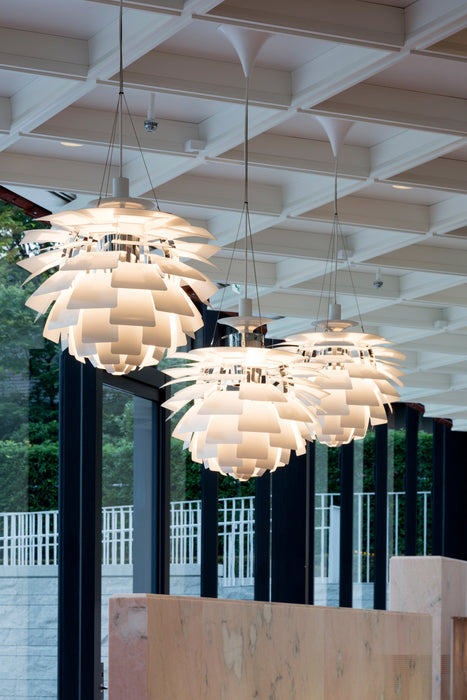

PH Artichoke Ceiling Lamp
The PH Artichoke chandelier was designed in 1958 by Poul Henningsen. He originally created it for the Langelinie Pavilionen, a modernist restaurant in Copenhagen, where the PH Artichoke continues to delight diners. It was conceived to be as impressive as a classic chandelier, while providing a beautiful, glare-free light with its sculptural properties.
Its sculptural design and the exceptional light it generates have given this pendant lamp its status as an international design icon. Each of the 72 leaves is carefully assembled in the perfect position, by hand, to ensure that the light is glare-free and the light source cannot be seen from any angle. With its iconic and undeniably timeless design, the PH Artichoke is a beautiful addition to any home.
A design that transcends time and space: that's what makes it an icon.
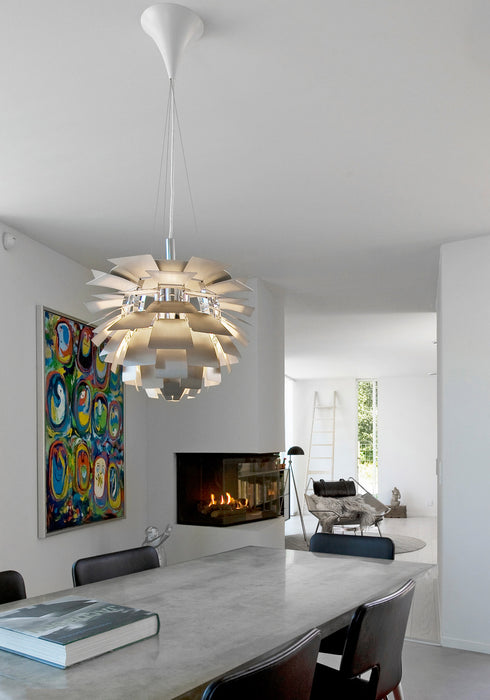

PH Artichoke Ceiling Lamp
The PH Artichoke chandelier was designed in 1958 by Poul Henningsen. He originally created it for the Langelinie Pavilionen, a modernist restaurant in Copenhagen, where the PH Artichoke continues to delight diners. It was conceived to be as impressive as a classic chandelier, while providing a beautiful, glare-free light with its sculptural properties.
Its sculptural design and the exceptional light it generates have given this pendant lamp its status as an international design icon. Each of the 72 leaves is carefully assembled in the perfect position, by hand, to ensure that the light is glare-free and the light source cannot be seen from any angle. With its iconic and undeniably timeless design, the PH Artichoke is a beautiful addition to any home.
A design that transcends time and space: that's what makes it an icon.
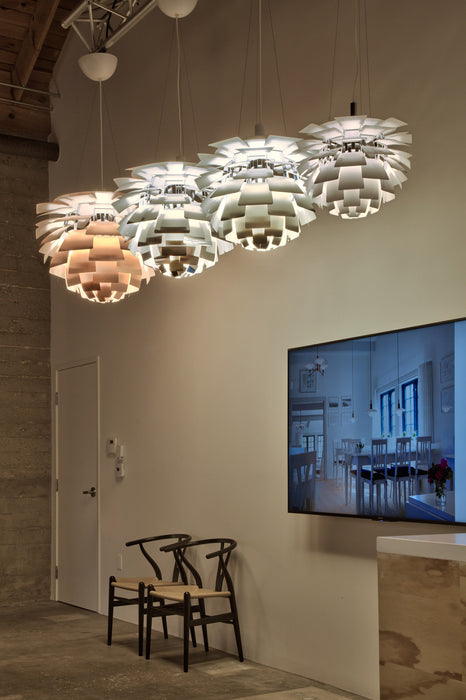

PH Artichoke Ceiling Lamp
The PH Artichoke chandelier was designed in 1958 by Poul Henningsen. He originally created it for the Langelinie Pavilionen, a modernist restaurant in Copenhagen, where the PH Artichoke continues to delight diners. It was conceived to be as impressive as a classic chandelier, while providing a beautiful, glare-free light with its sculptural properties.
Its sculptural design and the exceptional light it generates have given this pendant lamp its status as an international design icon. Each of the 72 leaves is carefully assembled in the perfect position, by hand, to ensure that the light is glare-free and the light source cannot be seen from any angle. With its iconic and undeniably timeless design, the PH Artichoke is a beautiful addition to any home.
A design that transcends time and space: that's what makes it an icon.
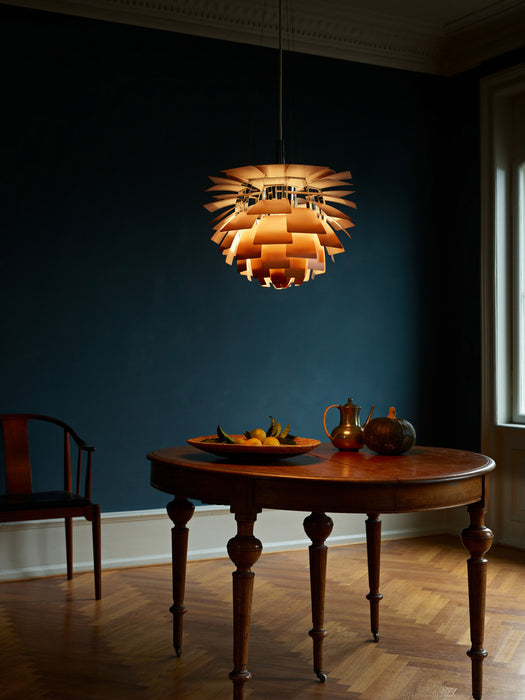

PH Artichoke Ceiling Lamp
The PH Artichoke chandelier was designed in 1958 by Poul Henningsen. He originally created it for the Langelinie Pavilionen, a modernist restaurant in Copenhagen, where the PH Artichoke continues to delight diners. It was conceived to be as impressive as a classic chandelier, while providing a beautiful, glare-free light with its sculptural properties.
Its sculptural design and the exceptional light it generates have given this pendant lamp its status as an international design icon. Each of the 72 leaves is carefully assembled in the perfect position, by hand, to ensure that the light is glare-free and the light source cannot be seen from any angle. With its iconic and undeniably timeless design, the PH Artichoke is a beautiful addition to any home.
A design that transcends time and space: that's what makes it an icon.
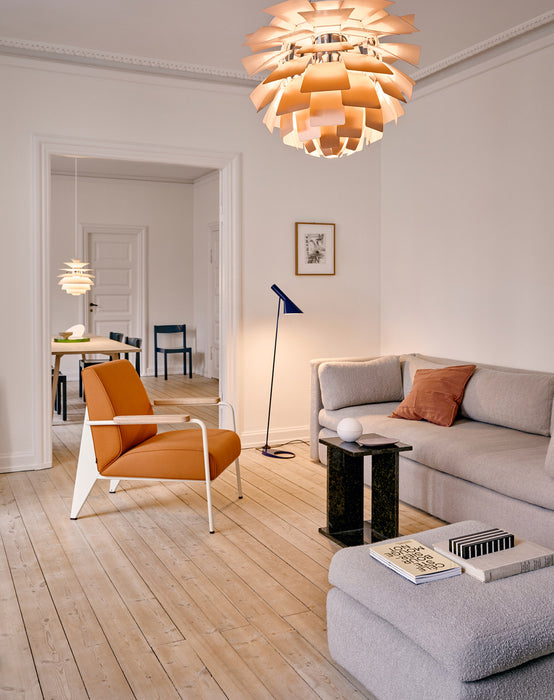

PH Artichoke Ceiling Lamp
The PH Artichoke chandelier was designed in 1958 by Poul Henningsen. He originally created it for the Langelinie Pavilionen, a modernist restaurant in Copenhagen, where the PH Artichoke continues to delight diners. It was conceived to be as impressive as a classic chandelier, while providing a beautiful, glare-free light with its sculptural properties.
Its sculptural design and the exceptional light it generates have given this pendant lamp its status as an international design icon. Each of the 72 leaves is carefully assembled in the perfect position, by hand, to ensure that the light is glare-free and the light source cannot be seen from any angle. With its iconic and undeniably timeless design, the PH Artichoke is a beautiful addition to any home.
A design that transcends time and space: that's what makes it an icon.
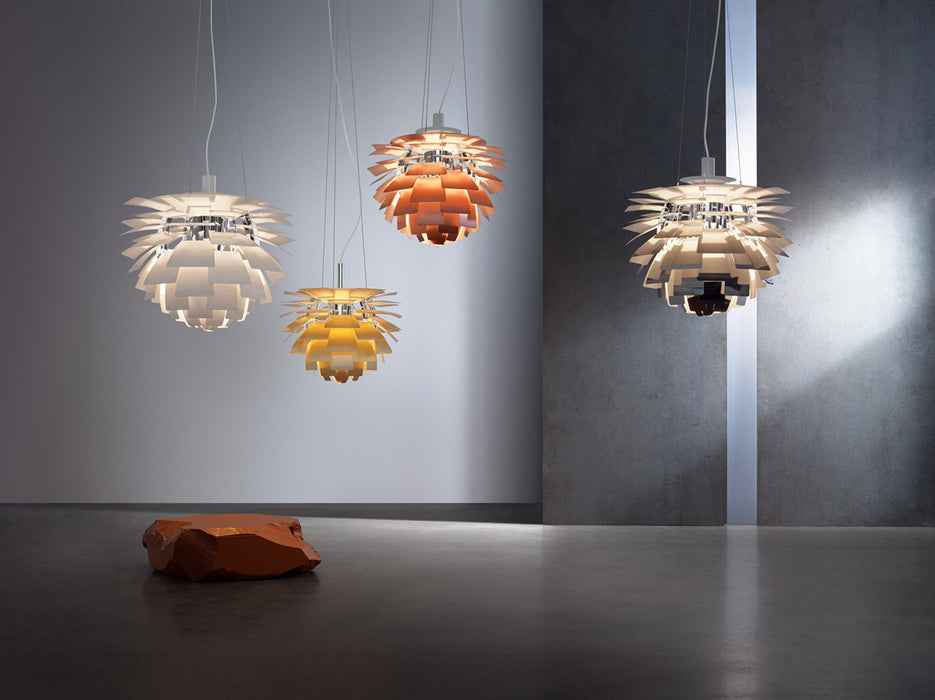

PH Artichoke Ceiling Lamp
The PH Artichoke chandelier was designed in 1958 by Poul Henningsen. He originally created it for the Langelinie Pavilionen, a modernist restaurant in Copenhagen, where the PH Artichoke continues to delight diners. It was conceived to be as impressive as a classic chandelier, while providing a beautiful, glare-free light with its sculptural properties.
Its sculptural design and the exceptional light it generates have given this pendant lamp its status as an international design icon. Each of the 72 leaves is carefully assembled in the perfect position, by hand, to ensure that the light is glare-free and the light source cannot be seen from any angle. With its iconic and undeniably timeless design, the PH Artichoke is a beautiful addition to any home.
A design that transcends time and space: that's what makes it an icon.
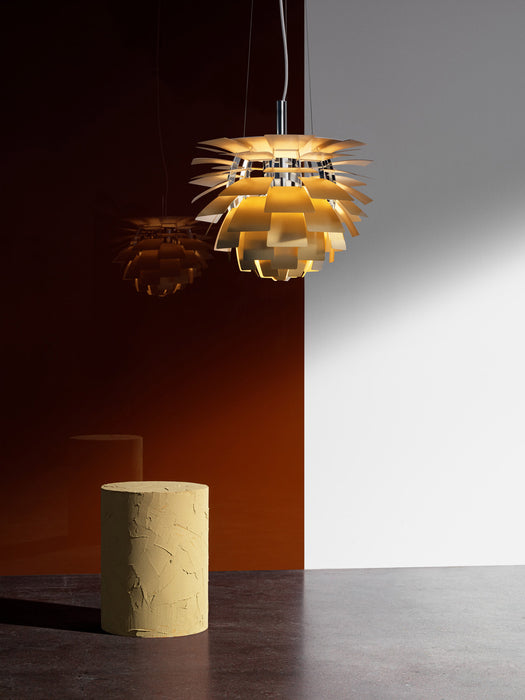

PH Artichoke Ceiling Lamp
The PH Artichoke chandelier was designed in 1958 by Poul Henningsen. He originally created it for the Langelinie Pavilionen, a modernist restaurant in Copenhagen, where the PH Artichoke continues to delight diners. It was conceived to be as impressive as a classic chandelier, while providing a beautiful, glare-free light with its sculptural properties.
Its sculptural design and the exceptional light it generates have given this pendant lamp its status as an international design icon. Each of the 72 leaves is carefully assembled in the perfect position, by hand, to ensure that the light is glare-free and the light source cannot be seen from any angle. With its iconic and undeniably timeless design, the PH Artichoke is a beautiful addition to any home.
A design that transcends time and space: that's what makes it an icon.
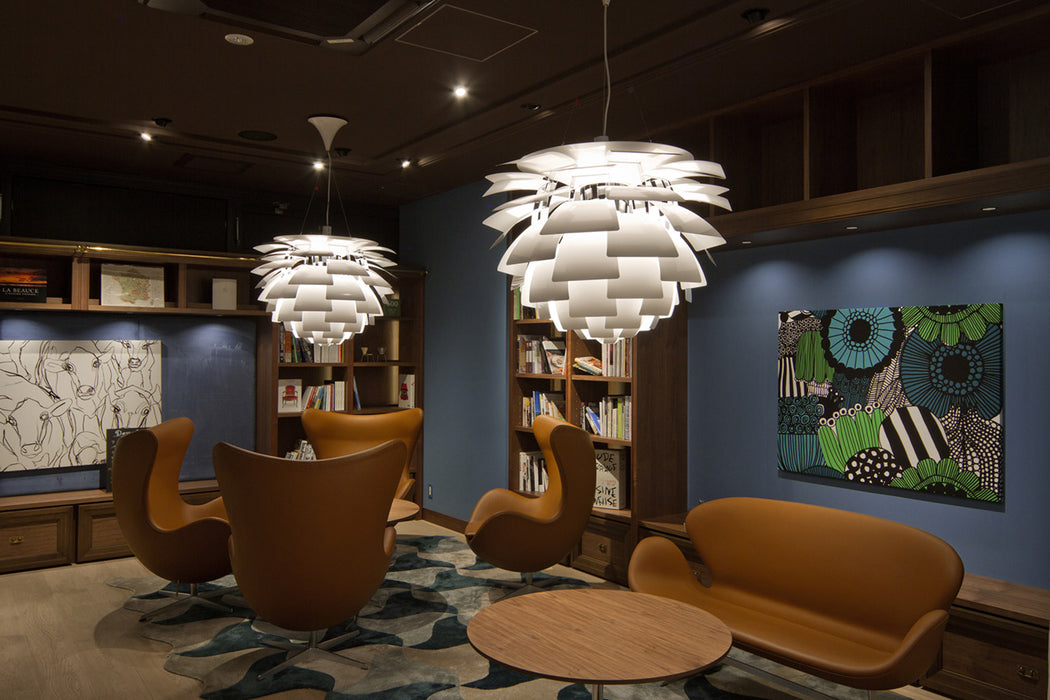

PH Artichoke Ceiling Lamp
The PH Artichoke chandelier was designed in 1958 by Poul Henningsen. He originally created it for the Langelinie Pavilionen, a modernist restaurant in Copenhagen, where the PH Artichoke continues to delight diners. It was conceived to be as impressive as a classic chandelier, while providing a beautiful, glare-free light with its sculptural properties.
Its sculptural design and the exceptional light it generates have given this pendant lamp its status as an international design icon. Each of the 72 leaves is carefully assembled in the perfect position, by hand, to ensure that the light is glare-free and the light source cannot be seen from any angle. With its iconic and undeniably timeless design, the PH Artichoke is a beautiful addition to any home.
A design that transcends time and space: that's what makes it an icon.
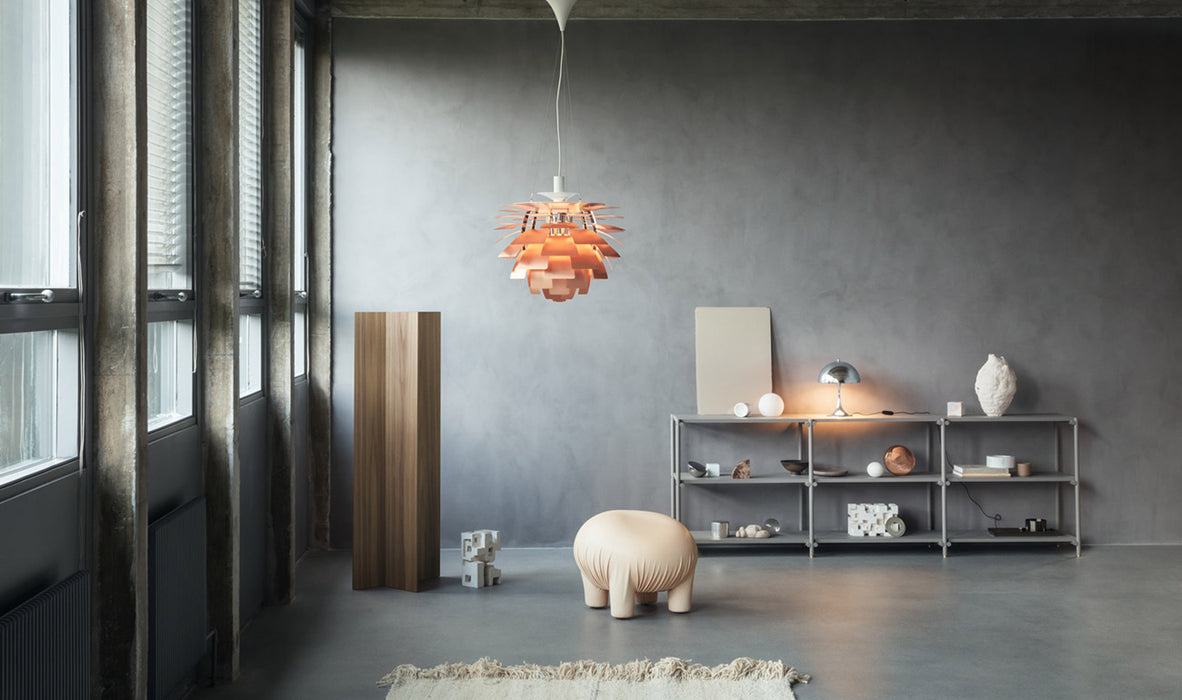

PH Artichoke Ceiling Lamp
The PH Artichoke chandelier was designed in 1958 by Poul Henningsen. He originally created it for the Langelinie Pavilionen, a modernist restaurant in Copenhagen, where the PH Artichoke continues to delight diners. It was conceived to be as impressive as a classic chandelier, while providing a beautiful, glare-free light with its sculptural properties.
Its sculptural design and the exceptional light it generates have given this pendant lamp its status as an international design icon. Each of the 72 leaves is carefully assembled in the perfect position, by hand, to ensure that the light is glare-free and the light source cannot be seen from any angle. With its iconic and undeniably timeless design, the PH Artichoke is a beautiful addition to any home.
A design that transcends time and space: that's what makes it an icon.
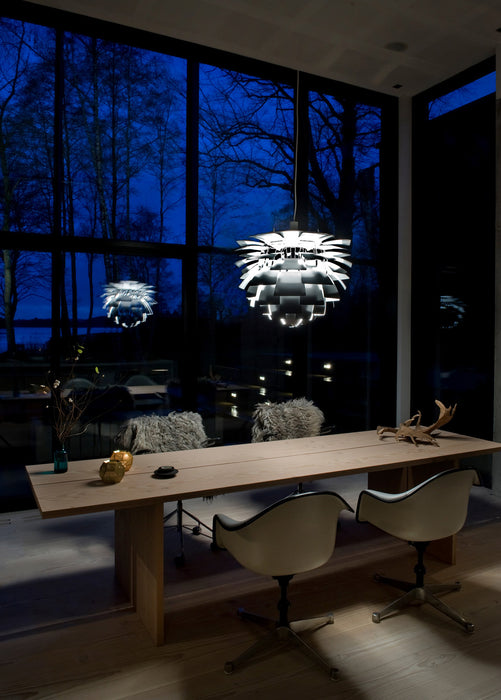

PH Artichoke Ceiling Lamp
The PH Artichoke chandelier was designed in 1958 by Poul Henningsen. He originally created it for the Langelinie Pavilionen, a modernist restaurant in Copenhagen, where the PH Artichoke continues to delight diners. It was conceived to be as impressive as a classic chandelier, while providing a beautiful, glare-free light with its sculptural properties.
Its sculptural design and the exceptional light it generates have given this pendant lamp its status as an international design icon. Each of the 72 leaves is carefully assembled in the perfect position, by hand, to ensure that the light is glare-free and the light source cannot be seen from any angle. With its iconic and undeniably timeless design, the PH Artichoke is a beautiful addition to any home.
A design that transcends time and space: that's what makes it an icon.
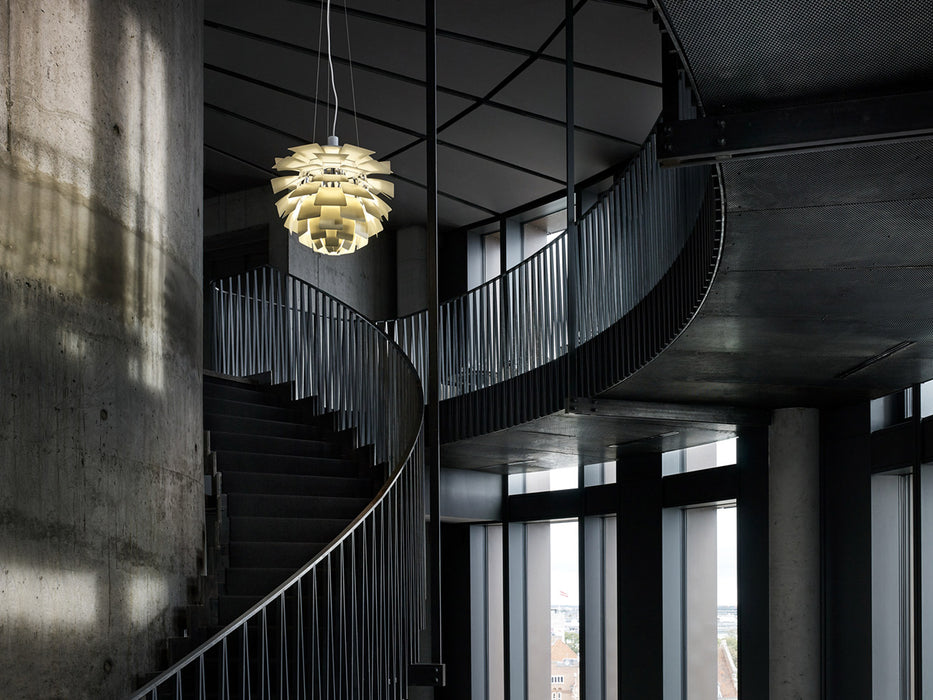

PH Artichoke Ceiling Lamp
The PH Artichoke chandelier was designed in 1958 by Poul Henningsen. He originally created it for the Langelinie Pavilionen, a modernist restaurant in Copenhagen, where the PH Artichoke continues to delight diners. It was conceived to be as impressive as a classic chandelier, while providing a beautiful, glare-free light with its sculptural properties.
Its sculptural design and the exceptional light it generates have given this pendant lamp its status as an international design icon. Each of the 72 leaves is carefully assembled in the perfect position, by hand, to ensure that the light is glare-free and the light source cannot be seen from any angle. With its iconic and undeniably timeless design, the PH Artichoke is a beautiful addition to any home.
A design that transcends time and space: that's what makes it an icon.
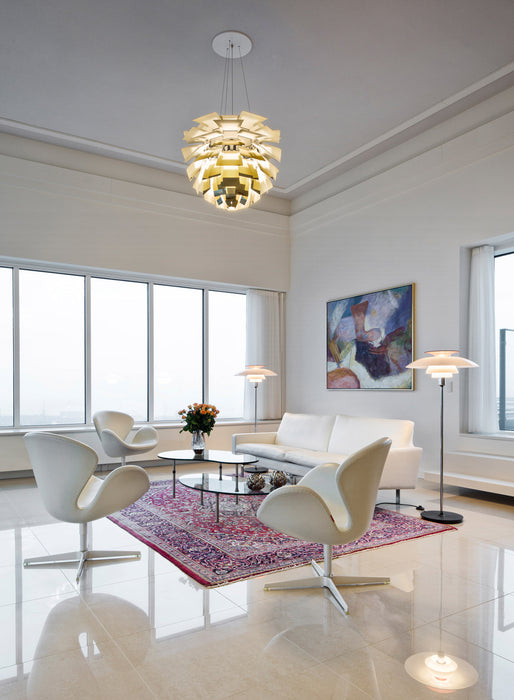

PH Artichoke Ceiling Lamp
The PH Artichoke chandelier was designed in 1958 by Poul Henningsen. He originally created it for the Langelinie Pavilionen, a modernist restaurant in Copenhagen, where the PH Artichoke continues to delight diners. It was conceived to be as impressive as a classic chandelier, while providing a beautiful, glare-free light with its sculptural properties.
Its sculptural design and the exceptional light it generates have given this pendant lamp its status as an international design icon. Each of the 72 leaves is carefully assembled in the perfect position, by hand, to ensure that the light is glare-free and the light source cannot be seen from any angle. With its iconic and undeniably timeless design, the PH Artichoke is a beautiful addition to any home.
A design that transcends time and space: that's what makes it an icon.
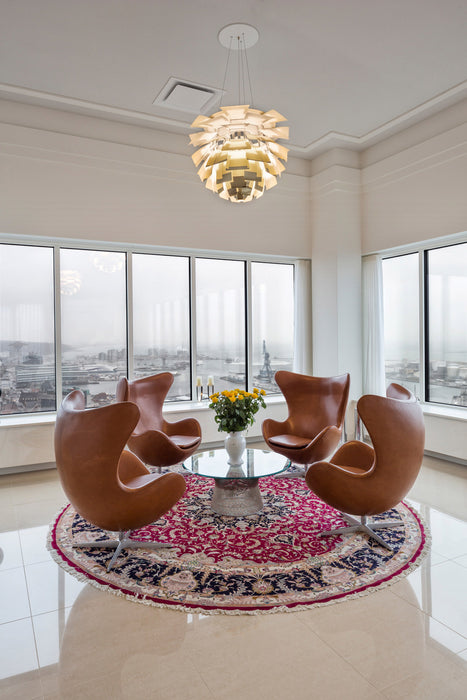

PH Artichoke Ceiling Lamp
The PH Artichoke chandelier was designed in 1958 by Poul Henningsen. He originally created it for the Langelinie Pavilionen, a modernist restaurant in Copenhagen, where the PH Artichoke continues to delight diners. It was conceived to be as impressive as a classic chandelier, while providing a beautiful, glare-free light with its sculptural properties.
Its sculptural design and the exceptional light it generates have given this pendant lamp its status as an international design icon. Each of the 72 leaves is carefully assembled in the perfect position, by hand, to ensure that the light is glare-free and the light source cannot be seen from any angle. With its iconic and undeniably timeless design, the PH Artichoke is a beautiful addition to any home.
A design that transcends time and space: that's what makes it an icon.
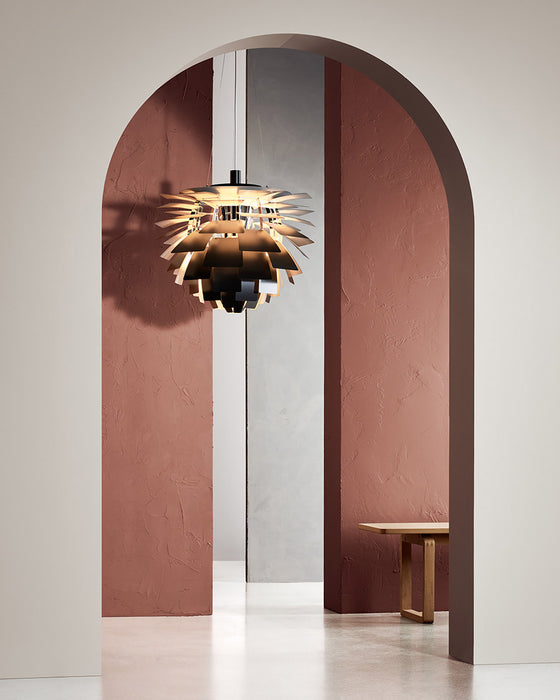

PH Artichoke Ceiling Lamp
The PH Artichoke chandelier was designed in 1958 by Poul Henningsen. He originally created it for the Langelinie Pavilionen, a modernist restaurant in Copenhagen, where the PH Artichoke continues to delight diners. It was conceived to be as impressive as a classic chandelier, while providing a beautiful, glare-free light with its sculptural properties.
Its sculptural design and the exceptional light it generates have given this pendant lamp its status as an international design icon. Each of the 72 leaves is carefully assembled in the perfect position, by hand, to ensure that the light is glare-free and the light source cannot be seen from any angle. With its iconic and undeniably timeless design, the PH Artichoke is a beautiful addition to any home.
A design that transcends time and space: that's what makes it an icon.
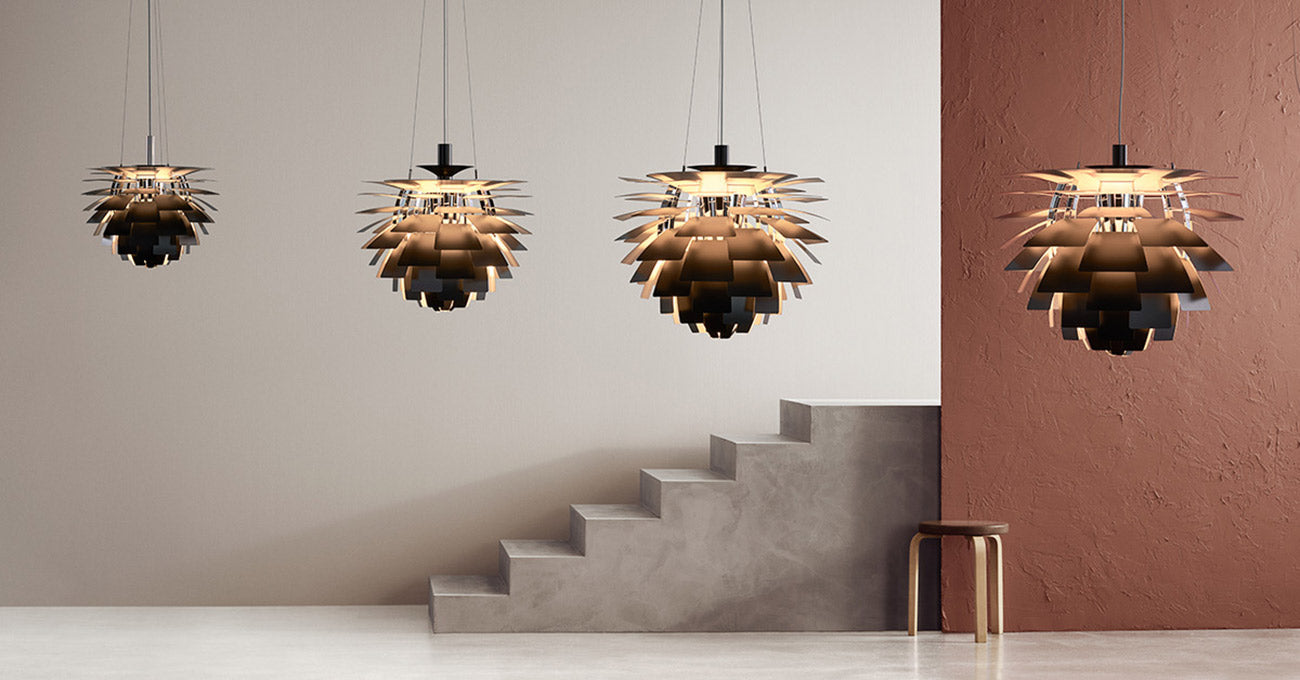

PH Artichoke Ceiling Lamp
The PH Artichoke chandelier was designed in 1958 by Poul Henningsen. He originally created it for the Langelinie Pavilionen, a modernist restaurant in Copenhagen, where the PH Artichoke continues to delight diners. It was conceived to be as impressive as a classic chandelier, while providing a beautiful, glare-free light with its sculptural properties.
Its sculptural design and the exceptional light it generates have given this pendant lamp its status as an international design icon. Each of the 72 leaves is carefully assembled in the perfect position, by hand, to ensure that the light is glare-free and the light source cannot be seen from any angle. With its iconic and undeniably timeless design, the PH Artichoke is a beautiful addition to any home.
A design that transcends time and space: that's what makes it an icon.
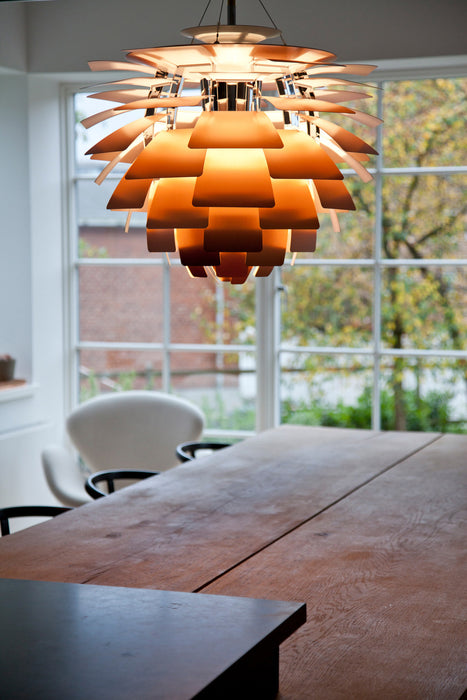

PH Artichoke Ceiling Lamp
The PH Artichoke chandelier was designed in 1958 by Poul Henningsen. He originally created it for the Langelinie Pavilionen, a modernist restaurant in Copenhagen, where the PH Artichoke continues to delight diners. It was conceived to be as impressive as a classic chandelier, while providing a beautiful, glare-free light with its sculptural properties.
Its sculptural design and the exceptional light it generates have given this pendant lamp its status as an international design icon. Each of the 72 leaves is carefully assembled in the perfect position, by hand, to ensure that the light is glare-free and the light source cannot be seen from any angle. With its iconic and undeniably timeless design, the PH Artichoke is a beautiful addition to any home.
A design that transcends time and space: that's what makes it an icon.
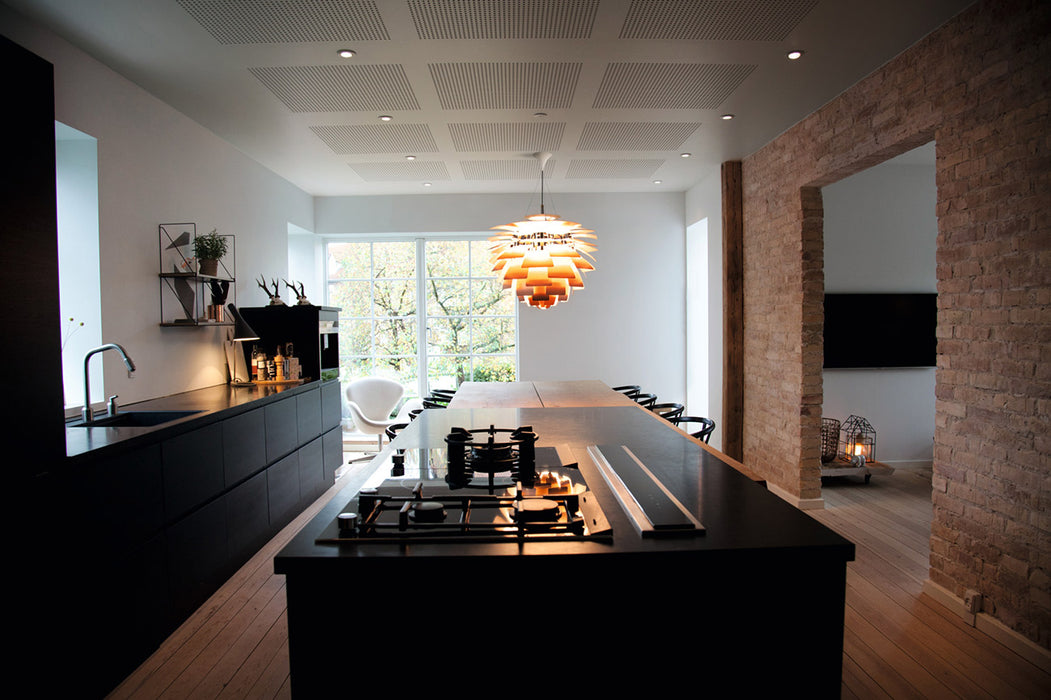

PH Artichoke Ceiling Lamp
The PH Artichoke chandelier was designed in 1958 by Poul Henningsen. He originally created it for the Langelinie Pavilionen, a modernist restaurant in Copenhagen, where the PH Artichoke continues to delight diners. It was conceived to be as impressive as a classic chandelier, while providing a beautiful, glare-free light with its sculptural properties.
Its sculptural design and the exceptional light it generates have given this pendant lamp its status as an international design icon. Each of the 72 leaves is carefully assembled in the perfect position, by hand, to ensure that the light is glare-free and the light source cannot be seen from any angle. With its iconic and undeniably timeless design, the PH Artichoke is a beautiful addition to any home.
A design that transcends time and space: that's what makes it an icon.
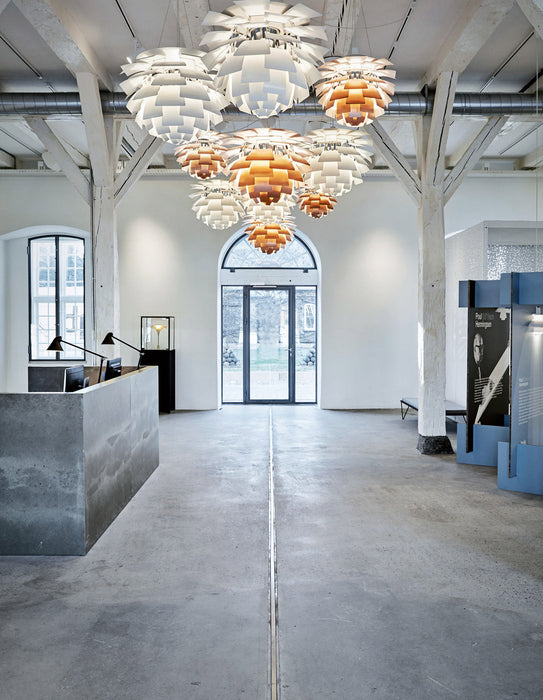

PH Artichoke Ceiling Lamp
The PH Artichoke chandelier was designed in 1958 by Poul Henningsen. He originally created it for the Langelinie Pavilionen, a modernist restaurant in Copenhagen, where the PH Artichoke continues to delight diners. It was conceived to be as impressive as a classic chandelier, while providing a beautiful, glare-free light with its sculptural properties.
Its sculptural design and the exceptional light it generates have given this pendant lamp its status as an international design icon. Each of the 72 leaves is carefully assembled in the perfect position, by hand, to ensure that the light is glare-free and the light source cannot be seen from any angle. With its iconic and undeniably timeless design, the PH Artichoke is a beautiful addition to any home.
A design that transcends time and space: that's what makes it an icon.

PH Artichoke Ceiling Lamp
The PH Artichoke chandelier was designed in 1958 by Poul Henningsen. He originally created it for the Langelinie Pavilionen, a modernist restaurant in Copenhagen, where the PH Artichoke continues to delight diners. It was conceived to be as impressive as a classic chandelier, while providing a beautiful, glare-free light with its sculptural properties.
Its sculptural design and the exceptional light it generates have given this pendant lamp its status as an international design icon. Each of the 72 leaves is carefully assembled in the perfect position, by hand, to ensure that the light is glare-free and the light source cannot be seen from any angle. With its iconic and undeniably timeless design, the PH Artichoke is a beautiful addition to any home.
A design that transcends time and space: that's what makes it an icon.
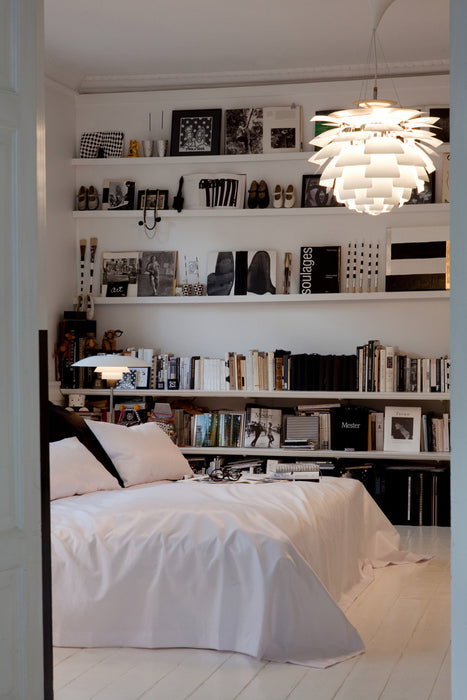

PH Artichoke Ceiling Lamp
The PH Artichoke chandelier was designed in 1958 by Poul Henningsen. He originally created it for the Langelinie Pavilionen, a modernist restaurant in Copenhagen, where the PH Artichoke continues to delight diners. It was conceived to be as impressive as a classic chandelier, while providing a beautiful, glare-free light with its sculptural properties.
Its sculptural design and the exceptional light it generates have given this pendant lamp its status as an international design icon. Each of the 72 leaves is carefully assembled in the perfect position, by hand, to ensure that the light is glare-free and the light source cannot be seen from any angle. With its iconic and undeniably timeless design, the PH Artichoke is a beautiful addition to any home.
A design that transcends time and space: that's what makes it an icon.
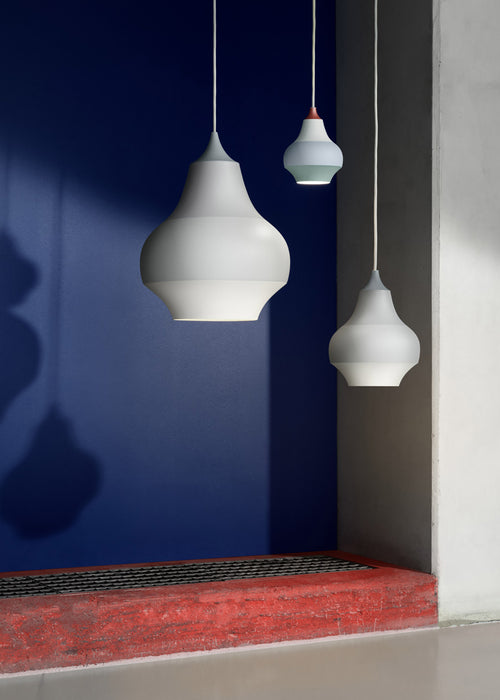

Cirque ceiling lamp
The CIRQUE lamp is a modern and elegant design that perfectly combines functionality and aesthetics. Inspired by the onion-shaped domes of the buildings at Copenhagen's Tivoli amusement park, its rounded, colorful shape creates a warm and inviting atmosphere.
The CIRQUE lamp is made of spun-coated aluminum, giving it great strength and durability. The frosted acrylic diffuser provides soft, diffused light without glare. The lamp is available in a variety of colors, allowing you to choose the one that best suits your decor.
*This product is usually in stock and delivers within 3 to 5 days. Occasionally, some versions may require a delivery time of several weeks. If this is the case, we will notify you immediately.
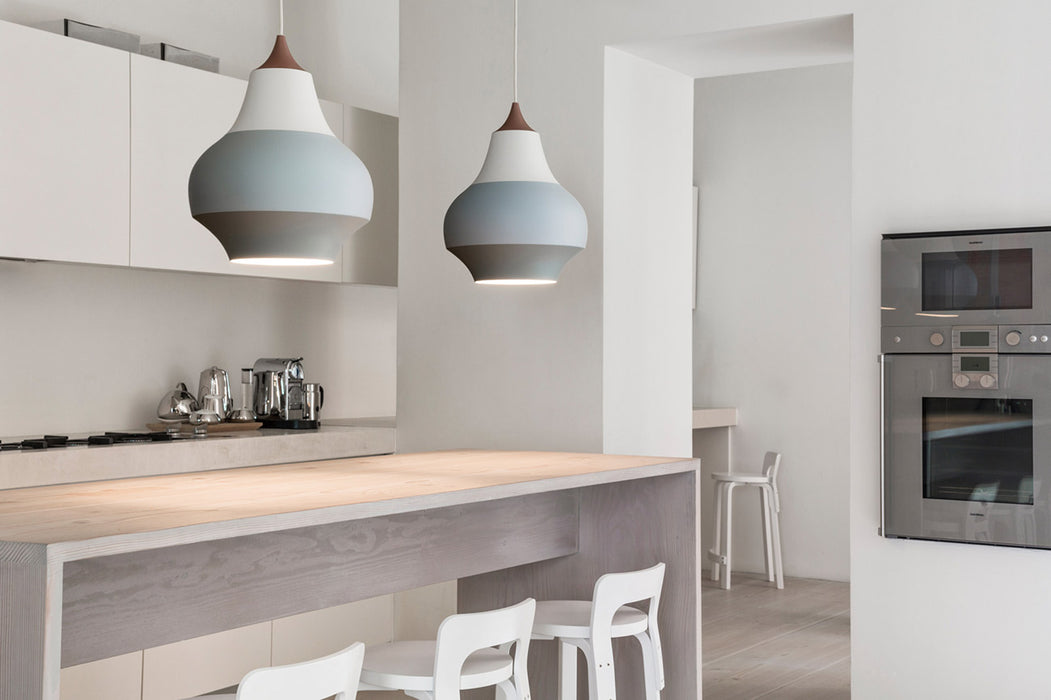

Cirque ceiling lamp
The CIRQUE lamp is a modern and elegant design that perfectly combines functionality and aesthetics. Inspired by the onion-shaped domes of the buildings at Copenhagen's Tivoli amusement park, its rounded, colorful shape creates a warm and inviting atmosphere.
The CIRQUE lamp is made of spun-coated aluminum, giving it great strength and durability. The frosted acrylic diffuser provides soft, diffused light without glare. The lamp is available in a variety of colors, allowing you to choose the one that best suits your decor.
*This product is usually in stock and delivers within 3 to 5 days. Occasionally, some versions may require a delivery time of several weeks. If this is the case, we will notify you immediately.
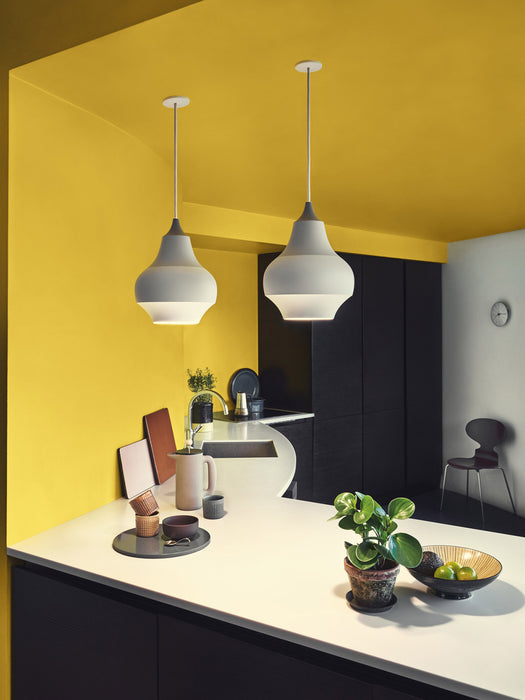

Cirque ceiling lamp
The CIRQUE lamp is a modern and elegant design that perfectly combines functionality and aesthetics. Inspired by the onion-shaped domes of the buildings at Copenhagen's Tivoli amusement park, its rounded, colorful shape creates a warm and inviting atmosphere.
The CIRQUE lamp is made of spun-coated aluminum, giving it great strength and durability. The frosted acrylic diffuser provides soft, diffused light without glare. The lamp is available in a variety of colors, allowing you to choose the one that best suits your decor.
*This product is usually in stock and delivers within 3 to 5 days. Occasionally, some versions may require a delivery time of several weeks. If this is the case, we will notify you immediately.
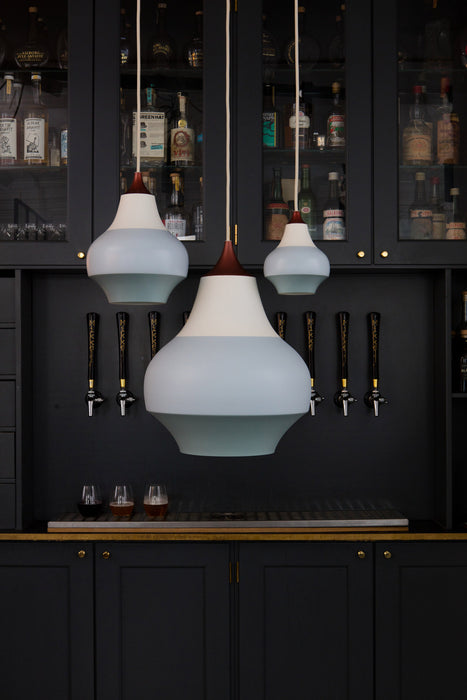

Cirque ceiling lamp
The CIRQUE lamp is a modern and elegant design that perfectly combines functionality and aesthetics. Inspired by the onion-shaped domes of the buildings at Copenhagen's Tivoli amusement park, its rounded, colorful shape creates a warm and inviting atmosphere.
The CIRQUE lamp is made of spun-coated aluminum, giving it great strength and durability. The frosted acrylic diffuser provides soft, diffused light without glare. The lamp is available in a variety of colors, allowing you to choose the one that best suits your decor.
*This product is usually in stock and delivers within 3 to 5 days. Occasionally, some versions may require a delivery time of several weeks. If this is the case, we will notify you immediately.
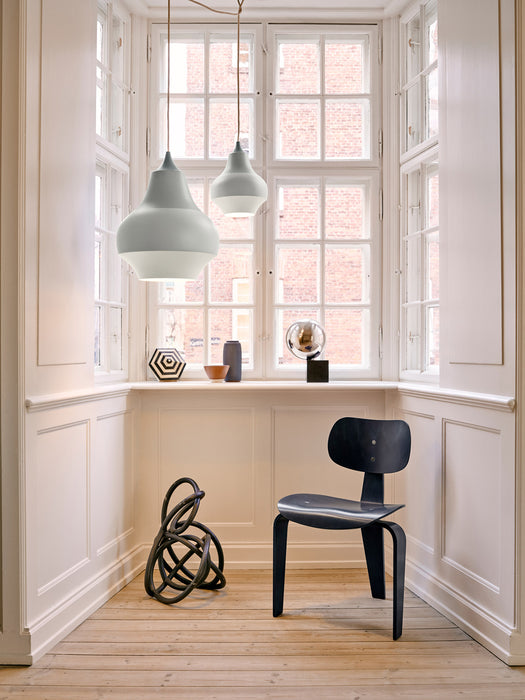

Cirque ceiling lamp
The CIRQUE lamp is a modern and elegant design that perfectly combines functionality and aesthetics. Inspired by the onion-shaped domes of the buildings at Copenhagen's Tivoli amusement park, its rounded, colorful shape creates a warm and inviting atmosphere.
The CIRQUE lamp is made of spun-coated aluminum, giving it great strength and durability. The frosted acrylic diffuser provides soft, diffused light without glare. The lamp is available in a variety of colors, allowing you to choose the one that best suits your decor.
*This product is usually in stock and delivers within 3 to 5 days. Occasionally, some versions may require a delivery time of several weeks. If this is the case, we will notify you immediately.
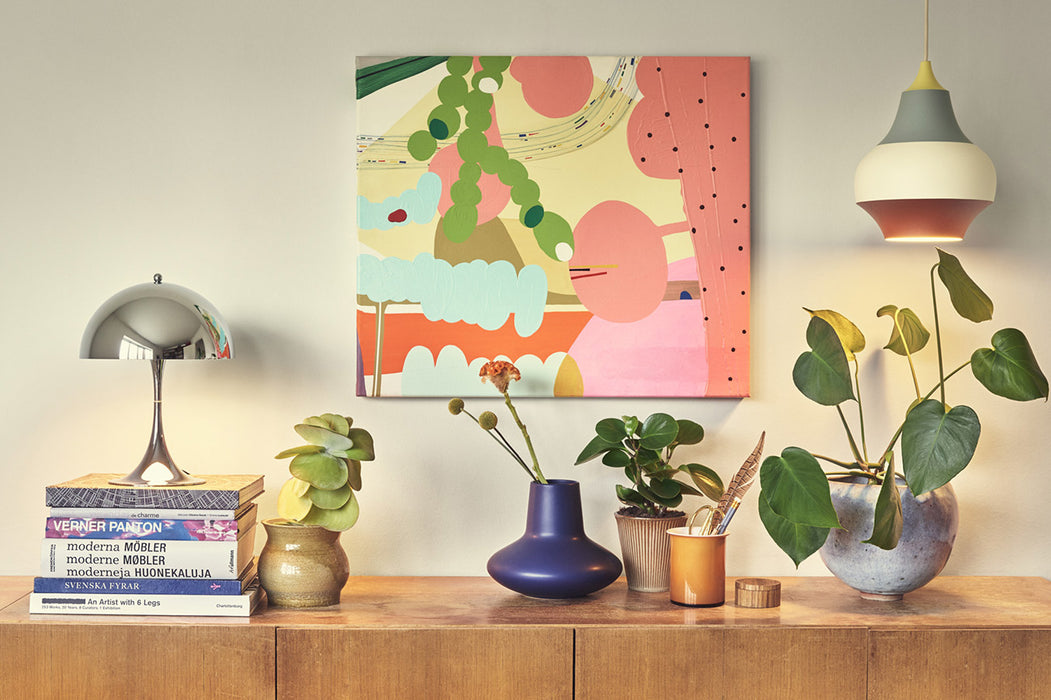

Cirque ceiling lamp
The CIRQUE lamp is a modern and elegant design that perfectly combines functionality and aesthetics. Inspired by the onion-shaped domes of the buildings at Copenhagen's Tivoli amusement park, its rounded, colorful shape creates a warm and inviting atmosphere.
The CIRQUE lamp is made of spun-coated aluminum, giving it great strength and durability. The frosted acrylic diffuser provides soft, diffused light without glare. The lamp is available in a variety of colors, allowing you to choose the one that best suits your decor.
*This product is usually in stock and delivers within 3 to 5 days. Occasionally, some versions may require a delivery time of several weeks. If this is the case, we will notify you immediately.
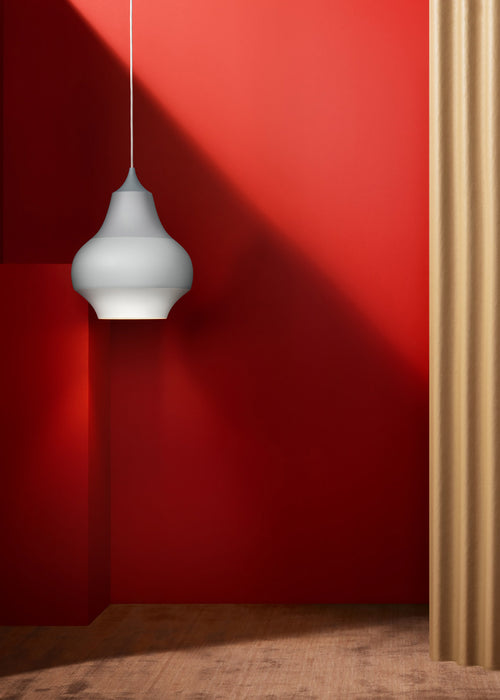

Cirque ceiling lamp
The CIRQUE lamp is a modern and elegant design that perfectly combines functionality and aesthetics. Inspired by the onion-shaped domes of the buildings at Copenhagen's Tivoli amusement park, its rounded, colorful shape creates a warm and inviting atmosphere.
The CIRQUE lamp is made of spun-coated aluminum, giving it great strength and durability. The frosted acrylic diffuser provides soft, diffused light without glare. The lamp is available in a variety of colors, allowing you to choose the one that best suits your decor.
*This product is usually in stock and delivers within 3 to 5 days. Occasionally, some versions may require a delivery time of several weeks. If this is the case, we will notify you immediately.
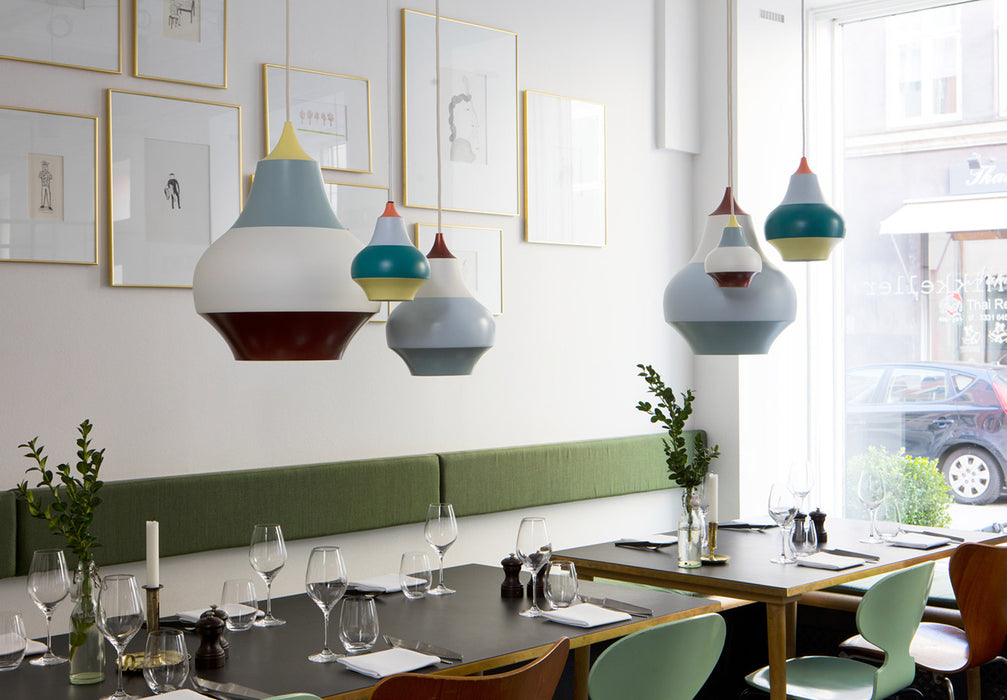

Cirque ceiling lamp
The CIRQUE lamp is a modern and elegant design that perfectly combines functionality and aesthetics. Inspired by the onion-shaped domes of the buildings at Copenhagen's Tivoli amusement park, its rounded, colorful shape creates a warm and inviting atmosphere.
The CIRQUE lamp is made of spun-coated aluminum, giving it great strength and durability. The frosted acrylic diffuser provides soft, diffused light without glare. The lamp is available in a variety of colors, allowing you to choose the one that best suits your decor.
*This product is usually in stock and delivers within 3 to 5 days. Occasionally, some versions may require a delivery time of several weeks. If this is the case, we will notify you immediately.
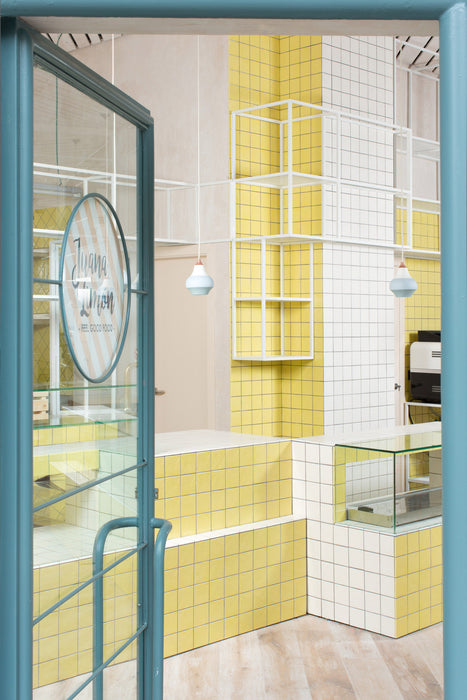

Cirque ceiling lamp
The CIRQUE lamp is a modern and elegant design that perfectly combines functionality and aesthetics. Inspired by the onion-shaped domes of the buildings at Copenhagen's Tivoli amusement park, its rounded, colorful shape creates a warm and inviting atmosphere.
The CIRQUE lamp is made of spun-coated aluminum, giving it great strength and durability. The frosted acrylic diffuser provides soft, diffused light without glare. The lamp is available in a variety of colors, allowing you to choose the one that best suits your decor.
*This product is usually in stock and delivers within 3 to 5 days. Occasionally, some versions may require a delivery time of several weeks. If this is the case, we will notify you immediately.
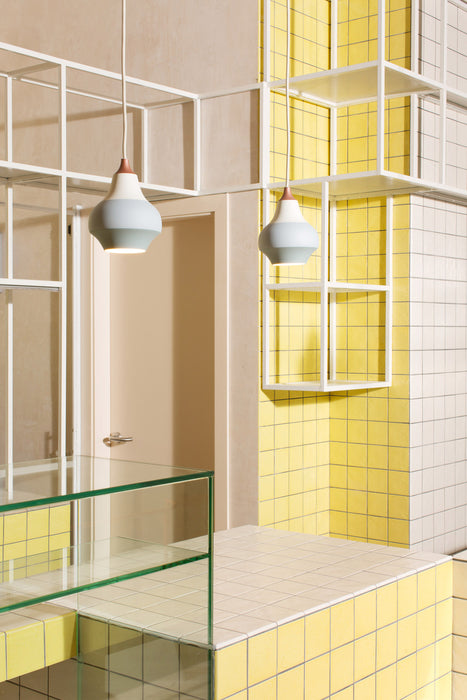

Cirque ceiling lamp
The CIRQUE lamp is a modern and elegant design that perfectly combines functionality and aesthetics. Inspired by the onion-shaped domes of the buildings at Copenhagen's Tivoli amusement park, its rounded, colorful shape creates a warm and inviting atmosphere.
The CIRQUE lamp is made of spun-coated aluminum, giving it great strength and durability. The frosted acrylic diffuser provides soft, diffused light without glare. The lamp is available in a variety of colors, allowing you to choose the one that best suits your decor.
*This product is usually in stock and delivers within 3 to 5 days. Occasionally, some versions may require a delivery time of several weeks. If this is the case, we will notify you immediately.
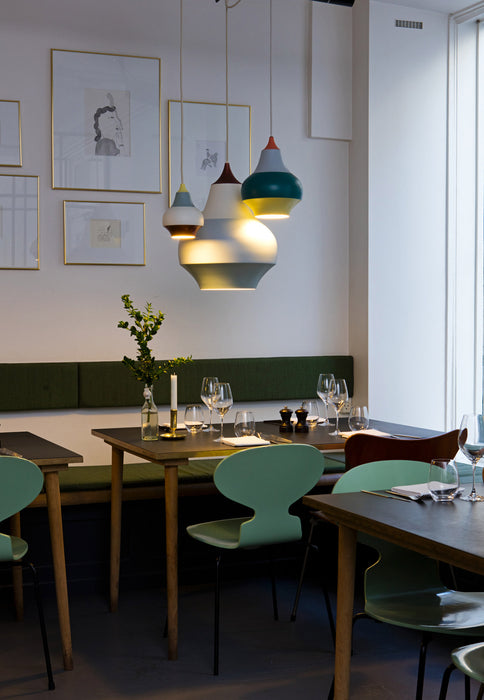

Cirque ceiling lamp
The CIRQUE lamp is a modern and elegant design that perfectly combines functionality and aesthetics. Inspired by the onion-shaped domes of the buildings at Copenhagen's Tivoli amusement park, its rounded, colorful shape creates a warm and inviting atmosphere.
The CIRQUE lamp is made of spun-coated aluminum, giving it great strength and durability. The frosted acrylic diffuser provides soft, diffused light without glare. The lamp is available in a variety of colors, allowing you to choose the one that best suits your decor.
*This product is usually in stock and delivers within 3 to 5 days. Occasionally, some versions may require a delivery time of several weeks. If this is the case, we will notify you immediately.
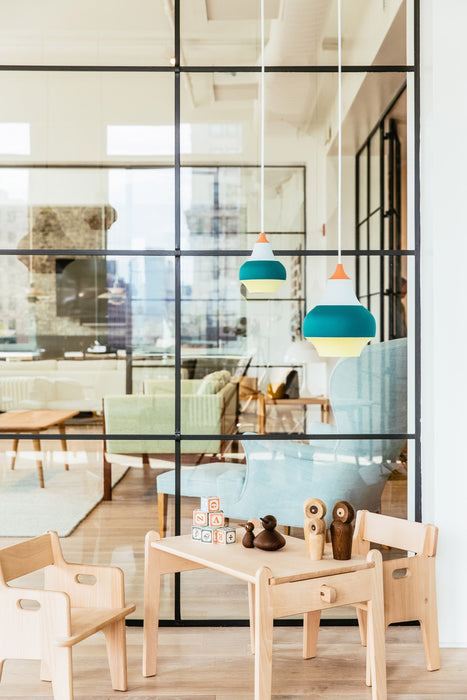

Cirque ceiling lamp
The CIRQUE lamp is a modern and elegant design that perfectly combines functionality and aesthetics. Inspired by the onion-shaped domes of the buildings at Copenhagen's Tivoli amusement park, its rounded, colorful shape creates a warm and inviting atmosphere.
The CIRQUE lamp is made of spun-coated aluminum, giving it great strength and durability. The frosted acrylic diffuser provides soft, diffused light without glare. The lamp is available in a variety of colors, allowing you to choose the one that best suits your decor.
*This product is usually in stock and delivers within 3 to 5 days. Occasionally, some versions may require a delivery time of several weeks. If this is the case, we will notify you immediately.

